Paul van Yperen's Blog, page 73
September 27, 2023
Fritz Kortner
Austrian-born stage and film actor and theatre director Fritz Kortner (1892–1970) was one of the best-known character actors of German silent cinema. His speciality was playing sinister and threatening roles.
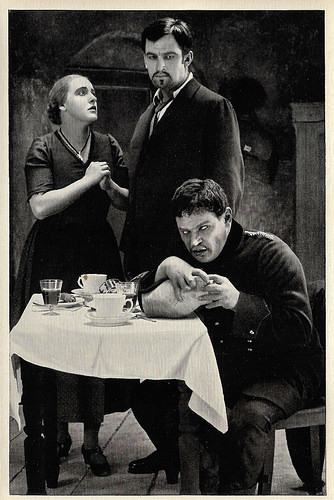
German collectors card by Ross Verlag in the series Vom Werden deutscher Filmkunst - Der Stumme Film, picture no. 102. Photo: Ufa. Publicity still for Hintertreppe/Backstairs (Leopold Jessner, Paul Leni, 1921) with Henny Porten and Wilhelm Dieterle .
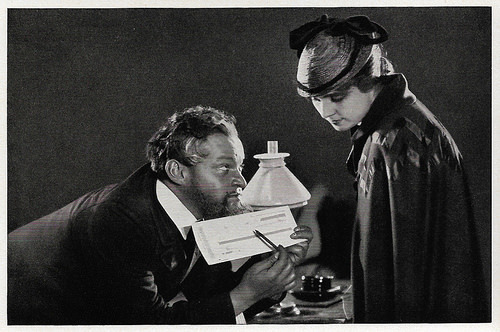
German collectors card by Ross Verlag in the series Vom Werden deutscher Filmkunst - Der Stumme Film, picture no. 99, group 43. Photo: Ufa. Publicity still for Nora (Berthold Viertel, 1923) with Olga Tschechova .
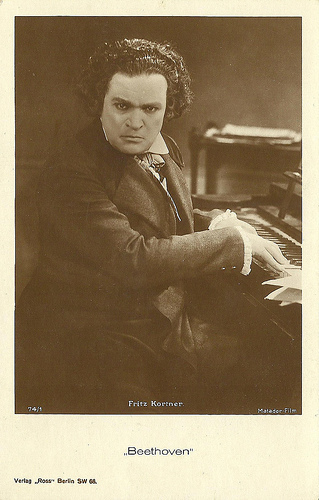
German postcard by Ross Verlag, Berlin, no. 74/1, 1925-1935. Photo: Matador-Film. Publicity still for Das Leben des Beethoven/The Life of the Beethoven (Hans Otto, 1927).
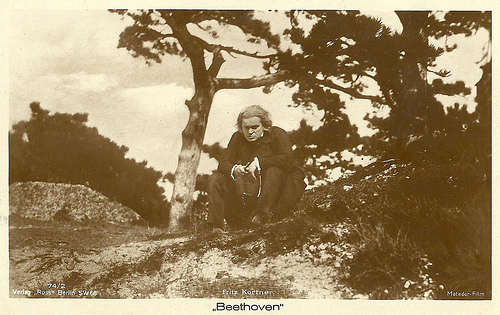
German postcard by Ross Verlag, Berlin, no. 74/2, 1925-1935. Photo: Matador-Film. Publicity still for Das Leben des Beethoven/The Life of the Beethoven (Hans Otto, 1927). Collection: Didier Hanson.

Italian postcard, no. 341. Photo: Dist. S.A. Pittaluga. Francesca Bertini and Fritz Kortner in Mein Leben für das Deine/My life for yours (Luitz-Morat, 1928), an adaptation of the play Odette by Victorien Sardou.
Unfit for the front
Fritz Kortner was born Fritz Nathan Kohn in Vienna, Austria, in 1892. He studied at the Vienna Academy of Music and Dramatic Art, an academy at the Burgtheater. After graduating, he received his first engagement at the National Theatre Mannheim. In 1911, he joined Max Reinhardt at the Deutsches Theater in Berlin. There he played only minor roles, and soon he moved again. These were wander years for the actor, hopping from stage to stage. At the outbreak of the First World War, he was called up for military service. However, he was soon written off as unfit for the front.
In 1915 he made his first film appearances in a series of adventure films directed and produced by Harry Piel , including Manya, die Türkin/Manya, the Turkish Woman (Harry Piel, 1915). During the war, he also appeared in such films as Der Märtyrer seines Herzens/The Martyr of his Heart (Emil Justitz, 1918) as Ludwig von Beethoven, Der Sonnwendhof/The Sonnwendhof (Emil Leyde, 1918) and Frauenehre/Honour of a woman (Georg Kundert, 1918), in which his expressionistic acting style first came into its own.
On stage, his roles became more important, and in 1919 he had his breakthrough with his performance in the play Die Wandlung (the Conversion) by Ernst Toller at Die Tribüne in Berlin. Then director Leopold Jessner committed him to the Staatstheater and made him one of his principal actors. Kortner appeared in many plays by Schiller, Büchner and William Shakespeare under the direction of Jessner.
His Shylock in The Merchant of Venice became his most famous role. It made him one of the great stars of the German stage in the 1920s, with a new form of theatre: Expressionism. His speciality was playing sinister and threatening roles. He also intensified his activities in the cinema, where he also excelled in expressionist works with his demonically subtle acting, such as in Satanas/Satan (F.W. Murnau, 1920) opposite Ernst Hoffmann , Die Nacht der Königin Isabeau/The Night of Queen Isabeau (Robert Wiene, 1920) starring Fern Andra , and the thriller Schatten/Warning Shadows (Arthur Robison, 1923) with Alexander Granach.
Another early classic was the drama Hintertreppe/Backstairs (Leopold Jessner, Paul Leni, 1921) in which he played a crippled mailman in love with a maid ( Henny Porten ) who lives in the same poor apartment building. In 1924 Kortner married the actress Johanna Hofer, and they stayed together till his death. That year he played the role of the villain in the Austrian silent horror classic Orlacs Hände/Orlac’s Hands (Robert Wiene, 1924) opposite Conrad Veidt . He proved his versatility with completely different parts in two other classics, as Dr. Ludwig Schön in Die Büchse der Pandora/Pandora’s Box (Georg Wilhelm Pabst, 1929) featuring Louise Brooks , and the title role in the early sound film Dreyfus/The Dreyfus Case (Richard Oswald, 1930) with Heinrich George .
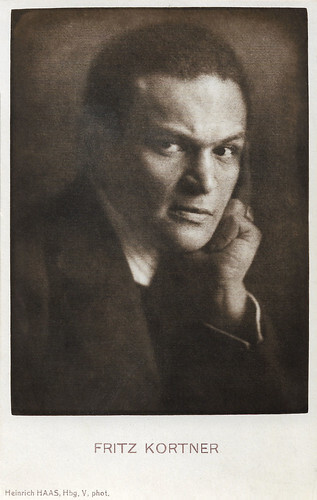
German postcard. Photo: Heinrich Haas, Hamburg.
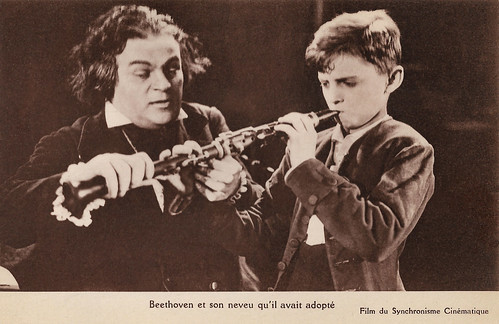
French postcard. Photo: Film du Synchronisme Cinématique. Fritz Kortner in Das Leben des Beethoven/The Life of the Beethoven (Hans Otto, 1927). Caption: Beethoven and his adopted nephew.

Danish postcard by Alex. Vincent's Kunstforlag, Eneret, no. 254. Photo: publicity still for Revolutionshochzeit/ Revolutionsbryllup/ The Last Night (A.W. Sandberg, 1928). This was a German-Danish dramatization of Sophus Michaëlis' play Revolutionshochzeit (Revolutionary Wedding), with also Karina Bell, Walter Rilla and Fritz Kortner, and produced by Terra-Filmkunst. This card shows left Ekman and Bell and in the back Fritz Kortner as the Jacobine Monteloup, and right Jacobini whose character, the aristocratic Alaine, has changed clothes with her maid Leontine (Bell) to get a pass to leave Paris.
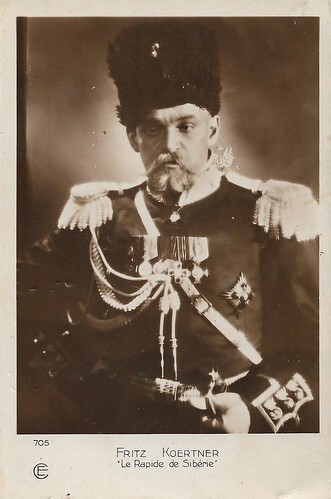
French postcard by Cinémagazine-Edition, no. 705. Photo: Erda-Film. Fritz Kortner in the late silent film Die Nacht des Schreckens (Gennaro Righelli, 1929), released in France as Le Rapide de Sibérie.
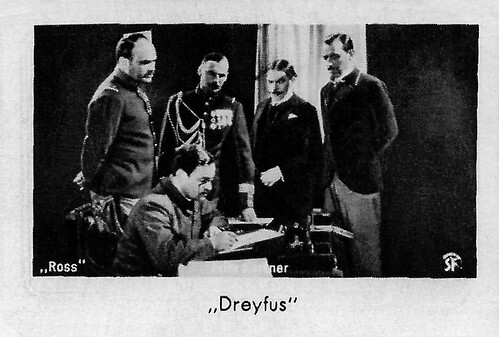
German collectors card by Ross Verlag. Photo: SF (Süd-Film). Fritz Kortner in Dreyfus/The Dreyfus Case (Richard Oswald, 1930).
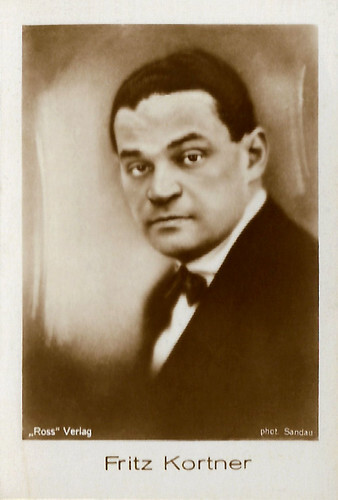
German cigarette card by Ross Verlag for A. Batschari Cigarettenfabrik, Baden-Baden, for its Mercedes cigarettes, no. 461. Photo: Sandau.
The attack
During the turbulent times in the early 1930s, the Jewish Fritz Kortner decided to install his residence in Ascona. In late 1932 he was attacked in the Nazi propaganda sheet Der Angriff (The Attack): "One had chosen for the role in 'Gott, Kaiser und Bauer' (1932, God, Emperor and Farmer) the Jew Kortner-Kohn, who actually should have stopped playing in the Berlin theatre scene long ago. He is pretty much the worst and grubbiest type who has ever been on a German stage.”
When Adolf Hitler came to power in 1933, Kortner, was on a tour through Scandinavia and Eastern Europe. He decided not to return to Germany. Over Czechoslovakia, then to Vienna - where he performed at Max Reinhardt ’s Theater in der Josefstadt – to Paris, the Kortner family then emigrated to Great Britain, where Fritz Kortner could appear in films again. Among his British films are Chu Chin Chow (Walter Forde, 1934) with Anna May Wong , and Abdul the Damned (Karl Grune, 1935) with Nils Asther .
In 1937, he emigrated to the United States, where he found work as a character actor and theatre director. In 1938 followed his family, and they moved on to Hollywood. Here he worked on scripts. Until his return to Europe in 1947 he starred in nine films such as The Hitler Gang (John Farrow, 1944). However, they were not very convincing artistically. After his return to Germany, he became noted for his innovative staging and direction. His artistic homes were the Münchener Kammerspiele under Hans Schweikart and the Schillertheater in Berlin under Boleslaw Barlog. A classic became his direction of Richard III (1964) in which the king crawls over piles of corpses at the end. At the Kammerspiele, he directed seventeen plays until 1967.
He also appeared in some interesting films, such as Der Ruf/The Last Illusion (Josef von Báky, 1949) with Johanna Hofer, and the suspenseful drama-thriller Epilog: Das Geheimnis der Orplid/Epilogue (Helmut Käutner, 1950). In the 1960s, Kortner started to direct at the Burgtheater in his native Vienna. He directed his last play, Emilia Galotti with Klaus Maria Brandauer, in April 1970, at the Viennese Theater in der Josefstadt.
Three months later, Fritz Kortner died of cancer in Munich, aged 78. Kortner’s style of interpretation and rehearsal influenced a new generation of directors. Particularly noteworthy are Peter Stein and Jürgen Flimm, who both have been assistant directors of Kortner.
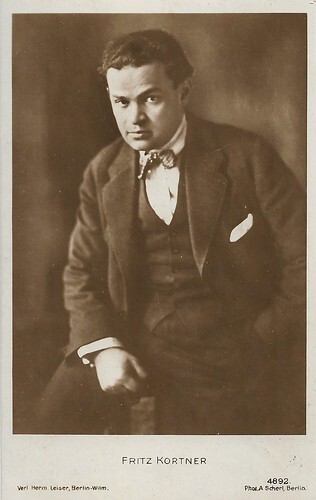
German postcard by Verlag Hermann Leiser, no. 4892. Photo: A. Scherl, Berlin.
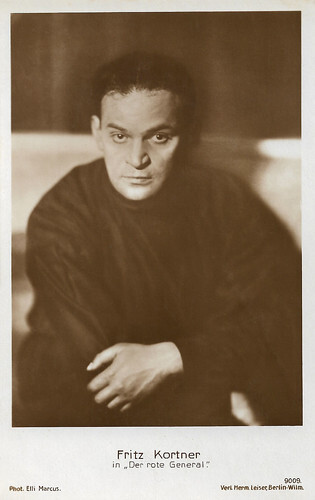
German postcard by Verlag Herm. Leiser, Berlin-Wilm., no. 9009. Photo: Eli Marcus. Fritz Kortner in the play 'Der rote General' (1928) by Hermann Ungar.
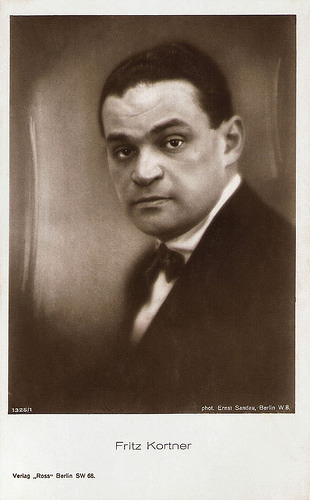
German postcard by Ross Verlag, no. 1325/1, 1927-1928. Photo: Ernst Sandau, Berlin.
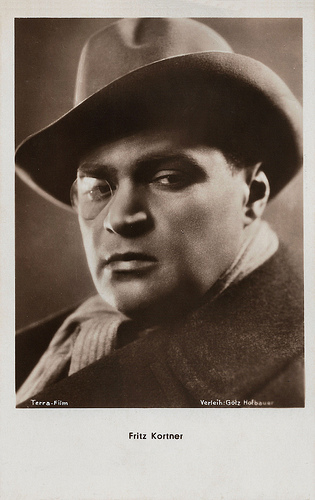
Austrian postcard by Iris Verlag, no. 6037. Photo: Terra Film / Götz Hofbauer.
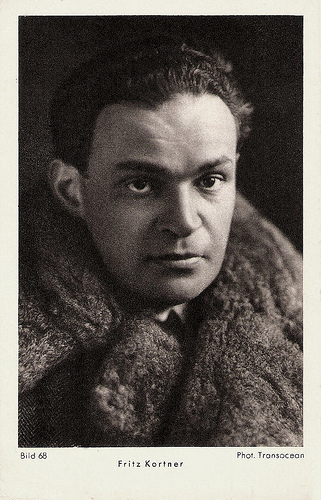
German postcard by Margarinewerk Eidelstedt Gebr. Fauser G.m.b.H., Holstein, Serie 1, no. Bild 68. Photo: Transocean.
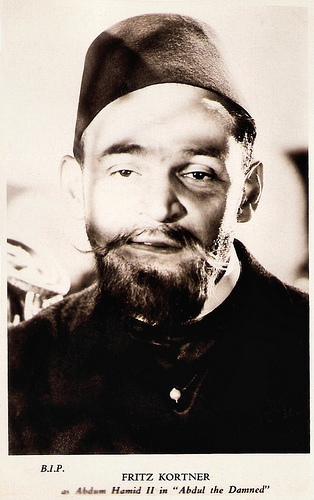
British card. Photo: B.I.P. Publicity still for Abdul the Damned (1935).
Sources: Wikipedia (English and German) and .

German collectors card by Ross Verlag in the series Vom Werden deutscher Filmkunst - Der Stumme Film, picture no. 102. Photo: Ufa. Publicity still for Hintertreppe/Backstairs (Leopold Jessner, Paul Leni, 1921) with Henny Porten and Wilhelm Dieterle .

German collectors card by Ross Verlag in the series Vom Werden deutscher Filmkunst - Der Stumme Film, picture no. 99, group 43. Photo: Ufa. Publicity still for Nora (Berthold Viertel, 1923) with Olga Tschechova .

German postcard by Ross Verlag, Berlin, no. 74/1, 1925-1935. Photo: Matador-Film. Publicity still for Das Leben des Beethoven/The Life of the Beethoven (Hans Otto, 1927).

German postcard by Ross Verlag, Berlin, no. 74/2, 1925-1935. Photo: Matador-Film. Publicity still for Das Leben des Beethoven/The Life of the Beethoven (Hans Otto, 1927). Collection: Didier Hanson.

Italian postcard, no. 341. Photo: Dist. S.A. Pittaluga. Francesca Bertini and Fritz Kortner in Mein Leben für das Deine/My life for yours (Luitz-Morat, 1928), an adaptation of the play Odette by Victorien Sardou.
Unfit for the front
Fritz Kortner was born Fritz Nathan Kohn in Vienna, Austria, in 1892. He studied at the Vienna Academy of Music and Dramatic Art, an academy at the Burgtheater. After graduating, he received his first engagement at the National Theatre Mannheim. In 1911, he joined Max Reinhardt at the Deutsches Theater in Berlin. There he played only minor roles, and soon he moved again. These were wander years for the actor, hopping from stage to stage. At the outbreak of the First World War, he was called up for military service. However, he was soon written off as unfit for the front.
In 1915 he made his first film appearances in a series of adventure films directed and produced by Harry Piel , including Manya, die Türkin/Manya, the Turkish Woman (Harry Piel, 1915). During the war, he also appeared in such films as Der Märtyrer seines Herzens/The Martyr of his Heart (Emil Justitz, 1918) as Ludwig von Beethoven, Der Sonnwendhof/The Sonnwendhof (Emil Leyde, 1918) and Frauenehre/Honour of a woman (Georg Kundert, 1918), in which his expressionistic acting style first came into its own.
On stage, his roles became more important, and in 1919 he had his breakthrough with his performance in the play Die Wandlung (the Conversion) by Ernst Toller at Die Tribüne in Berlin. Then director Leopold Jessner committed him to the Staatstheater and made him one of his principal actors. Kortner appeared in many plays by Schiller, Büchner and William Shakespeare under the direction of Jessner.
His Shylock in The Merchant of Venice became his most famous role. It made him one of the great stars of the German stage in the 1920s, with a new form of theatre: Expressionism. His speciality was playing sinister and threatening roles. He also intensified his activities in the cinema, where he also excelled in expressionist works with his demonically subtle acting, such as in Satanas/Satan (F.W. Murnau, 1920) opposite Ernst Hoffmann , Die Nacht der Königin Isabeau/The Night of Queen Isabeau (Robert Wiene, 1920) starring Fern Andra , and the thriller Schatten/Warning Shadows (Arthur Robison, 1923) with Alexander Granach.
Another early classic was the drama Hintertreppe/Backstairs (Leopold Jessner, Paul Leni, 1921) in which he played a crippled mailman in love with a maid ( Henny Porten ) who lives in the same poor apartment building. In 1924 Kortner married the actress Johanna Hofer, and they stayed together till his death. That year he played the role of the villain in the Austrian silent horror classic Orlacs Hände/Orlac’s Hands (Robert Wiene, 1924) opposite Conrad Veidt . He proved his versatility with completely different parts in two other classics, as Dr. Ludwig Schön in Die Büchse der Pandora/Pandora’s Box (Georg Wilhelm Pabst, 1929) featuring Louise Brooks , and the title role in the early sound film Dreyfus/The Dreyfus Case (Richard Oswald, 1930) with Heinrich George .

German postcard. Photo: Heinrich Haas, Hamburg.

French postcard. Photo: Film du Synchronisme Cinématique. Fritz Kortner in Das Leben des Beethoven/The Life of the Beethoven (Hans Otto, 1927). Caption: Beethoven and his adopted nephew.

Danish postcard by Alex. Vincent's Kunstforlag, Eneret, no. 254. Photo: publicity still for Revolutionshochzeit/ Revolutionsbryllup/ The Last Night (A.W. Sandberg, 1928). This was a German-Danish dramatization of Sophus Michaëlis' play Revolutionshochzeit (Revolutionary Wedding), with also Karina Bell, Walter Rilla and Fritz Kortner, and produced by Terra-Filmkunst. This card shows left Ekman and Bell and in the back Fritz Kortner as the Jacobine Monteloup, and right Jacobini whose character, the aristocratic Alaine, has changed clothes with her maid Leontine (Bell) to get a pass to leave Paris.

French postcard by Cinémagazine-Edition, no. 705. Photo: Erda-Film. Fritz Kortner in the late silent film Die Nacht des Schreckens (Gennaro Righelli, 1929), released in France as Le Rapide de Sibérie.

German collectors card by Ross Verlag. Photo: SF (Süd-Film). Fritz Kortner in Dreyfus/The Dreyfus Case (Richard Oswald, 1930).

German cigarette card by Ross Verlag for A. Batschari Cigarettenfabrik, Baden-Baden, for its Mercedes cigarettes, no. 461. Photo: Sandau.
The attack
During the turbulent times in the early 1930s, the Jewish Fritz Kortner decided to install his residence in Ascona. In late 1932 he was attacked in the Nazi propaganda sheet Der Angriff (The Attack): "One had chosen for the role in 'Gott, Kaiser und Bauer' (1932, God, Emperor and Farmer) the Jew Kortner-Kohn, who actually should have stopped playing in the Berlin theatre scene long ago. He is pretty much the worst and grubbiest type who has ever been on a German stage.”
When Adolf Hitler came to power in 1933, Kortner, was on a tour through Scandinavia and Eastern Europe. He decided not to return to Germany. Over Czechoslovakia, then to Vienna - where he performed at Max Reinhardt ’s Theater in der Josefstadt – to Paris, the Kortner family then emigrated to Great Britain, where Fritz Kortner could appear in films again. Among his British films are Chu Chin Chow (Walter Forde, 1934) with Anna May Wong , and Abdul the Damned (Karl Grune, 1935) with Nils Asther .
In 1937, he emigrated to the United States, where he found work as a character actor and theatre director. In 1938 followed his family, and they moved on to Hollywood. Here he worked on scripts. Until his return to Europe in 1947 he starred in nine films such as The Hitler Gang (John Farrow, 1944). However, they were not very convincing artistically. After his return to Germany, he became noted for his innovative staging and direction. His artistic homes were the Münchener Kammerspiele under Hans Schweikart and the Schillertheater in Berlin under Boleslaw Barlog. A classic became his direction of Richard III (1964) in which the king crawls over piles of corpses at the end. At the Kammerspiele, he directed seventeen plays until 1967.
He also appeared in some interesting films, such as Der Ruf/The Last Illusion (Josef von Báky, 1949) with Johanna Hofer, and the suspenseful drama-thriller Epilog: Das Geheimnis der Orplid/Epilogue (Helmut Käutner, 1950). In the 1960s, Kortner started to direct at the Burgtheater in his native Vienna. He directed his last play, Emilia Galotti with Klaus Maria Brandauer, in April 1970, at the Viennese Theater in der Josefstadt.
Three months later, Fritz Kortner died of cancer in Munich, aged 78. Kortner’s style of interpretation and rehearsal influenced a new generation of directors. Particularly noteworthy are Peter Stein and Jürgen Flimm, who both have been assistant directors of Kortner.

German postcard by Verlag Hermann Leiser, no. 4892. Photo: A. Scherl, Berlin.

German postcard by Verlag Herm. Leiser, Berlin-Wilm., no. 9009. Photo: Eli Marcus. Fritz Kortner in the play 'Der rote General' (1928) by Hermann Ungar.

German postcard by Ross Verlag, no. 1325/1, 1927-1928. Photo: Ernst Sandau, Berlin.

Austrian postcard by Iris Verlag, no. 6037. Photo: Terra Film / Götz Hofbauer.

German postcard by Margarinewerk Eidelstedt Gebr. Fauser G.m.b.H., Holstein, Serie 1, no. Bild 68. Photo: Transocean.

British card. Photo: B.I.P. Publicity still for Abdul the Damned (1935).
Sources: Wikipedia (English and German) and .
Published on September 27, 2023 22:00
September 26, 2023
David McCallum (1933-2023)
Last Monday, 25 September 2023, British actor David McCallum (1933) has died. He was 90. McCallum was known for two American TV series. He played U.N.C.L.E. agent Illya Kuryakin in the legendary hit series The Man from U.N.C.L.E. (1964). Nearly 40 years later, he made a comeback as Dr. Donald 'Duckie' Mallard on NCIS: Naval Criminal Investigative Service (2003). While making The Man from U.N.C.L.E., McCallum received more fan mail than any other actor in MGM's history, including Clark Gable and Elvis Presley.

Spanish postcard by Ediciones Este, no. 164-T, 1966. David McCallum as U.N.C.L.E. agent Illya Kuryakin in the TV series The Man from U.N.C.L.E. (1964–1968).
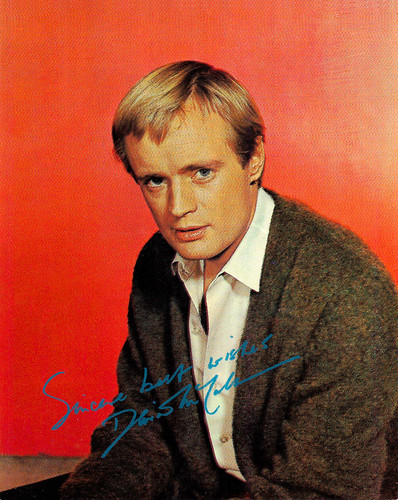
Vintage collectors Card. David McCallum as U.N.C.L.E. agent Illya Kuryakin in the TV series The Man from U.N.C.L.E. (1964–1968).

Spanish postcard by Bergas, no. 917. David McCallum as U.N.C.L.E. agent Illya Kuryakin in the TV series The Man from U.N.C.L.E. (1964–1968).
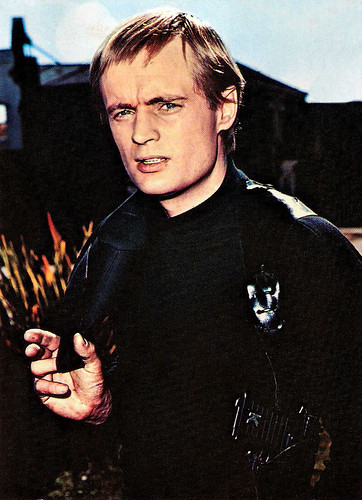
American postcard by C.G. Williams Ltd., Maidstone, Kent / Colourpicture, no. P81326. David McCallum as U.N.C.L.E. agent Illya Kuryakin in the TV series The Man from U.N.C.L.E. (1964–1968).
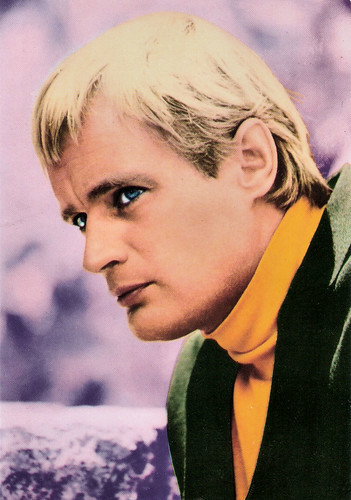
Spanish postcard by Bergas, no. 682. David McCallum as U.N.C.L.E. agent Illya Kuryakin in the TV series The Man from U.N.C.L.E. (1964–1968).
Whom the Gods Love, Die Young
David Keith McCallum was born in 1933 in Glasgow, Scotland, UK. His father, David McCallum Sr., was the first violinist for the London Philharmonic and his mother, Dorothy Dorman, was a cellist.
It's not surprising that David was originally headed for a career in music, playing the oboe. He studied briefly at the Royal Academy of Music. He left that, however, for the Royal Academy of Dramatic Art, which he attended between 1949 and 1951.
His first acting role was in 'Whom the Gods Love, Die Young' playing a doomed royal. A James Dean -themed photograph of McCallum caught the attention of the Rank Organisation, who signed him in 1956. McCallum married actress Jill Ireland while filming Hell Drivers (Cy Endfield, 1957) together. He made nearly a dozen films in the United Kingdom before he had his breakthrough as Lt. Wyatt in Billy Budd (Peter Ustinov, 1962), starring Terence Stamp .
His first American film was Freud: The Secret Passion (1962), directed by John Huston . In 1963 he introduced Ireland to Charles Bronson when both were filming The Great Escape (John Sturges, 1963). She subsequently left McCallum and married Bronson in 1968.
McCallum and Ireland had three sons: Paul, Jason (an adopted son who died from an accidental drug overdose in 1989), and Val (short for Valentine), who is a respected guitarist and session musician, recording and performing with such artists as Sheryl Crow.
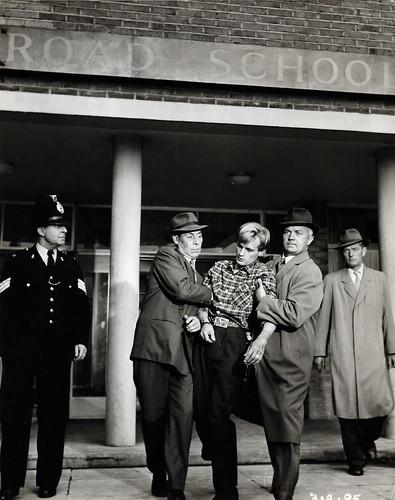
British press photo, no. 319/95. David McCallum in Violent Playground (Basil Dearden, 1958). Caption: Finally Cathie persuades her brother to give himself up to the police, and he is led away from the school and driven off in a Black Maria. At first, Cathie is distraught at the sight of her brother taken away in handcuffs. Hysterically she screams at Truman, but with the help of the Priest he manages to pacify her." "Violent Playground, the story of a Liverpool fire-raising gang, is being made for the Rank Organisation by Michael Relph and Basil Dearden, the famous team that produced The Blue Lamp. It stars Stanley Baker , David McCallum and Anne Heywood . Also in the cast are Peter Cushing and John Slater. The film is being shot on location in Liverpool and at Pinewood."
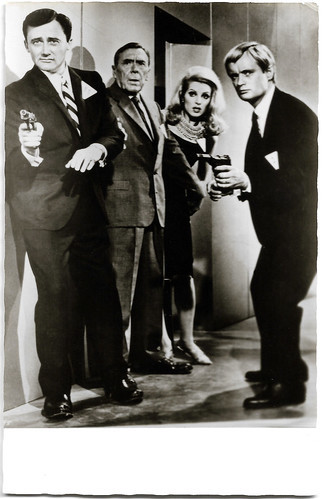
German postcard by Kolibri-Verlag, Minden/Westf., no. 2872. Robert Vaughn as U.N.C.L.E. agent Napoleon Solo, Leo G. Carroll as Alexander Waverly, Barbara Moore as Lisa Rogers, and David McCallum as U.N.C.L.E. agent Illya Kuryakin in the TV series The Man from U.N.C.L.E. (1964–1968). In Germany, the series was called 'Solo für O.N.C.E.L.' and was broadcast by the ZDF.
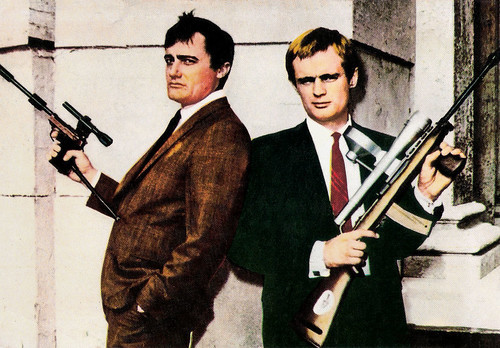
Spanish postcard by Postal Oscar Color S.A., Hospitalet (Barcelona), no. 727. Robert Vaughn and David McCallum in the American TV series The Man from U.N.C.L.E. (1964–1968).
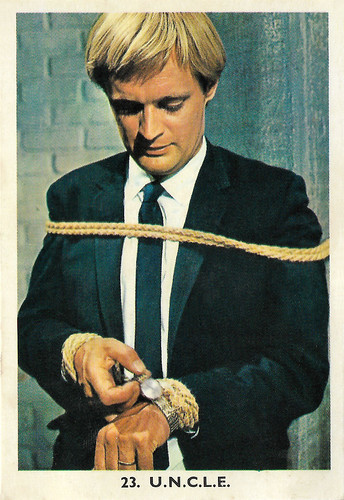
Vintage collectors card, no. 23. David McCallum as U.N.C.L.E. agent Illya Kuryakin in the TV series The Man from U.N.C.L.E. (1964–1968).
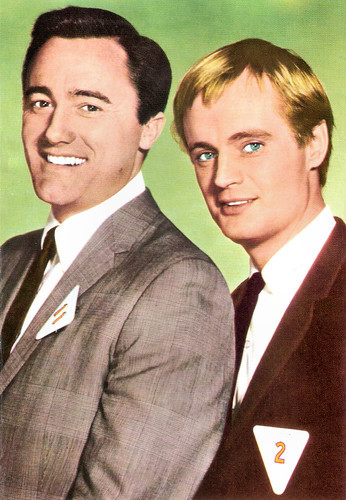
Spanish postcard by Bergas, no. 773. Photo: publicity still for the TV series The Man from U.N.C.L.E. (1964-1968) with David McCallum.
The mysterious Russian agent Illya Kuryakin
In 1964, David McCallum became a star as the mysterious Russian agent Illya Kuryakin in the hit TV series The Man from U.N.C.L.E. (1964).
The series was based on the popularity of the James Bond films. McCallum and Robert Vaughn play two top Agents of the United Network Command for Law and Enforcement (U.N.C.L.E.) who fight the enemies of peace, particularly the forces of T.H.R.U.S.H. and use charm, wit, and a never-ending assortment of gadgets.
McCallum's Beatle-style blond haircut provided a trendy contrast to Vaughn's clean-cut appearance. He became a sex symbol and his Russian alter ego became a pop culture phenomenon, despite the Cold War.
McCallum received two Emmy Award nominations in the course of the show's four-year run (1964–1968) for playing the intellectual and introverted secret agent.
McCallum also played the role of Judas Iscariot in The Greatest Story Ever Told (George Stevens, 1965). This epic is a retelling of the Biblical account of Jesus of Nazareth (Max von Sydow), from the Nativity through to the Ascension. In the 1960s, McCallum also recorded four albums for Capitol Records with music producer David Axelrod.
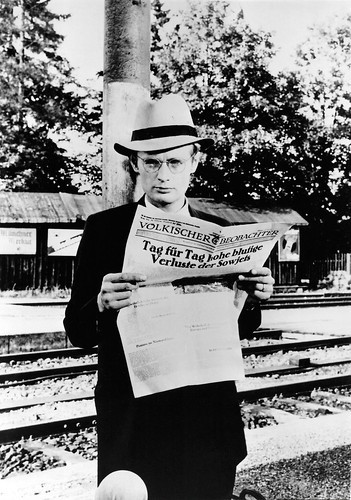
German press photo by Pressebilderdienst Kindermann, Berlin, no. 34477/1. Issued for the broadcasting at ZDF television on 15 September 1991. David McCallum in The Great Escape (John Sturges, 1963).
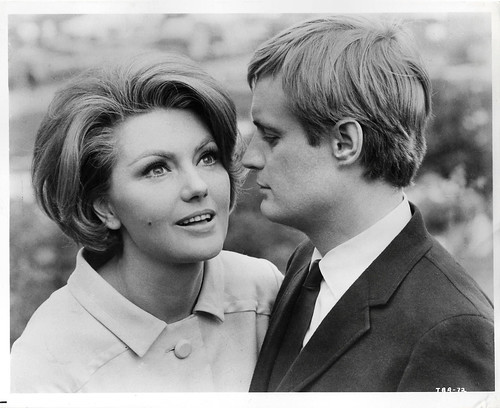
British press photo, no. 319/95. Sylva Koscina and David McCallum in Three Bites of the Apple (Alvin Ganzer, 1967).
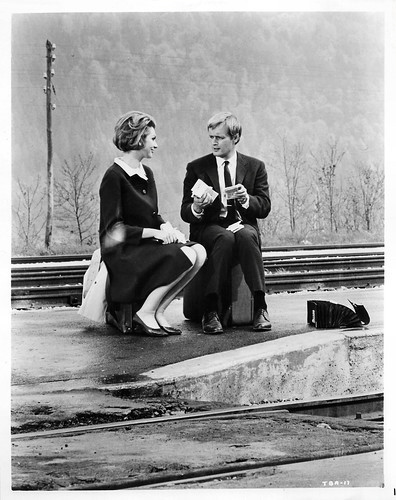
British press photo, no. TBA-17. Sylva Koscina and David McCallum in Three Bites of the Apple (Alvin Ganzer, 1967). Caption: Carla Moretti ( Sylva Koscina ), having tried to fleece tour guide Stanley Thrumm (David McCallum), has a change of heart and is happy that he has been about to retrieve his money. A romantic comedy of a tour guide in Europe whose life is turned upside-down when he wins a fortune at the gambling tables, Three Bites of the Apple stars David McCallum, Sylva Koscina and Tammy Grimes, with Harvey Korman and Domenico Modugno in co-starring roles. The Metro-Goldwyn-Mayer presentation, produced and directed by Alvin Ganzer, was filmed in Panavision and Metro-color on locations in Rome, Venice and Portofino.
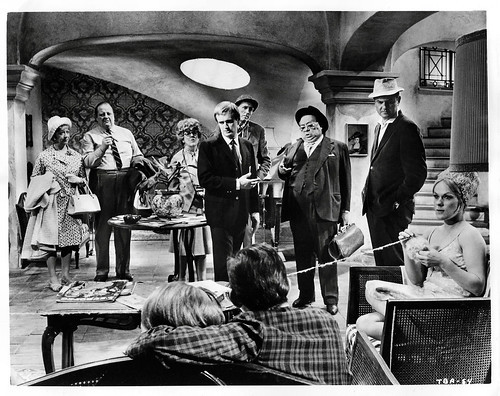
British press photo, no. TBA-54. David McCallum, Aldo Fabrizi and Tammy Grimes in Three Bites of the Apple (Alvin Ganzer, 1967). Caption: Tour guide Stanley Thrumm (David McCallum) explains to his touring party that they will be held up because of the illness of two of the members, who are being treated by the doctor (Aldo Fabrizi) on his right. Seated in the lower right corner is Tammy Grimes, cast as the spinster tourist, Miss Sparrow.
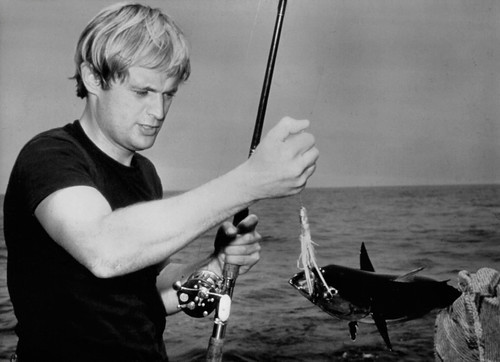
German press photo, no. D 2386/2. Photo: RTL Plus, Köln (Cologne). David McCallum in Sol Madrid/They Only Kill Once (Brian G. Hutton, 1968). The photo was issued for the TV screening of the film in Germany on 25 October 1991 under the title Kugeln sind sein Autogramm. Caption: Agent Sol Madrid (David McCallum) has a big fish on the rod. His biggest catch, however, will be a drug ring, of which the dealers will be caught in his net.
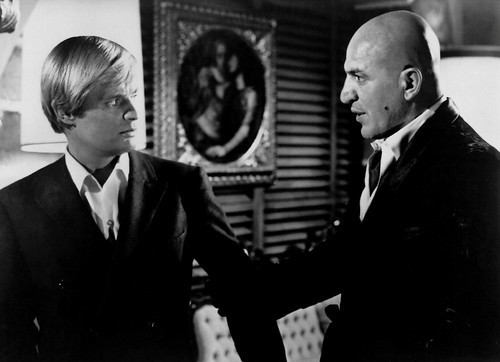
German press photo. Photo: RTL Plus, Köln (Cologne). David McCallum and Telly Savalas in Sol Madrid/They Only Kill Once (Brian G. Hutton, 1968). The photo was issued for the TV screening of the film in Germany on 25 October 1991 under the title Kugeln sind sein Autogramm.
Chief medical examiner Dr. Donald 'Duckie' Mallard
For decades, David McCallum never quite repeated the popular success he had gained as Kuryakin, though he did become a familiar face on British television in such shows as Colditz (1972–1974), Kidnapped (1978), and ITV's Science-Fiction series Sapphire & Steel (1979–1982) opposite Joanna Lumley.
In 1975 he played the title character in a short-lived U.S. version of The Invisible Man. He and Robert Vaughn reprised their roles of Kuryakin and Solo in the TV film, Return of the Man from U.N.C.L.E. (1983). In 1986 they reunited again in an episode of The A-Team entitled 'The Say U.N.C.L.E. Affair'.
Finally, McCallum made a come-back with his superlative portrayal of chief medical examiner Dr. Donald 'Duckie' Mallard on the hit CBS series, NCIS: Naval Criminal Investigative Service (2003) with Mark Harmon. He has played the same character in three different series: JAG (1995), NCIS: Naval Criminal Investigative Service (2003), and NCIS: New Orleans (2014). In 2016 he published the novel 'Once a Crooked Man' (2016).
McCallum was married to former model Katherine Carpenter since 1967. They had a son, Peter, a daughter, Sophie and six grandchildren. McCallum and his wife are active with charitable organizations that support the United States Marine Corps: Katherine's father was a Marine who served in the Battle of Iwo Jima, and her brother lost his life in the Vietnam War.
David McCallum McCallum died in 2023 of natural causes surrounded by his family at New York Presbyterian Hospital. "He was the kindest, coolest, most patient and loving father", his son Peter McCallum wrote in a statement from the family. "He always put family before self."

Austrian press photo by Kïvesdi Presseagentur Ges., Wien for the Austrian broadcasting on 5 October 1983. David McCallum and Melinda Fee in the TV series The Invisible Man (1975). The Austrian title was Der Unsichtbare. Caption: "Rare representative of his field. Mr. Devega is a great art lover and also an ambassador. He was particularly impressed by some important paintings hanging in the Capitol. He secretly replaces them with counterfeits so that he can then blackmail the US government. He has played this game a few times and one could never prove anything ... Dan and Kate are tasked to prevent the scandal ....."
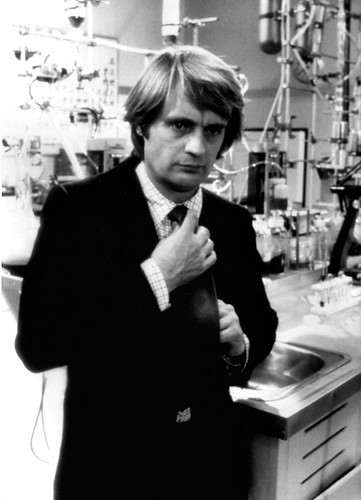
German press photo by RTL Plus for the German broadcasting on 13 December 1991. David McCallum in the TV series The Invisible Man (1975). The German title was Der Unsichtbare. Caption: Dr. Daniel Westin (David McCallum) made a sensational discovery in his research lab.
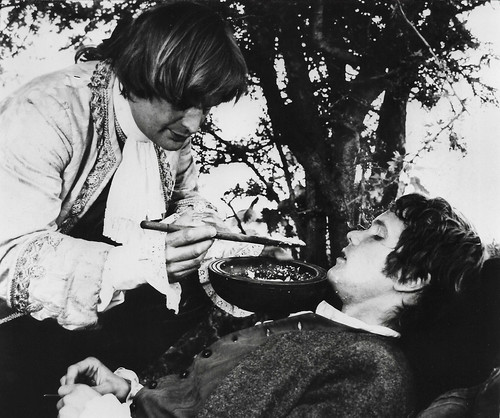
German press photo by Ursula Bunk / ZDF. David McCallum and Ekkehardt Belle in the TV Mini-series Kidnapped (Jean-Pierre Decourt, 1978), part 2. Caption: Alan (David McCallum) cares for the very weakened David (Ekkehardt Belle) and gives him something to eat. This episode was broadcast on German television on 29 December 1984.
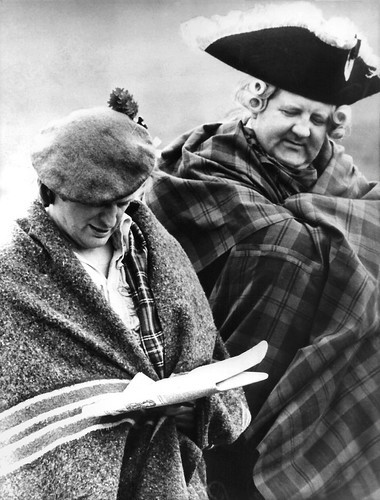
German press photo by Pressebilderdienst Kindermann / ZDF. David McCallum as Alan Breck and Bruce Purchase as Army Officer on the set of the TV Mini-series Kidnapped (Jean-Pierre Decourt, 1978), episode 2. This episode was broadcast on German television on 10 December 1978.
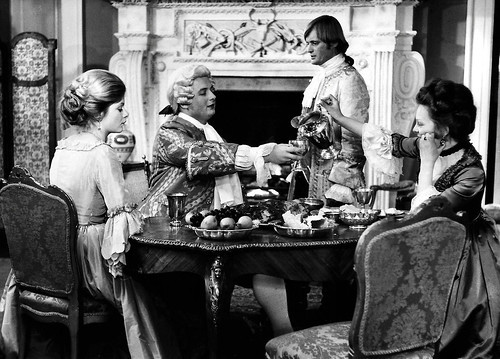
German press photo by ZDF Bilder Dienst for the broadcasting by the ZDF on 17 December 1978. David McCallum and Christopher Biggins in the TV Mini-series Kidnapped (Jean-Pierre Decourt, 1978), part 8. Caption: Alan Breck (David McCallum) is disappointed with the easy life and indifference of Prince Charles (Christopher Biggins), the Scottish heir to the throne, in France. Other actors are unknown.
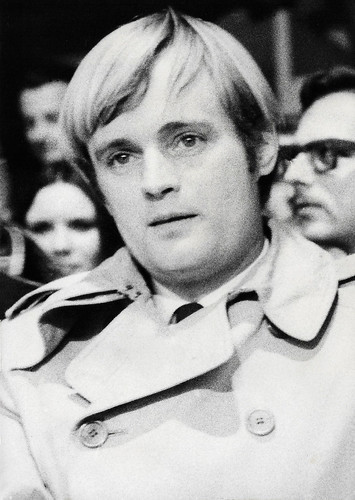
Vintage press photo.
Sources: (IMDb), Brian Lowry (CNN), Wikipedia, and .

Spanish postcard by Ediciones Este, no. 164-T, 1966. David McCallum as U.N.C.L.E. agent Illya Kuryakin in the TV series The Man from U.N.C.L.E. (1964–1968).

Vintage collectors Card. David McCallum as U.N.C.L.E. agent Illya Kuryakin in the TV series The Man from U.N.C.L.E. (1964–1968).

Spanish postcard by Bergas, no. 917. David McCallum as U.N.C.L.E. agent Illya Kuryakin in the TV series The Man from U.N.C.L.E. (1964–1968).

American postcard by C.G. Williams Ltd., Maidstone, Kent / Colourpicture, no. P81326. David McCallum as U.N.C.L.E. agent Illya Kuryakin in the TV series The Man from U.N.C.L.E. (1964–1968).

Spanish postcard by Bergas, no. 682. David McCallum as U.N.C.L.E. agent Illya Kuryakin in the TV series The Man from U.N.C.L.E. (1964–1968).
Whom the Gods Love, Die Young
David Keith McCallum was born in 1933 in Glasgow, Scotland, UK. His father, David McCallum Sr., was the first violinist for the London Philharmonic and his mother, Dorothy Dorman, was a cellist.
It's not surprising that David was originally headed for a career in music, playing the oboe. He studied briefly at the Royal Academy of Music. He left that, however, for the Royal Academy of Dramatic Art, which he attended between 1949 and 1951.
His first acting role was in 'Whom the Gods Love, Die Young' playing a doomed royal. A James Dean -themed photograph of McCallum caught the attention of the Rank Organisation, who signed him in 1956. McCallum married actress Jill Ireland while filming Hell Drivers (Cy Endfield, 1957) together. He made nearly a dozen films in the United Kingdom before he had his breakthrough as Lt. Wyatt in Billy Budd (Peter Ustinov, 1962), starring Terence Stamp .
His first American film was Freud: The Secret Passion (1962), directed by John Huston . In 1963 he introduced Ireland to Charles Bronson when both were filming The Great Escape (John Sturges, 1963). She subsequently left McCallum and married Bronson in 1968.
McCallum and Ireland had three sons: Paul, Jason (an adopted son who died from an accidental drug overdose in 1989), and Val (short for Valentine), who is a respected guitarist and session musician, recording and performing with such artists as Sheryl Crow.

British press photo, no. 319/95. David McCallum in Violent Playground (Basil Dearden, 1958). Caption: Finally Cathie persuades her brother to give himself up to the police, and he is led away from the school and driven off in a Black Maria. At first, Cathie is distraught at the sight of her brother taken away in handcuffs. Hysterically she screams at Truman, but with the help of the Priest he manages to pacify her." "Violent Playground, the story of a Liverpool fire-raising gang, is being made for the Rank Organisation by Michael Relph and Basil Dearden, the famous team that produced The Blue Lamp. It stars Stanley Baker , David McCallum and Anne Heywood . Also in the cast are Peter Cushing and John Slater. The film is being shot on location in Liverpool and at Pinewood."

German postcard by Kolibri-Verlag, Minden/Westf., no. 2872. Robert Vaughn as U.N.C.L.E. agent Napoleon Solo, Leo G. Carroll as Alexander Waverly, Barbara Moore as Lisa Rogers, and David McCallum as U.N.C.L.E. agent Illya Kuryakin in the TV series The Man from U.N.C.L.E. (1964–1968). In Germany, the series was called 'Solo für O.N.C.E.L.' and was broadcast by the ZDF.

Spanish postcard by Postal Oscar Color S.A., Hospitalet (Barcelona), no. 727. Robert Vaughn and David McCallum in the American TV series The Man from U.N.C.L.E. (1964–1968).

Vintage collectors card, no. 23. David McCallum as U.N.C.L.E. agent Illya Kuryakin in the TV series The Man from U.N.C.L.E. (1964–1968).

Spanish postcard by Bergas, no. 773. Photo: publicity still for the TV series The Man from U.N.C.L.E. (1964-1968) with David McCallum.
The mysterious Russian agent Illya Kuryakin
In 1964, David McCallum became a star as the mysterious Russian agent Illya Kuryakin in the hit TV series The Man from U.N.C.L.E. (1964).
The series was based on the popularity of the James Bond films. McCallum and Robert Vaughn play two top Agents of the United Network Command for Law and Enforcement (U.N.C.L.E.) who fight the enemies of peace, particularly the forces of T.H.R.U.S.H. and use charm, wit, and a never-ending assortment of gadgets.
McCallum's Beatle-style blond haircut provided a trendy contrast to Vaughn's clean-cut appearance. He became a sex symbol and his Russian alter ego became a pop culture phenomenon, despite the Cold War.
McCallum received two Emmy Award nominations in the course of the show's four-year run (1964–1968) for playing the intellectual and introverted secret agent.
McCallum also played the role of Judas Iscariot in The Greatest Story Ever Told (George Stevens, 1965). This epic is a retelling of the Biblical account of Jesus of Nazareth (Max von Sydow), from the Nativity through to the Ascension. In the 1960s, McCallum also recorded four albums for Capitol Records with music producer David Axelrod.

German press photo by Pressebilderdienst Kindermann, Berlin, no. 34477/1. Issued for the broadcasting at ZDF television on 15 September 1991. David McCallum in The Great Escape (John Sturges, 1963).

British press photo, no. 319/95. Sylva Koscina and David McCallum in Three Bites of the Apple (Alvin Ganzer, 1967).

British press photo, no. TBA-17. Sylva Koscina and David McCallum in Three Bites of the Apple (Alvin Ganzer, 1967). Caption: Carla Moretti ( Sylva Koscina ), having tried to fleece tour guide Stanley Thrumm (David McCallum), has a change of heart and is happy that he has been about to retrieve his money. A romantic comedy of a tour guide in Europe whose life is turned upside-down when he wins a fortune at the gambling tables, Three Bites of the Apple stars David McCallum, Sylva Koscina and Tammy Grimes, with Harvey Korman and Domenico Modugno in co-starring roles. The Metro-Goldwyn-Mayer presentation, produced and directed by Alvin Ganzer, was filmed in Panavision and Metro-color on locations in Rome, Venice and Portofino.

British press photo, no. TBA-54. David McCallum, Aldo Fabrizi and Tammy Grimes in Three Bites of the Apple (Alvin Ganzer, 1967). Caption: Tour guide Stanley Thrumm (David McCallum) explains to his touring party that they will be held up because of the illness of two of the members, who are being treated by the doctor (Aldo Fabrizi) on his right. Seated in the lower right corner is Tammy Grimes, cast as the spinster tourist, Miss Sparrow.

German press photo, no. D 2386/2. Photo: RTL Plus, Köln (Cologne). David McCallum in Sol Madrid/They Only Kill Once (Brian G. Hutton, 1968). The photo was issued for the TV screening of the film in Germany on 25 October 1991 under the title Kugeln sind sein Autogramm. Caption: Agent Sol Madrid (David McCallum) has a big fish on the rod. His biggest catch, however, will be a drug ring, of which the dealers will be caught in his net.

German press photo. Photo: RTL Plus, Köln (Cologne). David McCallum and Telly Savalas in Sol Madrid/They Only Kill Once (Brian G. Hutton, 1968). The photo was issued for the TV screening of the film in Germany on 25 October 1991 under the title Kugeln sind sein Autogramm.
Chief medical examiner Dr. Donald 'Duckie' Mallard
For decades, David McCallum never quite repeated the popular success he had gained as Kuryakin, though he did become a familiar face on British television in such shows as Colditz (1972–1974), Kidnapped (1978), and ITV's Science-Fiction series Sapphire & Steel (1979–1982) opposite Joanna Lumley.
In 1975 he played the title character in a short-lived U.S. version of The Invisible Man. He and Robert Vaughn reprised their roles of Kuryakin and Solo in the TV film, Return of the Man from U.N.C.L.E. (1983). In 1986 they reunited again in an episode of The A-Team entitled 'The Say U.N.C.L.E. Affair'.
Finally, McCallum made a come-back with his superlative portrayal of chief medical examiner Dr. Donald 'Duckie' Mallard on the hit CBS series, NCIS: Naval Criminal Investigative Service (2003) with Mark Harmon. He has played the same character in three different series: JAG (1995), NCIS: Naval Criminal Investigative Service (2003), and NCIS: New Orleans (2014). In 2016 he published the novel 'Once a Crooked Man' (2016).
McCallum was married to former model Katherine Carpenter since 1967. They had a son, Peter, a daughter, Sophie and six grandchildren. McCallum and his wife are active with charitable organizations that support the United States Marine Corps: Katherine's father was a Marine who served in the Battle of Iwo Jima, and her brother lost his life in the Vietnam War.
David McCallum McCallum died in 2023 of natural causes surrounded by his family at New York Presbyterian Hospital. "He was the kindest, coolest, most patient and loving father", his son Peter McCallum wrote in a statement from the family. "He always put family before self."

Austrian press photo by Kïvesdi Presseagentur Ges., Wien for the Austrian broadcasting on 5 October 1983. David McCallum and Melinda Fee in the TV series The Invisible Man (1975). The Austrian title was Der Unsichtbare. Caption: "Rare representative of his field. Mr. Devega is a great art lover and also an ambassador. He was particularly impressed by some important paintings hanging in the Capitol. He secretly replaces them with counterfeits so that he can then blackmail the US government. He has played this game a few times and one could never prove anything ... Dan and Kate are tasked to prevent the scandal ....."

German press photo by RTL Plus for the German broadcasting on 13 December 1991. David McCallum in the TV series The Invisible Man (1975). The German title was Der Unsichtbare. Caption: Dr. Daniel Westin (David McCallum) made a sensational discovery in his research lab.

German press photo by Ursula Bunk / ZDF. David McCallum and Ekkehardt Belle in the TV Mini-series Kidnapped (Jean-Pierre Decourt, 1978), part 2. Caption: Alan (David McCallum) cares for the very weakened David (Ekkehardt Belle) and gives him something to eat. This episode was broadcast on German television on 29 December 1984.

German press photo by Pressebilderdienst Kindermann / ZDF. David McCallum as Alan Breck and Bruce Purchase as Army Officer on the set of the TV Mini-series Kidnapped (Jean-Pierre Decourt, 1978), episode 2. This episode was broadcast on German television on 10 December 1978.

German press photo by ZDF Bilder Dienst for the broadcasting by the ZDF on 17 December 1978. David McCallum and Christopher Biggins in the TV Mini-series Kidnapped (Jean-Pierre Decourt, 1978), part 8. Caption: Alan Breck (David McCallum) is disappointed with the easy life and indifference of Prince Charles (Christopher Biggins), the Scottish heir to the throne, in France. Other actors are unknown.

Vintage press photo.
Sources: (IMDb), Brian Lowry (CNN), Wikipedia, and .
Published on September 26, 2023 22:00
September 25, 2023
Louise Willy
French cabaret, theatre and silent film artist Louise Willy, also known as Loulou, was born around 1873 and died on an undetermined date after 1913. She is best known for having appeared in the first erotic film in the history of cinema in 1896.
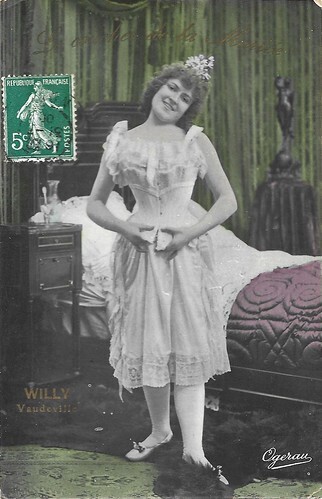
French postcard. Photo: Ogerau. Caption: "Willy, vaudeville". Louise Willy, probably in 'Le Coucher de la mariée/Le Coucher d'Yvette', a stage play turned in 1896 into the first striptease film.
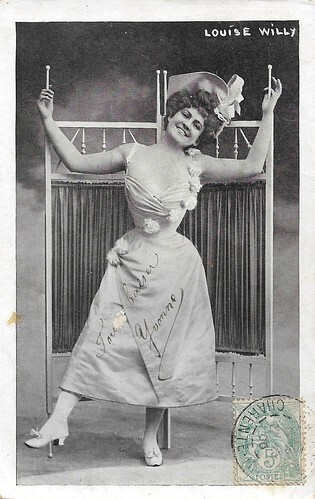
Vintage French postcard. Louise Willy in 'Le Coucher de la mariée' (The Bridegroom's Dilemma).
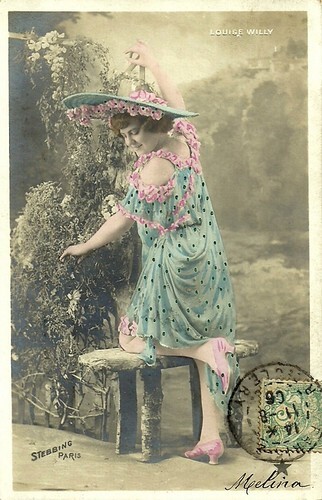
French postcard. Photo: Stebbing, Paris. Sent by mail in 1906.
Her clothes are seen falling off one by one
Louise Willy was born around 1873. She was a student of the mime Charles Aubert and made her debut at the Théâtre des Nouveautés in 1892, in a small role in 'La Bonne de chez Duval' by Antony Mars and Hippolyte Raymond. Then she appeared at the Théâtre Moderne in 'Tous à la scène' by Victor de Cottens and Paul Gavault. She joined the Folies-Bergères in 1894, in 'Fleur de Lotus', a pantomime by Armand Silvestre and Hugues Delorme. She was then hired at the Olympia and toured Cabourg and Lyon where she replaced Blanche Cavelli at the Eldorado theatre in a tableau from the play 'Le Coucher d'Yvette', also called 'Le Coucher de la mariée', a lyrical pantomime by Francisque Verdellet with music by Eugène Arnaud.
Loulou was engaged at the Jardin de Paris where she played 'Le Suicide de Pierrot', then the role of the Fairy in 'La Fée des poupées', a Viennese ballet-pantomime by Josef Hassreiter and Franz Gaul created at the Olympia in October 1894. In 1895, she appeared in the revue 'Les Turlutaines de l'année' and the pantomime 'Mauvais Rêve' by Max Maurey, music by Rodolphe Berger, and triumphed at the Olympia in 'Le Coucher de la mariée', a pantomime by Gaston Pollonnais and Oscar de Lagoanére, in which her clothes are seen falling off one by one, and in 'Le Bain de la Parisienne'.
In 1896, she appeared in the erotic film Le Coucher de la mariée/The Bridegroom's Dilemma, based on the play of the same name, a film produced by Eugène Pirou and directed by Léar (pseudonym of Albert Kirchner). From the original seven (others claim: three) minutes of the 1896 version, only two minutes survived, including the undressing sequence, and were restored in 1996, a century after.
In Le Coucher de la mariée, we see a newly-wed couple in front of the wedding bed, in sequence and full-length shot. Returning from the wedding, the husband (Frédéric Berville) raves about his wife (Willy), who is simpering. She asks him to withdraw while she undresses. He puts a screen between her and himself. She removes one by one the many garments she is wearing (jacket, dress, petticoats, underskirts, bodice). The husband cannot keep still, sometimes sponging his forehead, sometimes reading a newspaper, sometimes casting concupiscent glances over the screen.
The actors make numerous glances at the camera. The film is considered the first striptease in film history. The popularity of the film caused Georges Méliès to do a remake in 1899, while Pathé even did three: in 1901, in 1904 (with Willy herself again), and in 1907. In 1906, Pathé also would make a parody of it, called Au revoir et merci! Indeed, from the late 1890s, because of the success of Le Coucher de la mariée, Pathé developed a genre called 'scènes grivoises d'un caractère piquant'.
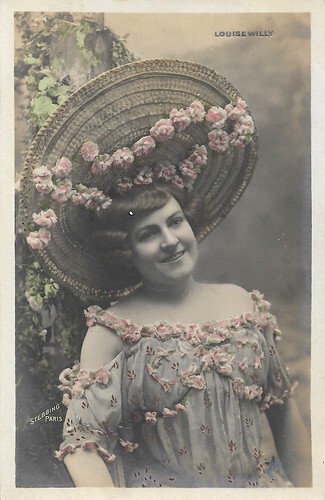
French postcard. Photo: Stebbing, Paris.
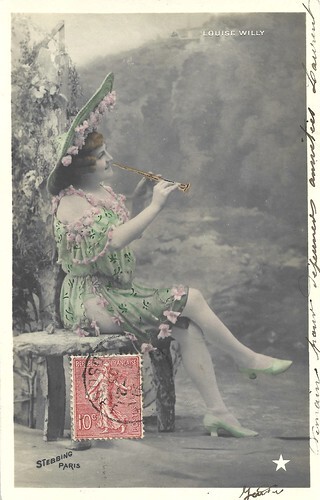
French postcard by Papier Guilleminot, series no. 770, Th 71. Photo: Stebbing, Paris. Sent by mail in 1905.
A girl who undresses, searching for a flea
In 1897, Louise Willy created the role of Églantine in the ballet-pantomime 'Le Chevalier aux fleurs' by Armand Silvestre, music by André Messager and Raoul Pugno, at the Théâtre Marigny. Back at the Olympia, in 1898, she played in a revival of 'Le Coucher de la mariée'and also in 'Pierrot cambrioleur', 'Vision!' a ballet-pantomime by Léon Roger-Millès to the music of Edmond Missa. She also played in 'Folles Amours', 'Néron' with Émilienne d'Alençon, and as Pierrette in 'Les Sept Péchés capitaux' by Maurice de Marsan to the music of Henri Hirschman, as well as in the ballet-féerie 'Les Mille et Une Nuits' by Max Maurey and A. Thierry in 1899.
She appeared at the Parisiana in 1900 in a revival of 'Mauvais Rêve', at the Olympia in 'La Belle aux cheveux d'or', a ballet-pantomime by Jean Lorrain, with music by Edmond Diet. She created the role of Julie in 'Moins cinq!', a play by Paul Gavault and Georges Berr, performed at the Palais-Royal, in November 1900. In April 1901, Willy created the role of Gabrielle Vernis in the comedy 'Sacré Léonce!' by Pierre Wolff.
Willy then left the theatre to return to the music hall with roles in 'Paris-Cascades', a ballet by Auguste Germain to the music of Louis Varney at the Olympia in September 1901, and in 'Cendrillon', a fairy-tale-ballet by Alphonse Lemonnier and Gardel Hervé to music by Victor Rogeren in 1902. At La Scala, she played 'Cambriolage' by Jacques Lemaire and Paul Fauchey in October 1902. In 1903, she was hired at the Mathurins Theatre. She played 'La Momie', a pantomime by Henry Ferrare and Louis Aubert, and the role of Laurida in 'Cœur jaloux', a pantomime by Henri Reine, with music by Chantrier.
In 1904, she played Prince Aurore in the Folies-Bergères revue by Victor de Cottens, and Praxiteles in 'Phry(g)né' with Cléo de Mérode at the Olympia. In 1905, she played in 'Pris au piège', a play by Théo, music by H. Rosès at the Théâtre des Capucines. In 1906, she was in 'Josiane Eymard', a play by Jean Lorrain at the Nouvelle-Comédie. René Debrenne hired her for the provincial tour to play the role of Cléo de Garches in 'Amour et Cie' by Louis Forest. In 1907, she created the role of Delphine in 'La Lime', a mimodrama by Henry Ferrare, music by André Fijan, at the Moulin-Rouge on 23 April, which she performed again at the Palais des Beaux-Arts in Monte Carlo in 1909. Finally, all trace of her is lost after the release of her last film L'Homme nu in 1913. She must have been about 40 years old at the time.
From 1904, Willy did various films at Pathé Frères, starting with the risqué film La puce/The Flea (Albert Capellani, 1904), about a girl who undresses, searching for a flea, as well as a remake of Le Coucher de la mariée. IMDb claims Willy was also in the 1906 films Aladin ou la lampe merveilleuse and La femme du lutteur, but the Pathé website denies this. For sure, Willy acted in two comedies of 1909: the Prince comedies Le dîner du 9 (Georges Monca, 1909) and La vengeance du chauffeur (dir. unknown, 1909). In 1911-1913 she acted in three films by Henri Desfontaines: Falstaff (1911) with Françoise Rosay , Le page (1912) with Madeleine Céliat , and L'homme nu/The Hollow Man (1913) with Raimu , her last film. The first two were for Eclipse, and the third for Pathé (although the Pathé site doesn't list this film).
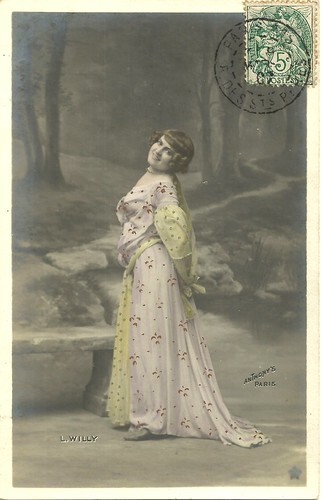
French postcard. Photo: Anthony's, Paris.
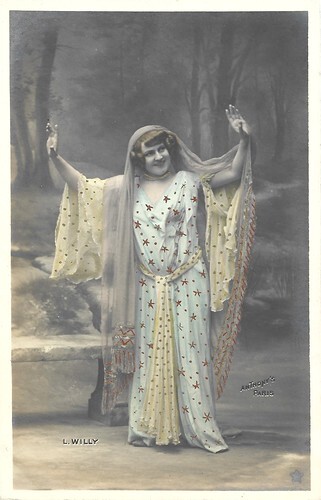
French postcard by Papier Guilleminot, series no. 743. Photo: Anthony's, Paris.
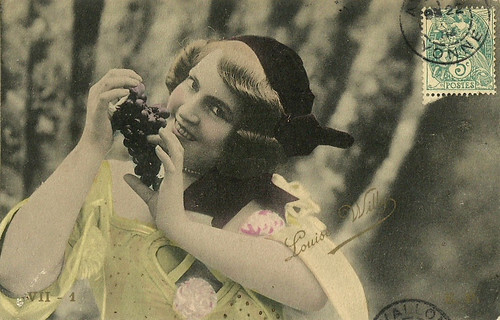
French postcard, no. VII-1. Sent by mail in 1902 or 1912.
Sources: Fondation Jérôme Seydoux-Pathé (French), Wikipedia (French), and .

French postcard. Photo: Ogerau. Caption: "Willy, vaudeville". Louise Willy, probably in 'Le Coucher de la mariée/Le Coucher d'Yvette', a stage play turned in 1896 into the first striptease film.

Vintage French postcard. Louise Willy in 'Le Coucher de la mariée' (The Bridegroom's Dilemma).

French postcard. Photo: Stebbing, Paris. Sent by mail in 1906.
Her clothes are seen falling off one by one
Louise Willy was born around 1873. She was a student of the mime Charles Aubert and made her debut at the Théâtre des Nouveautés in 1892, in a small role in 'La Bonne de chez Duval' by Antony Mars and Hippolyte Raymond. Then she appeared at the Théâtre Moderne in 'Tous à la scène' by Victor de Cottens and Paul Gavault. She joined the Folies-Bergères in 1894, in 'Fleur de Lotus', a pantomime by Armand Silvestre and Hugues Delorme. She was then hired at the Olympia and toured Cabourg and Lyon where she replaced Blanche Cavelli at the Eldorado theatre in a tableau from the play 'Le Coucher d'Yvette', also called 'Le Coucher de la mariée', a lyrical pantomime by Francisque Verdellet with music by Eugène Arnaud.
Loulou was engaged at the Jardin de Paris where she played 'Le Suicide de Pierrot', then the role of the Fairy in 'La Fée des poupées', a Viennese ballet-pantomime by Josef Hassreiter and Franz Gaul created at the Olympia in October 1894. In 1895, she appeared in the revue 'Les Turlutaines de l'année' and the pantomime 'Mauvais Rêve' by Max Maurey, music by Rodolphe Berger, and triumphed at the Olympia in 'Le Coucher de la mariée', a pantomime by Gaston Pollonnais and Oscar de Lagoanére, in which her clothes are seen falling off one by one, and in 'Le Bain de la Parisienne'.
In 1896, she appeared in the erotic film Le Coucher de la mariée/The Bridegroom's Dilemma, based on the play of the same name, a film produced by Eugène Pirou and directed by Léar (pseudonym of Albert Kirchner). From the original seven (others claim: three) minutes of the 1896 version, only two minutes survived, including the undressing sequence, and were restored in 1996, a century after.
In Le Coucher de la mariée, we see a newly-wed couple in front of the wedding bed, in sequence and full-length shot. Returning from the wedding, the husband (Frédéric Berville) raves about his wife (Willy), who is simpering. She asks him to withdraw while she undresses. He puts a screen between her and himself. She removes one by one the many garments she is wearing (jacket, dress, petticoats, underskirts, bodice). The husband cannot keep still, sometimes sponging his forehead, sometimes reading a newspaper, sometimes casting concupiscent glances over the screen.
The actors make numerous glances at the camera. The film is considered the first striptease in film history. The popularity of the film caused Georges Méliès to do a remake in 1899, while Pathé even did three: in 1901, in 1904 (with Willy herself again), and in 1907. In 1906, Pathé also would make a parody of it, called Au revoir et merci! Indeed, from the late 1890s, because of the success of Le Coucher de la mariée, Pathé developed a genre called 'scènes grivoises d'un caractère piquant'.

French postcard. Photo: Stebbing, Paris.

French postcard by Papier Guilleminot, series no. 770, Th 71. Photo: Stebbing, Paris. Sent by mail in 1905.
A girl who undresses, searching for a flea
In 1897, Louise Willy created the role of Églantine in the ballet-pantomime 'Le Chevalier aux fleurs' by Armand Silvestre, music by André Messager and Raoul Pugno, at the Théâtre Marigny. Back at the Olympia, in 1898, she played in a revival of 'Le Coucher de la mariée'and also in 'Pierrot cambrioleur', 'Vision!' a ballet-pantomime by Léon Roger-Millès to the music of Edmond Missa. She also played in 'Folles Amours', 'Néron' with Émilienne d'Alençon, and as Pierrette in 'Les Sept Péchés capitaux' by Maurice de Marsan to the music of Henri Hirschman, as well as in the ballet-féerie 'Les Mille et Une Nuits' by Max Maurey and A. Thierry in 1899.
She appeared at the Parisiana in 1900 in a revival of 'Mauvais Rêve', at the Olympia in 'La Belle aux cheveux d'or', a ballet-pantomime by Jean Lorrain, with music by Edmond Diet. She created the role of Julie in 'Moins cinq!', a play by Paul Gavault and Georges Berr, performed at the Palais-Royal, in November 1900. In April 1901, Willy created the role of Gabrielle Vernis in the comedy 'Sacré Léonce!' by Pierre Wolff.
Willy then left the theatre to return to the music hall with roles in 'Paris-Cascades', a ballet by Auguste Germain to the music of Louis Varney at the Olympia in September 1901, and in 'Cendrillon', a fairy-tale-ballet by Alphonse Lemonnier and Gardel Hervé to music by Victor Rogeren in 1902. At La Scala, she played 'Cambriolage' by Jacques Lemaire and Paul Fauchey in October 1902. In 1903, she was hired at the Mathurins Theatre. She played 'La Momie', a pantomime by Henry Ferrare and Louis Aubert, and the role of Laurida in 'Cœur jaloux', a pantomime by Henri Reine, with music by Chantrier.
In 1904, she played Prince Aurore in the Folies-Bergères revue by Victor de Cottens, and Praxiteles in 'Phry(g)né' with Cléo de Mérode at the Olympia. In 1905, she played in 'Pris au piège', a play by Théo, music by H. Rosès at the Théâtre des Capucines. In 1906, she was in 'Josiane Eymard', a play by Jean Lorrain at the Nouvelle-Comédie. René Debrenne hired her for the provincial tour to play the role of Cléo de Garches in 'Amour et Cie' by Louis Forest. In 1907, she created the role of Delphine in 'La Lime', a mimodrama by Henry Ferrare, music by André Fijan, at the Moulin-Rouge on 23 April, which she performed again at the Palais des Beaux-Arts in Monte Carlo in 1909. Finally, all trace of her is lost after the release of her last film L'Homme nu in 1913. She must have been about 40 years old at the time.
From 1904, Willy did various films at Pathé Frères, starting with the risqué film La puce/The Flea (Albert Capellani, 1904), about a girl who undresses, searching for a flea, as well as a remake of Le Coucher de la mariée. IMDb claims Willy was also in the 1906 films Aladin ou la lampe merveilleuse and La femme du lutteur, but the Pathé website denies this. For sure, Willy acted in two comedies of 1909: the Prince comedies Le dîner du 9 (Georges Monca, 1909) and La vengeance du chauffeur (dir. unknown, 1909). In 1911-1913 she acted in three films by Henri Desfontaines: Falstaff (1911) with Françoise Rosay , Le page (1912) with Madeleine Céliat , and L'homme nu/The Hollow Man (1913) with Raimu , her last film. The first two were for Eclipse, and the third for Pathé (although the Pathé site doesn't list this film).

French postcard. Photo: Anthony's, Paris.

French postcard by Papier Guilleminot, series no. 743. Photo: Anthony's, Paris.

French postcard, no. VII-1. Sent by mail in 1902 or 1912.
Sources: Fondation Jérôme Seydoux-Pathé (French), Wikipedia (French), and .
Published on September 25, 2023 22:00
September 24, 2023
Rowan Atkinson
Funny English actor and screenwriter Rowan Atkinson (1955) is best known for his much-loved historical sitcom Blackadder (1983-1989) and for the series around the clumsy, face-pulling Mr. Bean (1990-1995). The black-haired, bug-eyed, and weak-chinned comedian had also success in the cinema with Bean (1997), the sequel Mr. Bean's Holiday (2007) and with his James Bond parody Johnny English (2003).
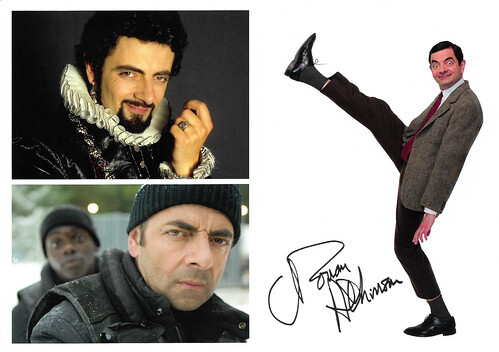
British autograph card by PBJ Management, London. Rowan Atkinson as Blackadder (left up), as Johnny English in Johnny English Reborn (Oliver Parker, 2011) with Daniel Kaluuya (left down) and as Mr. Bean (right).
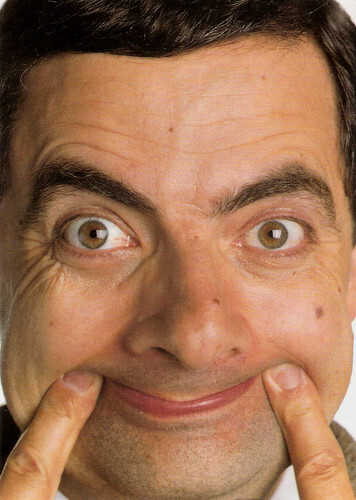
Dutch postcard by Interstat, Amsterdam. Sent by mail in 2001. Photo: Tiger Television, 1998.

German postcard by Fun-Tasia, Köln (Cologne), no. BPK 5026. Photo: Tiger Television Ltd., 1998.
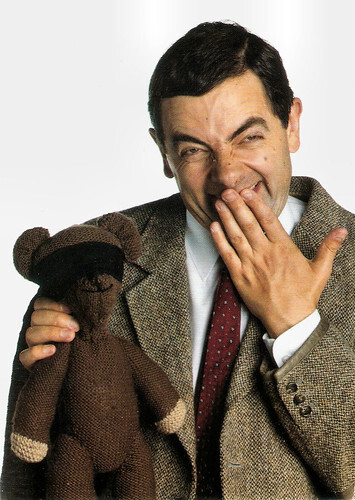
Dutch postcard postcard by Interstat, Amsterdam. Photo: Tiger Television, 1998.
The Black Adder
Rowan Sebastian Atkinson was born in Consett, England in 1955. He was the youngest of the four sons of Eric Atkinson, a farmer and company director, and Ella May (née Bainbridge). Like his father, he studied Electrical Engineering at The Queen's College, Oxford.
He also performed and wrote for the revue group of the Experimental Theatre Club (ETC) and for the Oxford University Dramatic Society (OUDS). There he met writer Richard Curtis and composer Howard Goodall, with whom he would continue to collaborate during his career. In 1976, he got national attention in the Oxford Revue at the Edinburgh Festival Fringe.
Atkinson starred in The Atkinson People (1978), a series of comedy shows for BBC Radio 3. The series of satirical interviews with fictional great men was written by Atkinson and Richard Curtis, and produced by Griff Rhys Jones.
On TV, he first came to prominence in BBC's satirical sketch show Not the Nine O'Clock News (1979–1982), and on stage and screen via his participation with members of Monty Python in The Secret Policeman's Balls (1979 and 1982) for the British section of Amnesty International. His performances in Not the Nine O'Clock News earned Atkinson a British Academy Award and got him designated 'BBC Personality of the Year' in 1980.
This success led to the lead role as the cowardly scheming Prince Edmund in the medieval sitcom The Black Adder (1983), which he also co-wrote with Richard Curtis. Black-Adder II (1986) followed the fortunes of one of the descendants of Atkinson's original character, this time in the Elizabethan era. Other sequels were Black Adder the Third (1987), set in the Regency era, and Blackadder Goes Forth (1989), set in World War I. The Blackadder series became one of the most successful of all BBC situation comedies, spawning several television specials.
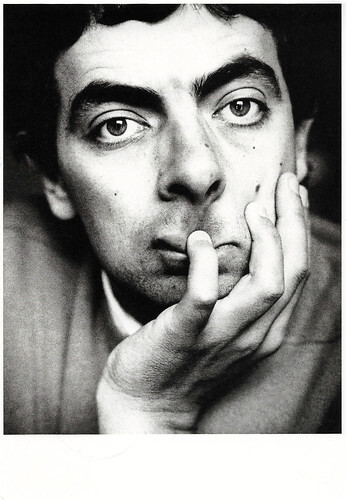
Dutch postcard postcard by Art Unlimited, Amsterdam, no. B 2200. Photo: Robin Barton, 1989. Sent by mail in Germany in 1993.
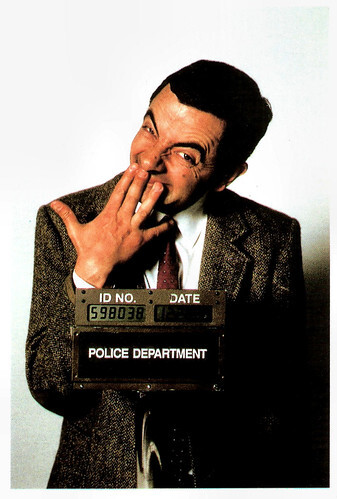
British postcard by London Postcard Company, no. PG 2506 (Series 1 set of 8), 1997. Photo: Mr. Bean / Tiger Television Limited. Rowan Atkinson in Bean (Mel Smith, 1997).
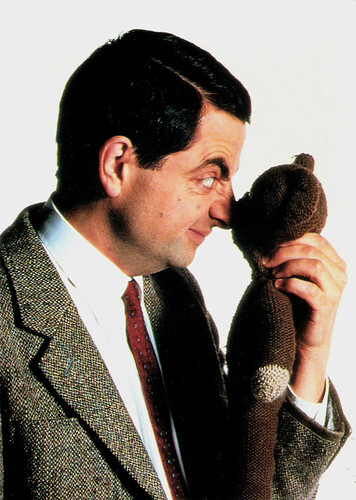
Dutch postcard by Interstat, Amsterdam. Photo: Polygram / CPL.
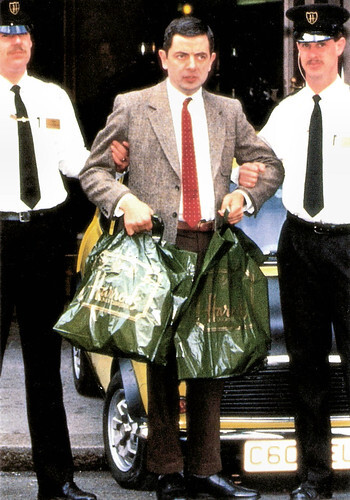
British postcard by Heroes Publishing LTD., London, no. SPC 3142.

British postcard by Heroes Publishing LTD., London, no. SPC 3143.
Mr. Bean
Rowan Atkinson's other creation, the hapless Mr. Bean, first appeared on New Year's Day in 1990 in a half-hour special for Thames Television. Several sequels to Mr. Bean appeared on television until 1995. Sandra Brennan at AllMovie : “Different from other shows in that it was largely silent, Atkinson's Bean demonstrated a rare gift for slapstick that has led to his being compared to Buster Keaton and Charlie Chaplin . During its six-year run, Mr. Bean became the most popular show in the U.K. and has since been shown in 89 countries where it has gained a cult following comparable to Monty Python and Fawlty Towers.”
The character later appeared in the feature film Bean/Bean: The Ultimate Disaster Movie (Mel Smith, 1997), for which Atkinson was also the writer and executive producer. It was an international box office hit. A second film, Mr. Bean's Holiday (Steve Bendelack, 2007) also became an international success.
Atkinson also portrayed Inspector Raymond Fowler in the TV sitcom The Thin Blue Line (1995-1996), written by Ben Elton. The Thin Blue Line takes place in a police station located in a fictitious Gasforth.
Atkinson's film career began with a supporting part in the 'unofficial' James Bond movie Never Say Never Again (Irvin Kershner, 1983) starring Sean Connery , and a leading role in the short comedy Dead on Time (Lyndall Hobbs, 1983) with Nigel Hawthorne. He appeared in Mel Smith's directorial debut, the romantic comedy The Tall Guy (1989) with Jeff Goldblum, and in Roald Dahl's The Witches (Nicolas Roeg, 1990) alongside Anjelica Huston and Mai Zetterling .
He played the part of Dexter Hayman in Hot Shots! Part Deux (Jim Abrahams, 1993), a parody of Rambo III, starring Charlie Sheen and appeared as the hilariously verbally bumbling vicar in Four Weddings and a Funeral (Mike Newell, 1994). This romantic comedy starring Hugh Grant received an Academy Award nomination for Best Picture and became an unexpected box office hit. It even became the highest-grossing British film in cinema history at the time, with worldwide earnings of $245.7 million. In Disney's The Lion King (Roger Allers, Rob Minkoff, 1994) Atkinson was featured as the voice of Zazu the Red-billed Hornbill. He also starred in Doctor Who and the Curse of Fatal Death (1999), a comedy spoof of Doctor Who for a ‘Red Nose Day’ benefit.

British postcard by Pyramid, Leicester, no. 8223. Photo: Hugh Thompson.
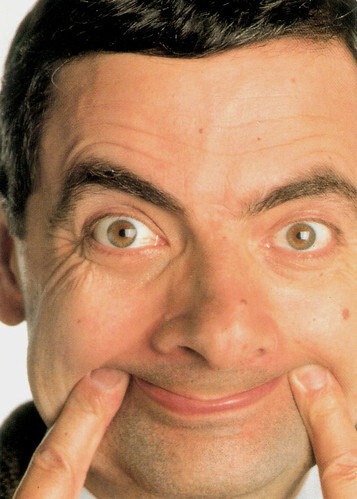
German postcard by Fun-Tasia, Köln, no. BPK 5017. Photo: Tiger Television, 1998.
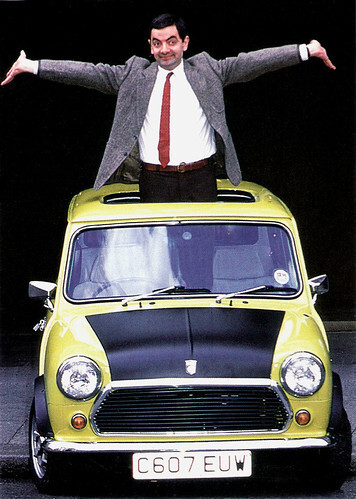
British postcard by Pyramid, Leicester, no. PC 2100.
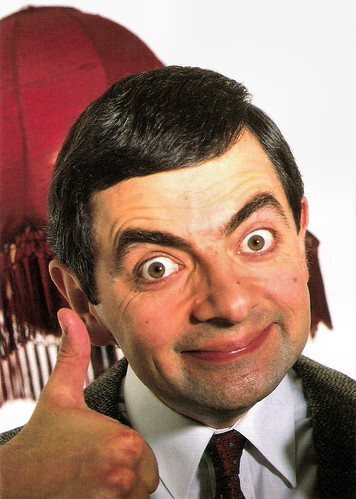
Dutch postcard postcard by Interstat, Amsterdam. Photo: Polygram / CPL. Rowan Atkinson as Mr. Bean.
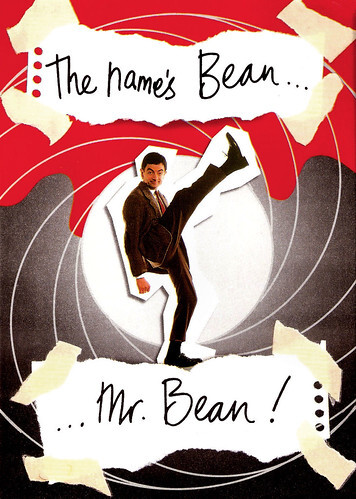
British card postcard by Cartel International Limited, Harlow, Essex, no. A20BEA212. Photo: Tiger Television, 1997. Rowan Atkinson in Bean (Mel Smith, 1997).
Johnny English
Rowan Atkinson has been listed in The Observer as one of the 50 funniest actors in British comedy and amongst the top 50 comedians ever, in a 2005 poll of fellow comedians. He continued to appear in supporting roles in film comedies, including Maybe Baby (Ben Elton, 2000) starring Hugh Laurie, Rat Race (Jerry Zucker, 2001) with John Cleese, and the hit Love Actually (Richard Curtis, 2003) with an ensemble cast including Hugh Grant , Liam Neeson , Colin Firth and Emma Thompson.
He also appeared as a reverend in the crime comedy Keeping Mum (Niall Johnson, 2005), which also starred Kristin Scott Thomas, Maggie Smith and Patrick Swayze . Atkinson fronted campaigns for Give Blood (1989), Fujifilm (1999), and Kronenbourg (1999). From 1991 on, Atkinson also appeared as a hapless and error-prone espionage agent in a long-running series for Barclaycard.
On this James Bond spoof, the Johnny English character was based, which featured in the successful film Johnny English (Peter Howitt, 2003) and its sequel Johnny English Reborn (Oliver Parker, 2011). Both films got mixed reviews but were huge successes at the international box offices.
Atkinson appeared at the 2012 Summer Olympics opening ceremony as Mr. Bean in a comedy sketch during a performance of Chariots of Fire, playing a repeated single note on a synthesiser. He then lapsed into a dream sequence in which he joined the runners from the film of the same name (about the 1924 Summer Olympics), beating them in their iconic run along West Sands at St. Andrews, by riding in a minicab and tripping the front runner. In 2013, Rowan Atkinson took on the titular role of the Simon Gray play 'Quartermaine's Terms' at Wyndham's Theatre in London. The production was directed by Richard Eyre.
Johnny English returned in Johnny English Strikes Again (David Kerr, 2018) opposite Olga Kurylenko and Emma Thompson. He also made the TV series Maigret (2016-2017), Handy Bean (2018-2020) and Man Vs. Bee (2022). Rowan Atkinson is married to make-up artist Sunetra Sastry. They have two children, Benjamin (1993) and Lily (1995). Atkinson was appointed Commander of the Order of the British Empire (CBE) in 2013.
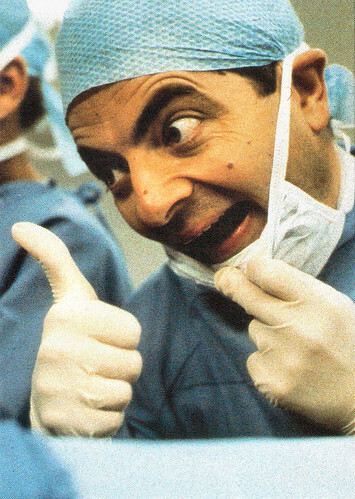
Danish Freecard by Go-Card, 1997. Photo: Polygram / AllRight / Scanbox. Rowan Atkinson in Bean (Mel Smith, 1997).
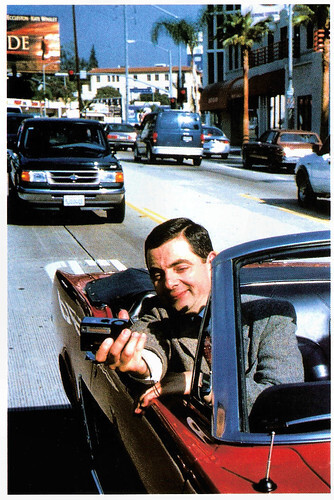
British postcard by London Postcard Company, no. PG 2502 (Series 1 set of 8), 1997. Photo: Mr. Bean / Tiger Television Limited. Rowan Atkinson in Bean (Mel Smith, 1997). Caption: Boulevard.
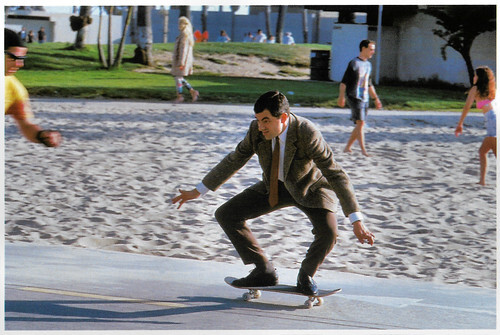
British postcard by London Postcard Company, no. PG 2507 (Series 1 Set of 8). Photo: Tiger Television Limited 1997.Rowan Atkinson in Bean/Bean: The Ultimate Disaster Movie (Mel Smith, 1997). Caption: Skateboard.
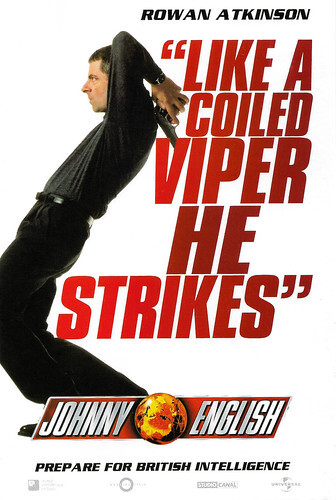
Australian freecard by Avanti, no. 1 in a series of 3. Photo: StudioCanal / Working Title / Universal. Rowan Atkinson in Johnny English (Peter Howitt, 2003). Caption: "Like a coiled viper he strikes". Prepare for British Intelligence.
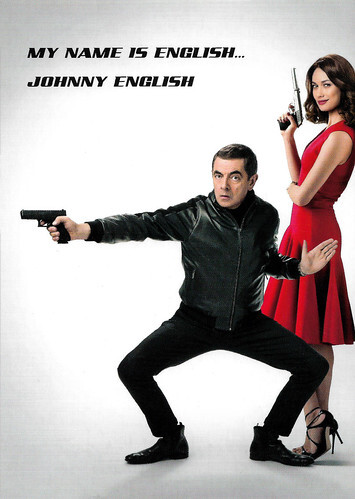
Dutch freecard by Boomerang. Photo: StudioCanal / Working Title / Universal. Rowan Atkinson and Olga Kurylenko in Johnny English Strikes Again (David Kerr, 2018). Caption: My name is English... Johnny English.
Sources: Sandra Brennan (AllMovie), Dick Fiddy (BFI ScreenOnline), Wikipedia and .

British autograph card by PBJ Management, London. Rowan Atkinson as Blackadder (left up), as Johnny English in Johnny English Reborn (Oliver Parker, 2011) with Daniel Kaluuya (left down) and as Mr. Bean (right).

Dutch postcard by Interstat, Amsterdam. Sent by mail in 2001. Photo: Tiger Television, 1998.

German postcard by Fun-Tasia, Köln (Cologne), no. BPK 5026. Photo: Tiger Television Ltd., 1998.

Dutch postcard postcard by Interstat, Amsterdam. Photo: Tiger Television, 1998.
The Black Adder
Rowan Sebastian Atkinson was born in Consett, England in 1955. He was the youngest of the four sons of Eric Atkinson, a farmer and company director, and Ella May (née Bainbridge). Like his father, he studied Electrical Engineering at The Queen's College, Oxford.
He also performed and wrote for the revue group of the Experimental Theatre Club (ETC) and for the Oxford University Dramatic Society (OUDS). There he met writer Richard Curtis and composer Howard Goodall, with whom he would continue to collaborate during his career. In 1976, he got national attention in the Oxford Revue at the Edinburgh Festival Fringe.
Atkinson starred in The Atkinson People (1978), a series of comedy shows for BBC Radio 3. The series of satirical interviews with fictional great men was written by Atkinson and Richard Curtis, and produced by Griff Rhys Jones.
On TV, he first came to prominence in BBC's satirical sketch show Not the Nine O'Clock News (1979–1982), and on stage and screen via his participation with members of Monty Python in The Secret Policeman's Balls (1979 and 1982) for the British section of Amnesty International. His performances in Not the Nine O'Clock News earned Atkinson a British Academy Award and got him designated 'BBC Personality of the Year' in 1980.
This success led to the lead role as the cowardly scheming Prince Edmund in the medieval sitcom The Black Adder (1983), which he also co-wrote with Richard Curtis. Black-Adder II (1986) followed the fortunes of one of the descendants of Atkinson's original character, this time in the Elizabethan era. Other sequels were Black Adder the Third (1987), set in the Regency era, and Blackadder Goes Forth (1989), set in World War I. The Blackadder series became one of the most successful of all BBC situation comedies, spawning several television specials.

Dutch postcard postcard by Art Unlimited, Amsterdam, no. B 2200. Photo: Robin Barton, 1989. Sent by mail in Germany in 1993.

British postcard by London Postcard Company, no. PG 2506 (Series 1 set of 8), 1997. Photo: Mr. Bean / Tiger Television Limited. Rowan Atkinson in Bean (Mel Smith, 1997).

Dutch postcard by Interstat, Amsterdam. Photo: Polygram / CPL.

British postcard by Heroes Publishing LTD., London, no. SPC 3142.

British postcard by Heroes Publishing LTD., London, no. SPC 3143.
Mr. Bean
Rowan Atkinson's other creation, the hapless Mr. Bean, first appeared on New Year's Day in 1990 in a half-hour special for Thames Television. Several sequels to Mr. Bean appeared on television until 1995. Sandra Brennan at AllMovie : “Different from other shows in that it was largely silent, Atkinson's Bean demonstrated a rare gift for slapstick that has led to his being compared to Buster Keaton and Charlie Chaplin . During its six-year run, Mr. Bean became the most popular show in the U.K. and has since been shown in 89 countries where it has gained a cult following comparable to Monty Python and Fawlty Towers.”
The character later appeared in the feature film Bean/Bean: The Ultimate Disaster Movie (Mel Smith, 1997), for which Atkinson was also the writer and executive producer. It was an international box office hit. A second film, Mr. Bean's Holiday (Steve Bendelack, 2007) also became an international success.
Atkinson also portrayed Inspector Raymond Fowler in the TV sitcom The Thin Blue Line (1995-1996), written by Ben Elton. The Thin Blue Line takes place in a police station located in a fictitious Gasforth.
Atkinson's film career began with a supporting part in the 'unofficial' James Bond movie Never Say Never Again (Irvin Kershner, 1983) starring Sean Connery , and a leading role in the short comedy Dead on Time (Lyndall Hobbs, 1983) with Nigel Hawthorne. He appeared in Mel Smith's directorial debut, the romantic comedy The Tall Guy (1989) with Jeff Goldblum, and in Roald Dahl's The Witches (Nicolas Roeg, 1990) alongside Anjelica Huston and Mai Zetterling .
He played the part of Dexter Hayman in Hot Shots! Part Deux (Jim Abrahams, 1993), a parody of Rambo III, starring Charlie Sheen and appeared as the hilariously verbally bumbling vicar in Four Weddings and a Funeral (Mike Newell, 1994). This romantic comedy starring Hugh Grant received an Academy Award nomination for Best Picture and became an unexpected box office hit. It even became the highest-grossing British film in cinema history at the time, with worldwide earnings of $245.7 million. In Disney's The Lion King (Roger Allers, Rob Minkoff, 1994) Atkinson was featured as the voice of Zazu the Red-billed Hornbill. He also starred in Doctor Who and the Curse of Fatal Death (1999), a comedy spoof of Doctor Who for a ‘Red Nose Day’ benefit.

British postcard by Pyramid, Leicester, no. 8223. Photo: Hugh Thompson.

German postcard by Fun-Tasia, Köln, no. BPK 5017. Photo: Tiger Television, 1998.

British postcard by Pyramid, Leicester, no. PC 2100.

Dutch postcard postcard by Interstat, Amsterdam. Photo: Polygram / CPL. Rowan Atkinson as Mr. Bean.

British card postcard by Cartel International Limited, Harlow, Essex, no. A20BEA212. Photo: Tiger Television, 1997. Rowan Atkinson in Bean (Mel Smith, 1997).
Johnny English
Rowan Atkinson has been listed in The Observer as one of the 50 funniest actors in British comedy and amongst the top 50 comedians ever, in a 2005 poll of fellow comedians. He continued to appear in supporting roles in film comedies, including Maybe Baby (Ben Elton, 2000) starring Hugh Laurie, Rat Race (Jerry Zucker, 2001) with John Cleese, and the hit Love Actually (Richard Curtis, 2003) with an ensemble cast including Hugh Grant , Liam Neeson , Colin Firth and Emma Thompson.
He also appeared as a reverend in the crime comedy Keeping Mum (Niall Johnson, 2005), which also starred Kristin Scott Thomas, Maggie Smith and Patrick Swayze . Atkinson fronted campaigns for Give Blood (1989), Fujifilm (1999), and Kronenbourg (1999). From 1991 on, Atkinson also appeared as a hapless and error-prone espionage agent in a long-running series for Barclaycard.
On this James Bond spoof, the Johnny English character was based, which featured in the successful film Johnny English (Peter Howitt, 2003) and its sequel Johnny English Reborn (Oliver Parker, 2011). Both films got mixed reviews but were huge successes at the international box offices.
Atkinson appeared at the 2012 Summer Olympics opening ceremony as Mr. Bean in a comedy sketch during a performance of Chariots of Fire, playing a repeated single note on a synthesiser. He then lapsed into a dream sequence in which he joined the runners from the film of the same name (about the 1924 Summer Olympics), beating them in their iconic run along West Sands at St. Andrews, by riding in a minicab and tripping the front runner. In 2013, Rowan Atkinson took on the titular role of the Simon Gray play 'Quartermaine's Terms' at Wyndham's Theatre in London. The production was directed by Richard Eyre.
Johnny English returned in Johnny English Strikes Again (David Kerr, 2018) opposite Olga Kurylenko and Emma Thompson. He also made the TV series Maigret (2016-2017), Handy Bean (2018-2020) and Man Vs. Bee (2022). Rowan Atkinson is married to make-up artist Sunetra Sastry. They have two children, Benjamin (1993) and Lily (1995). Atkinson was appointed Commander of the Order of the British Empire (CBE) in 2013.

Danish Freecard by Go-Card, 1997. Photo: Polygram / AllRight / Scanbox. Rowan Atkinson in Bean (Mel Smith, 1997).

British postcard by London Postcard Company, no. PG 2502 (Series 1 set of 8), 1997. Photo: Mr. Bean / Tiger Television Limited. Rowan Atkinson in Bean (Mel Smith, 1997). Caption: Boulevard.

British postcard by London Postcard Company, no. PG 2507 (Series 1 Set of 8). Photo: Tiger Television Limited 1997.Rowan Atkinson in Bean/Bean: The Ultimate Disaster Movie (Mel Smith, 1997). Caption: Skateboard.

Australian freecard by Avanti, no. 1 in a series of 3. Photo: StudioCanal / Working Title / Universal. Rowan Atkinson in Johnny English (Peter Howitt, 2003). Caption: "Like a coiled viper he strikes". Prepare for British Intelligence.

Dutch freecard by Boomerang. Photo: StudioCanal / Working Title / Universal. Rowan Atkinson and Olga Kurylenko in Johnny English Strikes Again (David Kerr, 2018). Caption: My name is English... Johnny English.
Sources: Sandra Brennan (AllMovie), Dick Fiddy (BFI ScreenOnline), Wikipedia and .
Published on September 24, 2023 22:00
September 23, 2023
Mona Freeman
American actress Mona Freeman (1926-2014) was the perennially young bobbysoxer of post-war Paramount. She played teens long after she outgrew the roles, and it later stifled her adult career although she became a competent actress.
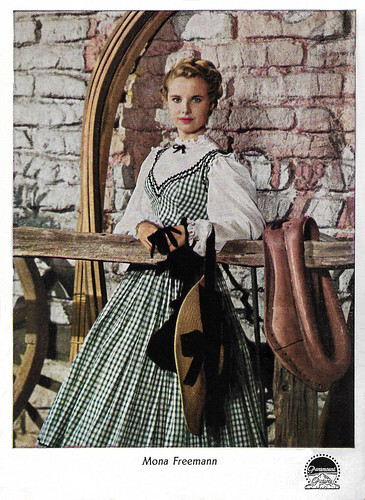
German postcard by H.S.K.-Verlag, Kölm (Cologne), no. 506. Photo: Paramount. Mona Freeman in Copper Canyon (John Farrow, 1950).
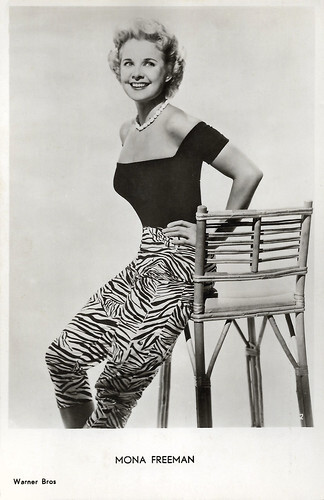
Belgian postcard, no. 119. Photo: Warner Bros.
The first of the 'Miss Subway' girls
Monica Elizabeth Freeman was born in 1926 in Baltimore, Maryland, USA. Her father, Stuart Freeman, was a contractor. She worked as a professional model while still in high school. She was a teenage cover girl for John Robert Powers and was the first of the 'Miss Subway' girls of the New York City transit system in 1940.
Freeman was signed to a film contract by Howard Hughes, who gave her a two-year contract after seeing one of her photographs on a magazine cover. Paramount wound up buying out her contract from Hughes, while she had never done a bit of work for the eccentric mogul.
The 18-year-old's first role was as Barbara Stanwyck 's teen stepdaughter in Billy Wilder 's Double Indemnity (1944) but she photographed so young, she was replaced by Jean Heather. She still made her debut in the film, however, when she was instead handed a one-line bit part as Edward G. Robinson 's secretary.
She was also cast to play Elizabeth Taylor 's older sister in National Velvet (Clarence Brown, 1944) but once again was replaced (by Angela Lansbury ) because she did not look old enough. In truth, Mona was six years Taylor's senior.
She became a popular teenage film star in such films as Junior Miss (George Seaton, 1945), That Brennan Girl (Alfred Santell, 1946) and Mother Wore Tights (Walter Lang, 1947) with Betty Grable as her mother. After a series of roles as a pretty, naive teenager she complained of being typecast.
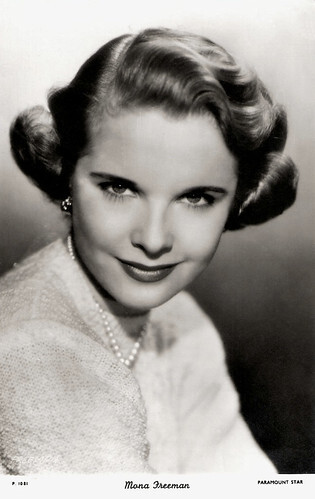
British postcard in The People series by Show Parade Picture Service, London, no. P. 1081. Photo: Paramount.
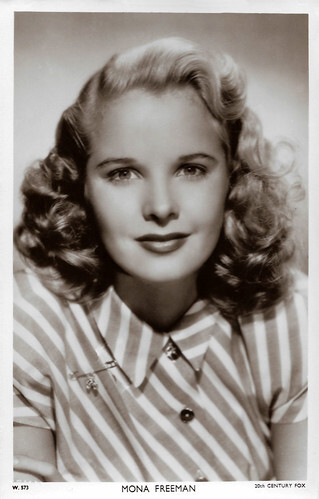
British postcard in the Picturegoer Series, London, no W. 573. Photo: 20th Century Fox.
Working her way out of the teenage ingénue role
As Mona Freeman worked her way out of the teenage ingénue role, however, she found that she had less success in adult roles, and instead of landing parts in A pictures she found herself relegated to B Westerns and somewhat tawdry crime dramas like Flesh and Fury (Joseph Pevney, 1952) with Tony Curtis and Jan Sterling, and the British production Before I Wake (Albert S. Rogell, 1955) with Jean Kent .
An exception was her role in the Film Noir Angel Face (Otto Preminger, 1952), with Robert Mitchum and Jean Simmons . She also co-starred in the hit comedy Jumping Jacks (Norman Taurog, 1952), with the comedy team of Dean Martin and Jerry Lewis .
She retired from film and toured with Edward G. Robinson in a 1958 production of Paddy Chayefsky's 'Middle of the Night' and over the next years appeared on television in such series as Wagon Train, Maverick, Wanted: Dead or Alive, and in multiple episodes of the United States Steel Hour and Perry Mason.
Her final role was in the TV film Welcome Home, Johnny Bristol (George McCowan, 1972) with Martin Landau. In later years she ran an art studio and gallery and became a portrait painter of note.
Mona Freeman passed away in 2014 in Beverly Hills, Los Angeles. She was married twice. In 1945, she married Patrick Weldon Nerney, a wealthy Hollywood auto dealer. They had one child, actress Monie Ellis (1947), and divorced in 1953. Her second husband was Los Angeles businessman Jack Ellis, whom she married in 1961. He officially adopted Mona's daughter and the couple remained together till his death in 1992.
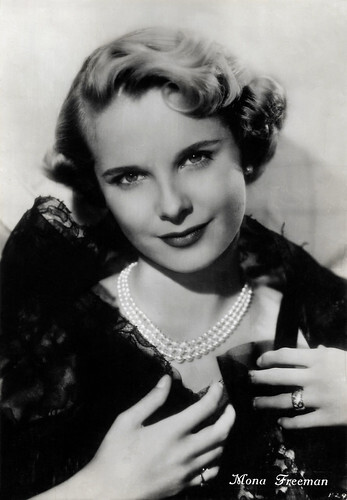
Italian postcard in the Divi del Cinema Series, no. 31.
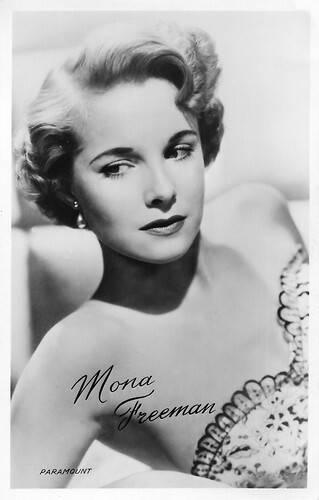
Dutch postcard by Takken / 't Sticht, A.X., no 1055. Photo: Paramount.
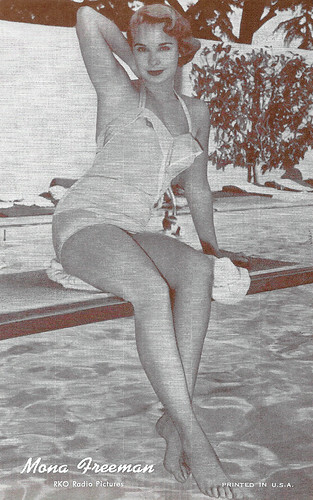
American Arcade card.
Sources: Bob Hufford (Find A Grave), Wikipedia, and .

German postcard by H.S.K.-Verlag, Kölm (Cologne), no. 506. Photo: Paramount. Mona Freeman in Copper Canyon (John Farrow, 1950).

Belgian postcard, no. 119. Photo: Warner Bros.
The first of the 'Miss Subway' girls
Monica Elizabeth Freeman was born in 1926 in Baltimore, Maryland, USA. Her father, Stuart Freeman, was a contractor. She worked as a professional model while still in high school. She was a teenage cover girl for John Robert Powers and was the first of the 'Miss Subway' girls of the New York City transit system in 1940.
Freeman was signed to a film contract by Howard Hughes, who gave her a two-year contract after seeing one of her photographs on a magazine cover. Paramount wound up buying out her contract from Hughes, while she had never done a bit of work for the eccentric mogul.
The 18-year-old's first role was as Barbara Stanwyck 's teen stepdaughter in Billy Wilder 's Double Indemnity (1944) but she photographed so young, she was replaced by Jean Heather. She still made her debut in the film, however, when she was instead handed a one-line bit part as Edward G. Robinson 's secretary.
She was also cast to play Elizabeth Taylor 's older sister in National Velvet (Clarence Brown, 1944) but once again was replaced (by Angela Lansbury ) because she did not look old enough. In truth, Mona was six years Taylor's senior.
She became a popular teenage film star in such films as Junior Miss (George Seaton, 1945), That Brennan Girl (Alfred Santell, 1946) and Mother Wore Tights (Walter Lang, 1947) with Betty Grable as her mother. After a series of roles as a pretty, naive teenager she complained of being typecast.

British postcard in The People series by Show Parade Picture Service, London, no. P. 1081. Photo: Paramount.

British postcard in the Picturegoer Series, London, no W. 573. Photo: 20th Century Fox.
Working her way out of the teenage ingénue role
As Mona Freeman worked her way out of the teenage ingénue role, however, she found that she had less success in adult roles, and instead of landing parts in A pictures she found herself relegated to B Westerns and somewhat tawdry crime dramas like Flesh and Fury (Joseph Pevney, 1952) with Tony Curtis and Jan Sterling, and the British production Before I Wake (Albert S. Rogell, 1955) with Jean Kent .
An exception was her role in the Film Noir Angel Face (Otto Preminger, 1952), with Robert Mitchum and Jean Simmons . She also co-starred in the hit comedy Jumping Jacks (Norman Taurog, 1952), with the comedy team of Dean Martin and Jerry Lewis .
She retired from film and toured with Edward G. Robinson in a 1958 production of Paddy Chayefsky's 'Middle of the Night' and over the next years appeared on television in such series as Wagon Train, Maverick, Wanted: Dead or Alive, and in multiple episodes of the United States Steel Hour and Perry Mason.
Her final role was in the TV film Welcome Home, Johnny Bristol (George McCowan, 1972) with Martin Landau. In later years she ran an art studio and gallery and became a portrait painter of note.
Mona Freeman passed away in 2014 in Beverly Hills, Los Angeles. She was married twice. In 1945, she married Patrick Weldon Nerney, a wealthy Hollywood auto dealer. They had one child, actress Monie Ellis (1947), and divorced in 1953. Her second husband was Los Angeles businessman Jack Ellis, whom she married in 1961. He officially adopted Mona's daughter and the couple remained together till his death in 1992.

Italian postcard in the Divi del Cinema Series, no. 31.

Dutch postcard by Takken / 't Sticht, A.X., no 1055. Photo: Paramount.

American Arcade card.
Sources: Bob Hufford (Find A Grave), Wikipedia, and .
Published on September 23, 2023 22:00
September 22, 2023
Jean-Pierre Cassel
Tall, elastic-faced French actor Jean-Pierre Cassel (1932-2007) rode the crest of the Nouvelle Vague, the French New Wave in the early 1960s. The charming and energetic Cassel was being compared to Danny Kaye and Jacques Tati, but he also showed depth in roles for such famous directors as Claude Chabrol, Jean-Pierre Melville, Luis Buñuel and Robert Altman.
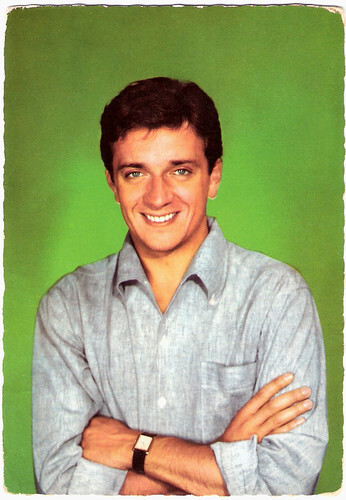
French postcard by E.D.U.G. (Editions du Globe), no. 150. Photo: Lucienne Chevert.
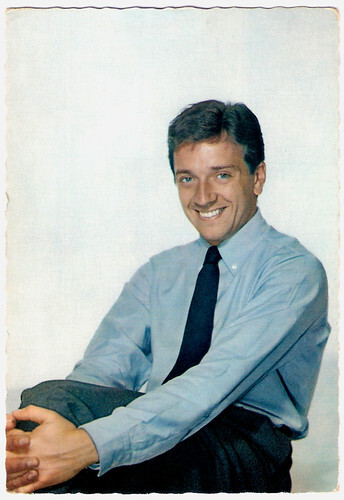
French postcard by E.D.U.G. (Editions du Globe), no. 146. Photo: Lucienne Chevert.
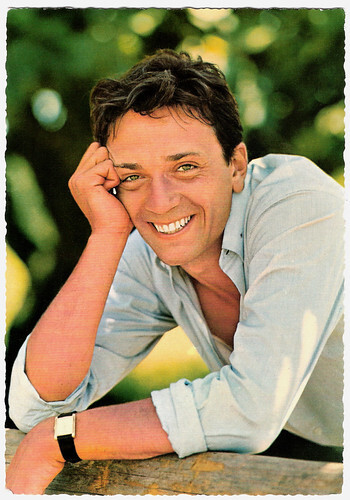
German postcard by Krüger, no. 902/393. Photo: Gérard Decaux.
Discovered by Gene Kelly
Jean-Pierre Cassel was born Jean-Pierre Crochon in Paris, in 1932. He was the son of doctor Georges Crochon and his wife Louise-Marguerite Fabrègue, an opera singer. He trained as a classical actor at the celebrated Cours Simon.
As an admirer of Fred Astaire , he took dance lessons in tap, modern and classical. Cassel was discovered by Gene Kelly as he tap danced in a St. Germain nightclub. Kelly cast him in his Paris-filmed seriocomedy The Happy Road (Gene Kelly, 1957). Some years before he already had made his film debut with an uncredited bit role in the musical comedy Saluti e baci/The Road to Happiness (Maurice Labro, Giorgio Simonelli, 1953) starring Philippe Lemaire .
Cassel's break came in 1958 when he replaced Jean-Paul Belmondo on stage in the comedy 'Oscar'. Nouvelle Vague director Philippe de Broca saw the show, and gave him the lead in Les Jeux de l'amour/Playing at Love (Philippe de Broca, 1960). This effervescent sex comedy was dominated by a running, jumping and gesticulating Cassel as a feckless young painter who will not give in to his live-in girlfriend's desire for marriage and a child.
The 1.83 m long Cassel continued with frenzied vivacity and eccentricity in Le Farceur/The Joker (Philippe de Broca, 1960), in which he is a dedicated philanderer searching for the perfect woman whom he thinks he has found in a beautiful and bored wife ( Anouk Aimée ).
The sweet-and-sour boudoir comedy L'Amant de cinq jours/Five Day Lover (Philippe de Broca, 1961), has Cassel as a bachelor, Jean Seberg, as a wife, and François Périer , as her husband. He also played the title roles in two screen adaptations of French classics, Voltaire's Candide (Norbert Carbonnaux, 1960), updated to the Second World War, and Beaumarchais' Le mariage de Figaro/The Marriage of Figaro (Marcel Bluwal, 1961). In Arsène Lupin contre Arsène Lupin/ Arsene Lupin vs. Arsene Lupin (Edouard Molinaro, 1962) he starred opposite Catherine Deneuve 's sister Françoise Dorléac . He had also fallen deeply in love with her. According to Cassel, it was ‘a terrible, destructive passion’. Dorléac was sadly killed in a motor accident in 1967.
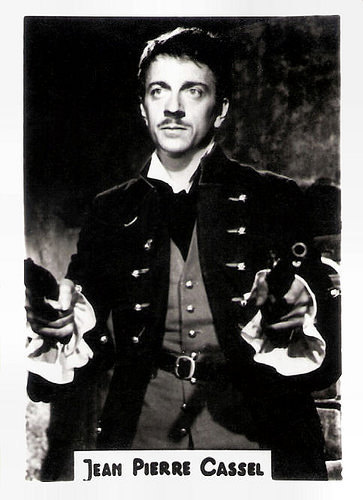
Small Romanian card by Cooperativa Fotografia, no. 2. Photo: publicity still for Les fêtes galantes/The Lace Wars (René Clair, 1965).
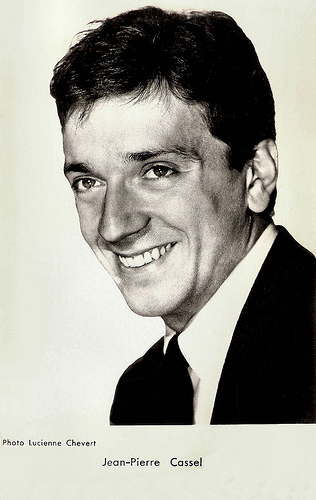
French postcard by Editions P.I., presented by Les Carbones Korès Carboplane, no. 1109 A. Photo: Lucienne Chevert.
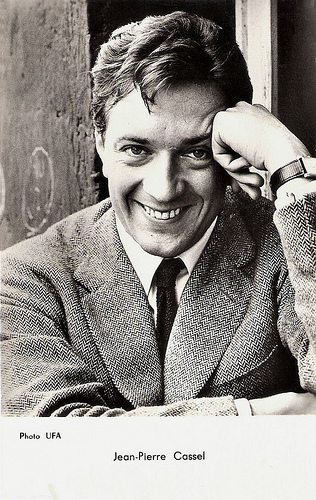
French postcard by Editions P.I., presented by Les Carbones Korès Carboplane, no. FK 123 A. Photo: Ufa.
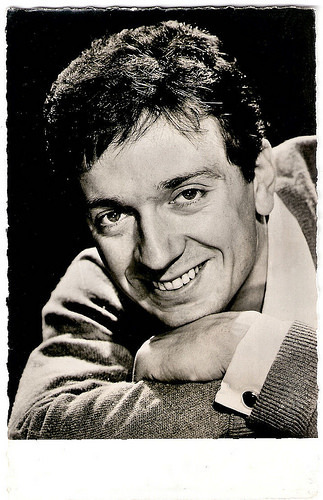
French postcard by Editions P.I., presented by Les Carbones Korès Carboplane, no. 1082. Photo: Studio Vallois.
Charming, energetic and rather lightweight
The image of a charming, energetic and rather lightweight performer pursued Jean-Pierre Cassel throughout his career even into his 70s, although he did manage to play against type several times. During the 1960s and 1970s, he worked with several famous directors. The 67-year-old Jean Renoir chose him to lead a young cast in his penultimate film, the Second World War comedy-drama Le Caporal Épinglé/The Vanishing Corporal (Jean Renoir, 1962). Cassel played the educated, off-beat corporal in a German PoW camp, dedicated to escaping, though all his many attempts, save one, end in failure.
A year later Cassel was the dashing musketeer opposite José Ferrer as the long-nosed poet in Cyrano et d'Artagnan (Abel Gance, 1963), and he was the romantic soldier Jolie-Coeur in René Clair's final film, a period farce, Les Fêtes Galantes/The Lace Wars (René Clair, 1965).
He was able to suppress his natural charm as a seedy detective in Claude Chabrol's La Rupture/The Breach (1970), trying to ruin the reputation of a woman ( Stéphane Audran ) in a divorce case; and revealed a new gravitas through his role as 'Jean François Jardie' in the famous French Resistance drama L' Armée des ombres/The Army in the Shadows (Jean-Pierre Melville, 1969), and as Stéphane Audran 's husband in Le charme discret de la bourgeoisie/The Discreet Charm of the Bourgeoisie (Luis Buñuel, 1972). Later he worked with Joseph Losey at La Truite/The Trout (Joseph Losey, 1982) with Isabelle Huppert .
He also appeared in various all-star English-language productions such as Those Magnificent Men in Their Flying Machines (Ken Annakin, 1965), Paris brûle-t-il?/Is Paris Burning? (René Clément, 1966), Oh! What a Lovely War (Richard Attenborough, 1969) as a French military officer singing 'Belgium put the Kibosh on the Kaiser', The Three Musketeers (Richard Lester, 1973) and its sequel The Four Musketeers (Richard Lester, 1974) as a bumbling King Louis XIII, and the Agatha Christie mystery Murder on the Orient Express (Sidney Lumet, 1974) starring Albert Finney .
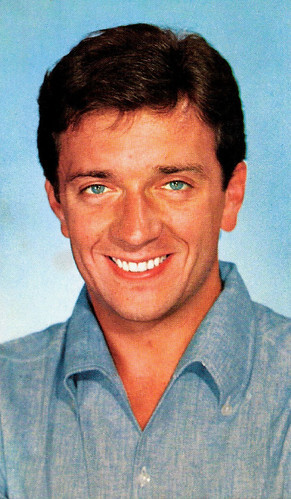
French postcard by Editions PSG, presented by Corvisart, Epinal, no. 66.
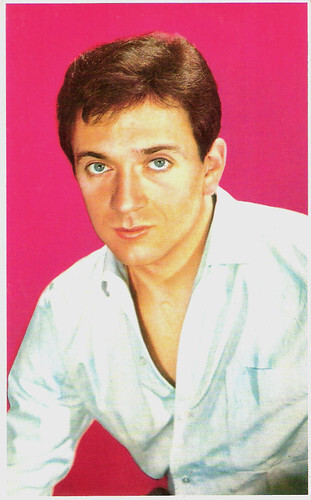
French postcard by Editions P.I., Paris, no. 1062. Promotional postcard for Corvisart, Epinal. Photo: Sam Lévin.
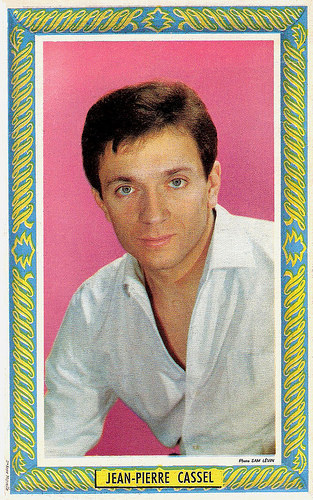
French postcard by St. Anne, Marseille. Photo: Sam Lévin.
One-man show tributes
Jean-Pierre Cassel had a parallel career in the theatre, first in Jean Vilar's company in the 1960s for whom he played in Molière and Musset, and in 1976, he realised a long ambition to play in a Broadway musical. It was as the director in 'A Chorus Line' at Drury Lane in London.
In later years Jean-Pierre Cassel appeared as Dr. Paul Gachet in Vincent & Theo (Robert Altman, 1990) starring Tim Roth as Vincent van Gogh, and Cassel also appeared in Altman's Prêt-à-Porter/Ready to Wear (Robert Altman, 1994). He reunited with Isabelle Huppert in the thriller La cérémonie/A Judgement in Stone (Claude Chabrol, 1995).
In the theatre, he did one-man show tributes to Fred Astaire and Gilbert Bécaud . In 2004, after he was hospitalised for cancer, Cassel resumed his career with renewed energy, writing his autobiography, and making recordings and films.
In 2006, he climbed back on stage at the age of 74 for a retrospective of Serge Gainsbourg , a good friend since the 1950s. The homage 'Jean-Pierre Cassel chante et danse Gainsbourg Suite' featured various songs of the famous French composer, including three unpublished songs from the 1960s.
In 2007, Cassel also appeared in dual roles (as Père Lucien and the Lourdes souvenir vendor) in Le Scaphandre et le papillon/The Diving Bell and the Butterfly (Julian Schnabel, 2007). In April 2007, Jean-Pierre Cassel died of cancer in Paris, aged 74. He was married to Sabine Litique (1966-1980) with whom he had three children, and to Anne Célérier (1981–till his death) with whom he had a daughter. He was the father of actor Vincent Cassel, Olivia Cassel (deceased), Mathias Cassel (also known as Rockin' Squat, leader of the French rap crew Assassin) and Cécile Cassel.
With his charismatic son Vincent, he appeared together in three films: Métisse/Café au lait (Mathieu Kassovitz, 1993), the short Valse nocturne/Night Waltz (Christopher Barry, 1995) and the thriller Les rivières pourpres/The Crimson Rivers (Mathieu Kassovitz, 2000). His last film was the third live-action adaptation of Albert Goscinny & René Uderzo's classic Astérix comics, Astérix aux jeux olympiques/Asterix at the Olympic Games (Frédéric Forestier, Thomas Langmann, 2008) with Gérard Depardieu as Obelix. Cassel played the wise old druid Panoramix. On 19 April 2007, Jean-Pierre Cassel died of cancer at age 74.
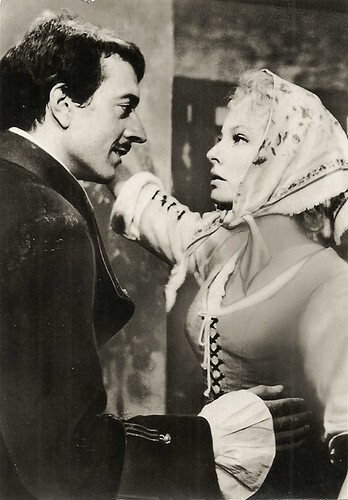
East-German postcard by VEB Progress Filmvertrieb, no. 2686. Jean-Pierre Cassel and Geneviève Casile in the Franco-Romanian coproduction Les Fêtes galantes (René Clair, 1965).
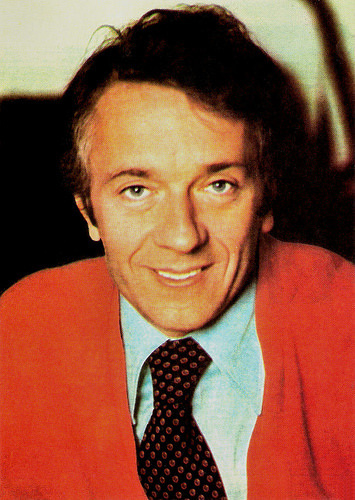
Romanian postcard by Casa Filmului Acin, no. 591.
Jean-Pierre Cassel dances and Serge Gainsbourg sings Chez les Yéyés (1964). Source: Alexey Shakhov (YouTube).
French trailer of La Rupture/The Breach (1970). Source: igotmobilephone (YouTube).
Sources: Ronald Bergan (Guardian), (IMDb), Wikipedia, and .

French postcard by E.D.U.G. (Editions du Globe), no. 150. Photo: Lucienne Chevert.

French postcard by E.D.U.G. (Editions du Globe), no. 146. Photo: Lucienne Chevert.

German postcard by Krüger, no. 902/393. Photo: Gérard Decaux.
Discovered by Gene Kelly
Jean-Pierre Cassel was born Jean-Pierre Crochon in Paris, in 1932. He was the son of doctor Georges Crochon and his wife Louise-Marguerite Fabrègue, an opera singer. He trained as a classical actor at the celebrated Cours Simon.
As an admirer of Fred Astaire , he took dance lessons in tap, modern and classical. Cassel was discovered by Gene Kelly as he tap danced in a St. Germain nightclub. Kelly cast him in his Paris-filmed seriocomedy The Happy Road (Gene Kelly, 1957). Some years before he already had made his film debut with an uncredited bit role in the musical comedy Saluti e baci/The Road to Happiness (Maurice Labro, Giorgio Simonelli, 1953) starring Philippe Lemaire .
Cassel's break came in 1958 when he replaced Jean-Paul Belmondo on stage in the comedy 'Oscar'. Nouvelle Vague director Philippe de Broca saw the show, and gave him the lead in Les Jeux de l'amour/Playing at Love (Philippe de Broca, 1960). This effervescent sex comedy was dominated by a running, jumping and gesticulating Cassel as a feckless young painter who will not give in to his live-in girlfriend's desire for marriage and a child.
The 1.83 m long Cassel continued with frenzied vivacity and eccentricity in Le Farceur/The Joker (Philippe de Broca, 1960), in which he is a dedicated philanderer searching for the perfect woman whom he thinks he has found in a beautiful and bored wife ( Anouk Aimée ).
The sweet-and-sour boudoir comedy L'Amant de cinq jours/Five Day Lover (Philippe de Broca, 1961), has Cassel as a bachelor, Jean Seberg, as a wife, and François Périer , as her husband. He also played the title roles in two screen adaptations of French classics, Voltaire's Candide (Norbert Carbonnaux, 1960), updated to the Second World War, and Beaumarchais' Le mariage de Figaro/The Marriage of Figaro (Marcel Bluwal, 1961). In Arsène Lupin contre Arsène Lupin/ Arsene Lupin vs. Arsene Lupin (Edouard Molinaro, 1962) he starred opposite Catherine Deneuve 's sister Françoise Dorléac . He had also fallen deeply in love with her. According to Cassel, it was ‘a terrible, destructive passion’. Dorléac was sadly killed in a motor accident in 1967.

Small Romanian card by Cooperativa Fotografia, no. 2. Photo: publicity still for Les fêtes galantes/The Lace Wars (René Clair, 1965).

French postcard by Editions P.I., presented by Les Carbones Korès Carboplane, no. 1109 A. Photo: Lucienne Chevert.

French postcard by Editions P.I., presented by Les Carbones Korès Carboplane, no. FK 123 A. Photo: Ufa.

French postcard by Editions P.I., presented by Les Carbones Korès Carboplane, no. 1082. Photo: Studio Vallois.
Charming, energetic and rather lightweight
The image of a charming, energetic and rather lightweight performer pursued Jean-Pierre Cassel throughout his career even into his 70s, although he did manage to play against type several times. During the 1960s and 1970s, he worked with several famous directors. The 67-year-old Jean Renoir chose him to lead a young cast in his penultimate film, the Second World War comedy-drama Le Caporal Épinglé/The Vanishing Corporal (Jean Renoir, 1962). Cassel played the educated, off-beat corporal in a German PoW camp, dedicated to escaping, though all his many attempts, save one, end in failure.
A year later Cassel was the dashing musketeer opposite José Ferrer as the long-nosed poet in Cyrano et d'Artagnan (Abel Gance, 1963), and he was the romantic soldier Jolie-Coeur in René Clair's final film, a period farce, Les Fêtes Galantes/The Lace Wars (René Clair, 1965).
He was able to suppress his natural charm as a seedy detective in Claude Chabrol's La Rupture/The Breach (1970), trying to ruin the reputation of a woman ( Stéphane Audran ) in a divorce case; and revealed a new gravitas through his role as 'Jean François Jardie' in the famous French Resistance drama L' Armée des ombres/The Army in the Shadows (Jean-Pierre Melville, 1969), and as Stéphane Audran 's husband in Le charme discret de la bourgeoisie/The Discreet Charm of the Bourgeoisie (Luis Buñuel, 1972). Later he worked with Joseph Losey at La Truite/The Trout (Joseph Losey, 1982) with Isabelle Huppert .
He also appeared in various all-star English-language productions such as Those Magnificent Men in Their Flying Machines (Ken Annakin, 1965), Paris brûle-t-il?/Is Paris Burning? (René Clément, 1966), Oh! What a Lovely War (Richard Attenborough, 1969) as a French military officer singing 'Belgium put the Kibosh on the Kaiser', The Three Musketeers (Richard Lester, 1973) and its sequel The Four Musketeers (Richard Lester, 1974) as a bumbling King Louis XIII, and the Agatha Christie mystery Murder on the Orient Express (Sidney Lumet, 1974) starring Albert Finney .

French postcard by Editions PSG, presented by Corvisart, Epinal, no. 66.

French postcard by Editions P.I., Paris, no. 1062. Promotional postcard for Corvisart, Epinal. Photo: Sam Lévin.

French postcard by St. Anne, Marseille. Photo: Sam Lévin.
One-man show tributes
Jean-Pierre Cassel had a parallel career in the theatre, first in Jean Vilar's company in the 1960s for whom he played in Molière and Musset, and in 1976, he realised a long ambition to play in a Broadway musical. It was as the director in 'A Chorus Line' at Drury Lane in London.
In later years Jean-Pierre Cassel appeared as Dr. Paul Gachet in Vincent & Theo (Robert Altman, 1990) starring Tim Roth as Vincent van Gogh, and Cassel also appeared in Altman's Prêt-à-Porter/Ready to Wear (Robert Altman, 1994). He reunited with Isabelle Huppert in the thriller La cérémonie/A Judgement in Stone (Claude Chabrol, 1995).
In the theatre, he did one-man show tributes to Fred Astaire and Gilbert Bécaud . In 2004, after he was hospitalised for cancer, Cassel resumed his career with renewed energy, writing his autobiography, and making recordings and films.
In 2006, he climbed back on stage at the age of 74 for a retrospective of Serge Gainsbourg , a good friend since the 1950s. The homage 'Jean-Pierre Cassel chante et danse Gainsbourg Suite' featured various songs of the famous French composer, including three unpublished songs from the 1960s.
In 2007, Cassel also appeared in dual roles (as Père Lucien and the Lourdes souvenir vendor) in Le Scaphandre et le papillon/The Diving Bell and the Butterfly (Julian Schnabel, 2007). In April 2007, Jean-Pierre Cassel died of cancer in Paris, aged 74. He was married to Sabine Litique (1966-1980) with whom he had three children, and to Anne Célérier (1981–till his death) with whom he had a daughter. He was the father of actor Vincent Cassel, Olivia Cassel (deceased), Mathias Cassel (also known as Rockin' Squat, leader of the French rap crew Assassin) and Cécile Cassel.
With his charismatic son Vincent, he appeared together in three films: Métisse/Café au lait (Mathieu Kassovitz, 1993), the short Valse nocturne/Night Waltz (Christopher Barry, 1995) and the thriller Les rivières pourpres/The Crimson Rivers (Mathieu Kassovitz, 2000). His last film was the third live-action adaptation of Albert Goscinny & René Uderzo's classic Astérix comics, Astérix aux jeux olympiques/Asterix at the Olympic Games (Frédéric Forestier, Thomas Langmann, 2008) with Gérard Depardieu as Obelix. Cassel played the wise old druid Panoramix. On 19 April 2007, Jean-Pierre Cassel died of cancer at age 74.

East-German postcard by VEB Progress Filmvertrieb, no. 2686. Jean-Pierre Cassel and Geneviève Casile in the Franco-Romanian coproduction Les Fêtes galantes (René Clair, 1965).

Romanian postcard by Casa Filmului Acin, no. 591.
Jean-Pierre Cassel dances and Serge Gainsbourg sings Chez les Yéyés (1964). Source: Alexey Shakhov (YouTube).
French trailer of La Rupture/The Breach (1970). Source: igotmobilephone (YouTube).
Sources: Ronald Bergan (Guardian), (IMDb), Wikipedia, and .
Published on September 22, 2023 22:00
September 21, 2023
Will Smith
Will Smith (1968) is an American actor, producer and rapper, formerly known as 'The Fresh Prince'. He has enjoyed success in television, film, and music. As a rapper, he became known with the duo DJ Jazzy Jeff & The Fresh Prince but later went solo. He is best known for his such films as Bad Boys (1995), Independence Day (1996), Men in Black (1997), I, Robot (2004), Hitch (2005), I Am Legend (2007), Hancock (2008) and Aladdin (2019). According to IMDb, he is the only actor to have eight consecutive films grossing over $100 million in the US box office.
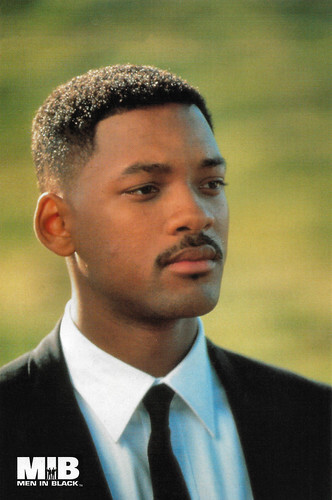
British postcard by Star-Images. London, no. M.012. Photo: Columbia Pictures Industries Inc., 1997. Will Smith in Men in Black (Barry Sonnenfeld, 1997).

British postcard by Heroes Publishing LTD., London, no SPC 3390. Will Smith in Wild Wild West (Barry Sonnenfeld, 1999).
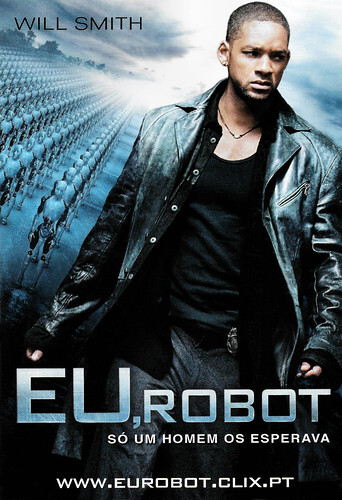
Portuguese freecard by Postalfree. Photo: 20th Century Fox. Will Smith in I, Robot (Alex Proyas, 2004). Caption: Only a man was waiting for them.
The Fresh Prince
Willard Carroll 'Will' Smith Jr. was born in Philadelphia, Pennsylvania, in 1968. He was the son of Caroline (Bright), a Philadelphia school board administrator, and Willard Carroll Smith, Sr., a refrigeration engineer. Smith attended Our Lady of Lourdes, a private Catholic elementary school in Philadelphia and later Overbrook High School. His parents separated when he was 13, but did not actually divorce until around 2000. At school, he was nicknamed "Prince", as he always managed to get out of awkward situations well. In doing so, he spent a lot of time on the playground playing basketball. He loved music and played a lot of hip-hop.
In the late 1980s, Smith achieved modest fame as a rapper under the name The Fresh Prince. Together with Jeffrey Townes (DJ Jazzy Jeff) and Clarence Holmes (Ready Rock C) as the human beatbox, Smith formed DJ Jazzy Jeff & The Fresh Prince with Will as the MC. They scored a number of hits with their humorous, radio-friendly songs such as 'Parents Just Don't Understand', 'Girls ain't Nothing but Trouble' and 'I Think I can beat Mike Tyson'. Their album 'He's the DJ, I'm the Rapper' (1988) became a success in the United States. They received the first-ever Grammy Award for Best Rap Performance, for the song 'Parents Just Don't Understand' in 1989.
In 1990, Smith's popularity increased dramatically when he starred in the popular television series The Fresh Prince of Bel-Air. The show ran for six seasons (1990-1996). Quincy Jones was the producer of the show. Smith played a homeboy from Philly (Philadelphia) who moves in with his fancy aunt and uncle. Bel-Air was chosen as the location, as Quincy Jones' children had grown up there. The series became a huge success. Through this acting experience, Smith was asked for Hollywood productions, where he soon became one of the best-known actors. During The Fresh Prince of Bel-Air, Will Smith set for himself the goal of becoming "the biggest movie star in the world", studying box office successes' common characteristics.
His first major role was in the drama Six Degrees of Separation (Fred Schepisi, 1993). Then followed the buddy film Bad Boys (Michael Bay, 1995) with Martin Lawrence. The action film was made for a budget of $23 million but brought in over $160 million, making it one of the most successful films of that year. Then he starred as part of an ensemble cast in the Sci-Fi film Independence Day (Roland Emmerich, 1996). The film was a massive blockbuster, becoming the second highest-grossing film in history at the time and establishing Smith as a prime box office draw.
Another huge success was the Science Fiction comedy Men in Black (Barry Sonnenfeld, 1997) with Tommy Lee Jones . The Summer hit received critical acclaim for its screenplay, action sequences, and the performances and chemistry of Jones and Smith as Agent J. The film grossed over $589 million worldwide, becoming the third-highest-grossing film of 1997. Smith's film career continued with the crime film Enemy of the State (Tony Scott, 1998), which exposed the power of security services, and the less successful Western Wild Wild West (Barry Sonnenfeld, 1999) with Kevin Kline. The film's screenplay was based on the television series The Wild Wild West (1965-1969). The film was slammed by critics but nevertheless brought in over $220 million. In music, Smith broke through solo in 1997 with the hit 'Men in Black' from the film of the same name and later 'Gettin' Jiggy wit it'. Smith's last album 'Lost and Found' (2005) included the hit single 'Switch'.
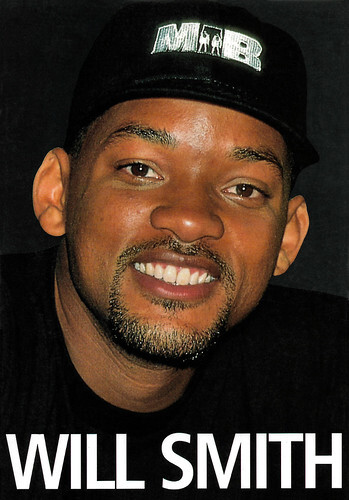
British postcard by Heroes Publishing LTD, London, no. SPC 3148.
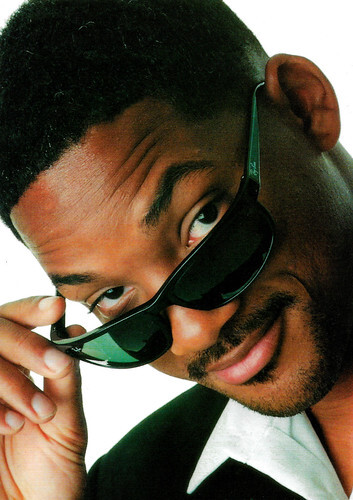
British postcard by Heroes Publishing LTD., London, no SPC 3155.
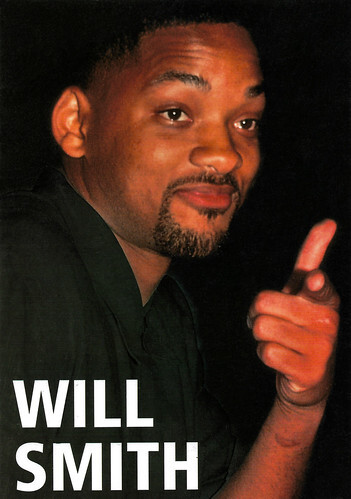
British postcard by Heroes Publishing LTD, London, no. SPC 3172.
A real challenge
After some smaller roles, Will Smith faced a real challenge. He was asked to play Muhammad Ali in the biopic Ali (Michael Mann, 2001). The actor grew an extra 15 kilos of muscle for his role and the film was nominated for the Academy Awards for Best Lead Actor (Smith) and for Best Supporting Actor (Jon Voight). Later in 2001, Smith returned with the slightly less successful sequel to Men in Black, Men in Black II (Barry Sonnenfeld, 2002) again opposite Tommy Lee Jones . Bad Boys was also followed by a sequel, Bad Boys II (Michael Bay, 2003).
The Science Fiction film I, Robot (Alex Proyas, 2004), based on the stories by Isaac Asimov, was a huge box-office success. Later that year, Smith also performed the voice of Oscar in the animated film Shark Tale (Vicky Jenson, Bibo Bergeron, Rob Letterman, 2004). Hitch (Andy Tennant, 2005) was a true comedy that drew a lot of people to the cinema. In 2006, Smith came out with The Pursuit of Happyness (Gabriele Muccino, 2006), a film that also featured his infant son Jaden. For this film, he was nominated for the Academy Award for Best Actor.
In 2007, Smith returned to the blockbuster cinema in the post-apocalyptic Horror, Science Fiction and action film I Am Legend (Francis Lawrence, 2007) which was very successful in cinemas. In it, he plays the survivor of a virus that struck humanity. I Am Legend is an adaptation of the 1954 book by Richard Matheson. The following year, Smith played a lapsed and almost constantly drunk superhero in the film Hancock (Peter Berg, 2008) with Jason Bateman and Charlize Theron, which was well-received as a comedy. Will Smith starred with Tommy Lee Jones again in the successful third part of MIB, Men in Black III (Barry Sonnfeld, 2012). It was his first major starring role in four years and was followed by the ambitious but more or less flopped Sci-Fi film After Earth (M. Night Shyamalan, 2013) in which his son Jaden also starred.
In 2015, the star actor first played the role of a gentleman con man in the ingenious crime film Focus (Glenn Ficarra, John Requa, 2015) with Margot Robbie. Later that year, the biographical sports drama Concussion (Peter Landsman, 2015) was released. The film tells the true story of Dr. Bennet Omalu (Smith), a forensic neuropathologist who was the first to detect a neurodegenerative disease in former NFL players. Then the actor starred in the fantasy film Bright (David Ayer, 2017), released by Netflix, so not seen in cinemas. Smith portrayed the role of Ghost Genie in Aladdin (Guy Ritchie, 2019), the live-action remake of the 1992 Disney animated film of the same name. He returned as Mike Lowrey in the third part of the Bad Boys series, Bad Boys For Life (Adil El Arbi, Bilall Fallah, 2020).
In 2022, Smith won an Oscar for Best Actor for his lead role in the film King Richard (Reinaldo Marcus Green, 2021), about the father of sisters and tennis stars Serena and Venus Williams. At the Oscar ceremony, presenter and comedian Chris Rock was flat-handed by Smith on stage after Rock made a joke about Smith's wife Jada Pinkett Smith. A day later, he publicly apologised to Rock. Two weeks later, the Oscars organisers decided to bar Smith from the Oscars ceremony for ten years. Will Smith married twice. In 1992, he married Sheree Zampino, and together they had one son, Willard Christopher Smith III (1992), aka Trey. He later starred in the music video for 'Just the Two of Us'. Smith divorced Zampino in 1997, after which he married Jada Pinkett in the same year. They have two children together: Jaden Christopher Syre (1998), known for his performances in The Pursuit of Happyness (Gabriele Muccino, 2006), The Karate Kid (Harald Zwart, 2010) and After Earth (M. Night Shyamalan, 2013), and Willow Camille Reign (2000), known for her performance in I Am Legend (Francis Lawrence, 2007).
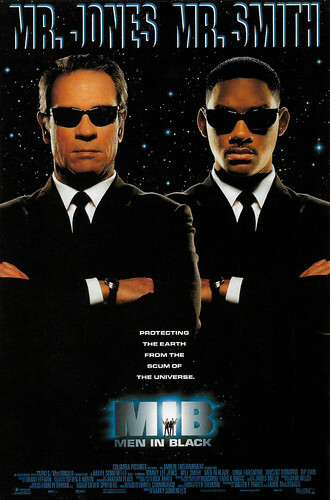
British postcard by Star Images, London, no. M.002. Photo: Columbia Pictures, 1997. Tommy Lee Jones and Will Smith in Men in Black (Barry Sonnenfeld, 1997). Caption: Mr. Jones, Mr. Smith, protecting the Earth from the scum of the universe.
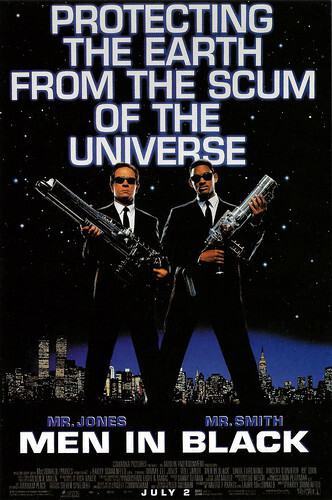
British postcard by Star Images, London, no. M.003. Photo: Columbia Pictures, 1997. Tommy Lee Jones and Will Smith in Men in Black (Barry Sonnenfeld, 1997). Caption: Protecting the Earth from the scum of the universe.
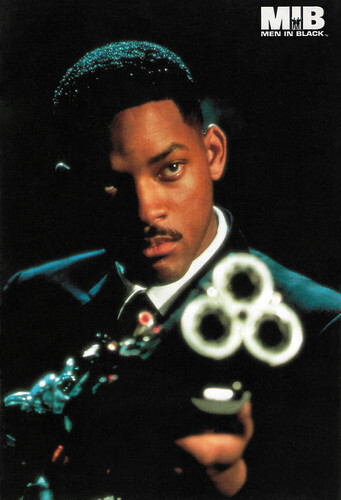
British postcard by Star-Images, London, no. M.011. Photo: Columbia Pictures Industries, Inc. Will Smith in Men in Black (Barry Sonnenfeld, 1997).
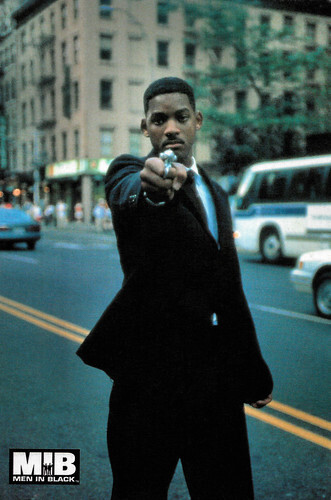
British postcard by Star-Images, London, no. M.014. Photo: Columbia Pictures Industries, Inc. Will Smith in Men in Black (Barry Sonnenfeld, 1997).
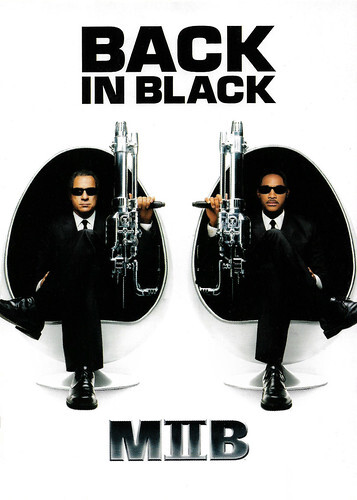
Dutch postcard by Boomerang. Photo: Amblin Entertainment / Columbia Pictures. Tommy Lee Jones and Will Smith in Men in Black II (Barry Sonnenfeld, 2002). Caption: Back in black.
Sources: (IMDb), Wikipedia (Dutch and English) and .

British postcard by Star-Images. London, no. M.012. Photo: Columbia Pictures Industries Inc., 1997. Will Smith in Men in Black (Barry Sonnenfeld, 1997).

British postcard by Heroes Publishing LTD., London, no SPC 3390. Will Smith in Wild Wild West (Barry Sonnenfeld, 1999).

Portuguese freecard by Postalfree. Photo: 20th Century Fox. Will Smith in I, Robot (Alex Proyas, 2004). Caption: Only a man was waiting for them.
The Fresh Prince
Willard Carroll 'Will' Smith Jr. was born in Philadelphia, Pennsylvania, in 1968. He was the son of Caroline (Bright), a Philadelphia school board administrator, and Willard Carroll Smith, Sr., a refrigeration engineer. Smith attended Our Lady of Lourdes, a private Catholic elementary school in Philadelphia and later Overbrook High School. His parents separated when he was 13, but did not actually divorce until around 2000. At school, he was nicknamed "Prince", as he always managed to get out of awkward situations well. In doing so, he spent a lot of time on the playground playing basketball. He loved music and played a lot of hip-hop.
In the late 1980s, Smith achieved modest fame as a rapper under the name The Fresh Prince. Together with Jeffrey Townes (DJ Jazzy Jeff) and Clarence Holmes (Ready Rock C) as the human beatbox, Smith formed DJ Jazzy Jeff & The Fresh Prince with Will as the MC. They scored a number of hits with their humorous, radio-friendly songs such as 'Parents Just Don't Understand', 'Girls ain't Nothing but Trouble' and 'I Think I can beat Mike Tyson'. Their album 'He's the DJ, I'm the Rapper' (1988) became a success in the United States. They received the first-ever Grammy Award for Best Rap Performance, for the song 'Parents Just Don't Understand' in 1989.
In 1990, Smith's popularity increased dramatically when he starred in the popular television series The Fresh Prince of Bel-Air. The show ran for six seasons (1990-1996). Quincy Jones was the producer of the show. Smith played a homeboy from Philly (Philadelphia) who moves in with his fancy aunt and uncle. Bel-Air was chosen as the location, as Quincy Jones' children had grown up there. The series became a huge success. Through this acting experience, Smith was asked for Hollywood productions, where he soon became one of the best-known actors. During The Fresh Prince of Bel-Air, Will Smith set for himself the goal of becoming "the biggest movie star in the world", studying box office successes' common characteristics.
His first major role was in the drama Six Degrees of Separation (Fred Schepisi, 1993). Then followed the buddy film Bad Boys (Michael Bay, 1995) with Martin Lawrence. The action film was made for a budget of $23 million but brought in over $160 million, making it one of the most successful films of that year. Then he starred as part of an ensemble cast in the Sci-Fi film Independence Day (Roland Emmerich, 1996). The film was a massive blockbuster, becoming the second highest-grossing film in history at the time and establishing Smith as a prime box office draw.
Another huge success was the Science Fiction comedy Men in Black (Barry Sonnenfeld, 1997) with Tommy Lee Jones . The Summer hit received critical acclaim for its screenplay, action sequences, and the performances and chemistry of Jones and Smith as Agent J. The film grossed over $589 million worldwide, becoming the third-highest-grossing film of 1997. Smith's film career continued with the crime film Enemy of the State (Tony Scott, 1998), which exposed the power of security services, and the less successful Western Wild Wild West (Barry Sonnenfeld, 1999) with Kevin Kline. The film's screenplay was based on the television series The Wild Wild West (1965-1969). The film was slammed by critics but nevertheless brought in over $220 million. In music, Smith broke through solo in 1997 with the hit 'Men in Black' from the film of the same name and later 'Gettin' Jiggy wit it'. Smith's last album 'Lost and Found' (2005) included the hit single 'Switch'.

British postcard by Heroes Publishing LTD, London, no. SPC 3148.

British postcard by Heroes Publishing LTD., London, no SPC 3155.

British postcard by Heroes Publishing LTD, London, no. SPC 3172.
A real challenge
After some smaller roles, Will Smith faced a real challenge. He was asked to play Muhammad Ali in the biopic Ali (Michael Mann, 2001). The actor grew an extra 15 kilos of muscle for his role and the film was nominated for the Academy Awards for Best Lead Actor (Smith) and for Best Supporting Actor (Jon Voight). Later in 2001, Smith returned with the slightly less successful sequel to Men in Black, Men in Black II (Barry Sonnenfeld, 2002) again opposite Tommy Lee Jones . Bad Boys was also followed by a sequel, Bad Boys II (Michael Bay, 2003).
The Science Fiction film I, Robot (Alex Proyas, 2004), based on the stories by Isaac Asimov, was a huge box-office success. Later that year, Smith also performed the voice of Oscar in the animated film Shark Tale (Vicky Jenson, Bibo Bergeron, Rob Letterman, 2004). Hitch (Andy Tennant, 2005) was a true comedy that drew a lot of people to the cinema. In 2006, Smith came out with The Pursuit of Happyness (Gabriele Muccino, 2006), a film that also featured his infant son Jaden. For this film, he was nominated for the Academy Award for Best Actor.
In 2007, Smith returned to the blockbuster cinema in the post-apocalyptic Horror, Science Fiction and action film I Am Legend (Francis Lawrence, 2007) which was very successful in cinemas. In it, he plays the survivor of a virus that struck humanity. I Am Legend is an adaptation of the 1954 book by Richard Matheson. The following year, Smith played a lapsed and almost constantly drunk superhero in the film Hancock (Peter Berg, 2008) with Jason Bateman and Charlize Theron, which was well-received as a comedy. Will Smith starred with Tommy Lee Jones again in the successful third part of MIB, Men in Black III (Barry Sonnfeld, 2012). It was his first major starring role in four years and was followed by the ambitious but more or less flopped Sci-Fi film After Earth (M. Night Shyamalan, 2013) in which his son Jaden also starred.
In 2015, the star actor first played the role of a gentleman con man in the ingenious crime film Focus (Glenn Ficarra, John Requa, 2015) with Margot Robbie. Later that year, the biographical sports drama Concussion (Peter Landsman, 2015) was released. The film tells the true story of Dr. Bennet Omalu (Smith), a forensic neuropathologist who was the first to detect a neurodegenerative disease in former NFL players. Then the actor starred in the fantasy film Bright (David Ayer, 2017), released by Netflix, so not seen in cinemas. Smith portrayed the role of Ghost Genie in Aladdin (Guy Ritchie, 2019), the live-action remake of the 1992 Disney animated film of the same name. He returned as Mike Lowrey in the third part of the Bad Boys series, Bad Boys For Life (Adil El Arbi, Bilall Fallah, 2020).
In 2022, Smith won an Oscar for Best Actor for his lead role in the film King Richard (Reinaldo Marcus Green, 2021), about the father of sisters and tennis stars Serena and Venus Williams. At the Oscar ceremony, presenter and comedian Chris Rock was flat-handed by Smith on stage after Rock made a joke about Smith's wife Jada Pinkett Smith. A day later, he publicly apologised to Rock. Two weeks later, the Oscars organisers decided to bar Smith from the Oscars ceremony for ten years. Will Smith married twice. In 1992, he married Sheree Zampino, and together they had one son, Willard Christopher Smith III (1992), aka Trey. He later starred in the music video for 'Just the Two of Us'. Smith divorced Zampino in 1997, after which he married Jada Pinkett in the same year. They have two children together: Jaden Christopher Syre (1998), known for his performances in The Pursuit of Happyness (Gabriele Muccino, 2006), The Karate Kid (Harald Zwart, 2010) and After Earth (M. Night Shyamalan, 2013), and Willow Camille Reign (2000), known for her performance in I Am Legend (Francis Lawrence, 2007).

British postcard by Star Images, London, no. M.002. Photo: Columbia Pictures, 1997. Tommy Lee Jones and Will Smith in Men in Black (Barry Sonnenfeld, 1997). Caption: Mr. Jones, Mr. Smith, protecting the Earth from the scum of the universe.

British postcard by Star Images, London, no. M.003. Photo: Columbia Pictures, 1997. Tommy Lee Jones and Will Smith in Men in Black (Barry Sonnenfeld, 1997). Caption: Protecting the Earth from the scum of the universe.

British postcard by Star-Images, London, no. M.011. Photo: Columbia Pictures Industries, Inc. Will Smith in Men in Black (Barry Sonnenfeld, 1997).

British postcard by Star-Images, London, no. M.014. Photo: Columbia Pictures Industries, Inc. Will Smith in Men in Black (Barry Sonnenfeld, 1997).

Dutch postcard by Boomerang. Photo: Amblin Entertainment / Columbia Pictures. Tommy Lee Jones and Will Smith in Men in Black II (Barry Sonnenfeld, 2002). Caption: Back in black.
Sources: (IMDb), Wikipedia (Dutch and English) and .
Published on September 21, 2023 22:00
September 19, 2023
Sie, und die Drei (1922)
Henny Porten (1890-1960) was the star of the German silent comedy Sie, und die Drei/She and the Three (1922), written by Max Jungk and Julius Urgiss and directed by well-known director E.A. Dupont. With her film company Henny Porten-Film, the sturdy and blond actress also was the producer of the film.
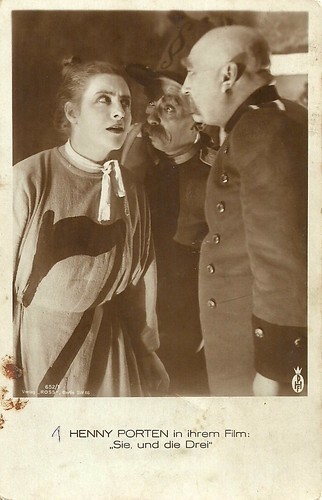
German postcard by Ross Verlag, no. 652/1. Photo: Henny Porten-Film. Henny Porten in Sie und die Drei (E.A. Dupont, 1922). The man on the right could be Jakob Tiedtke .
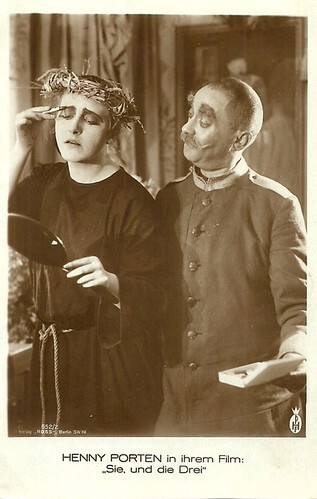
German postcard by Ross Verlag, no. 652/2. Photo: Henny Porten-Film. Henny Porten in Sie und die Drei (E.A. Dupont, 1922).
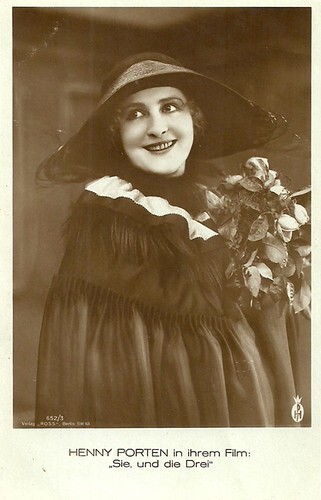
German postcard by Ross Verlag, no. 652/3. Photo: Henny Porten-Film. Henny Porten in Sie und die Drei (E.A. Dupont, 1922).
A celebrated film diva arrested
Henny Porten stars in the German silent comedy Sie, und die Drei/She and the Three (1922) as Lia Lona, a celebrated film diva. One day, when she receives a certificate from a film club that bears her name in her honour, she thinks the man who wants to give her the diploma is a thief. Then things start to get turbulent.
On a riding train, she pulls the emergency brake while escaping and is then arrested. The charge: gross mischief! Lia has to face five days' arrest for her hasty action.
But for the film diva, the punishment turns into an amusing and lively change from everyday acting. She can also cleverly instruct her film team to use this "Vacation from the Self" for the production of semi-documentary shots that she plans to incorporate into her next film.
The Three in the title, Sie, und die Drei, refers to three men around her: the Sweet One ( Hermann Thimig ), the Stormy One (Robert Stolz), and the Unknown One ( Jacob Tiedtke ). The film had additionally an all-star cast of Weimar actors: Blandine Ebinger as the maid, Karl Huszár-Puffy as a film director, and Hermann Picha , Oscar Sabo , Kurt Vespermann , Curt Bois, Fritz Schulz , Toni Zimmerer, Emil Albes, etc.
The film sets and costumes were designed by Ludwig Kainer. Porten's husband Wilhelm von Kaufmann was the production manager. Max Reichmann assisted director Dupont. Sie, und die Drei was shot in the Spring of 1922 and had its premiere on 23 July 1922 at the Berlin cinema Ufa-Palast am Zoo.
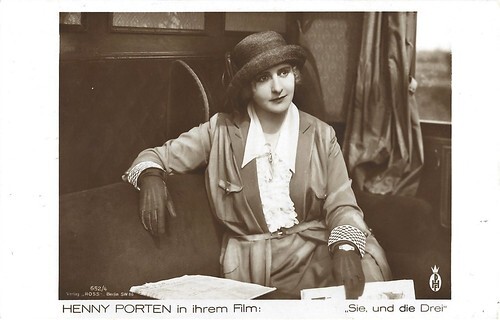
German postcard by Ross Verlag, Berlin, no. 652/4. Photo: Henny Porten-Film. Henny Porten in Sie, und die Drei (E.A. Dupont, 1922).
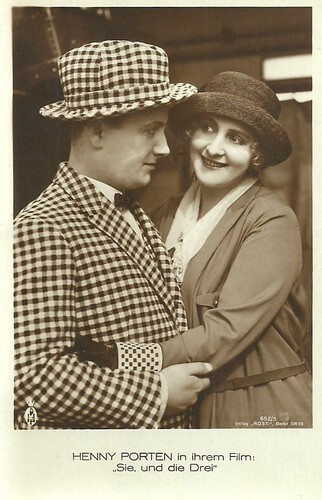
German postcard by Ross Verlag, no. 652/5. Photo: Henny Porten Film. Henny Porten and Hermann Thimig in Sie und die Drei (E.A. Dupont, 1922).
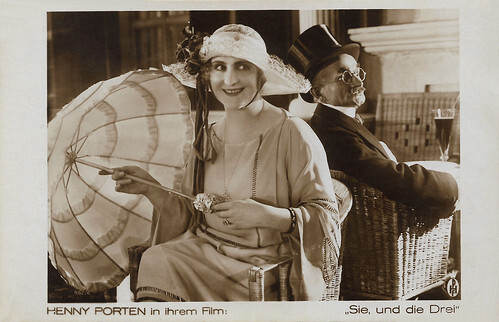
German postcard by Ross Verlag, no. 652/6. Photo: Henny Porten-Film. Henny Porten in Sie, und die Drei (E.A. Dupont, 1922).
Sources: Wikipedia (German and English) and IMDb.

German postcard by Ross Verlag, no. 652/1. Photo: Henny Porten-Film. Henny Porten in Sie und die Drei (E.A. Dupont, 1922). The man on the right could be Jakob Tiedtke .

German postcard by Ross Verlag, no. 652/2. Photo: Henny Porten-Film. Henny Porten in Sie und die Drei (E.A. Dupont, 1922).

German postcard by Ross Verlag, no. 652/3. Photo: Henny Porten-Film. Henny Porten in Sie und die Drei (E.A. Dupont, 1922).
A celebrated film diva arrested
Henny Porten stars in the German silent comedy Sie, und die Drei/She and the Three (1922) as Lia Lona, a celebrated film diva. One day, when she receives a certificate from a film club that bears her name in her honour, she thinks the man who wants to give her the diploma is a thief. Then things start to get turbulent.
On a riding train, she pulls the emergency brake while escaping and is then arrested. The charge: gross mischief! Lia has to face five days' arrest for her hasty action.
But for the film diva, the punishment turns into an amusing and lively change from everyday acting. She can also cleverly instruct her film team to use this "Vacation from the Self" for the production of semi-documentary shots that she plans to incorporate into her next film.
The Three in the title, Sie, und die Drei, refers to three men around her: the Sweet One ( Hermann Thimig ), the Stormy One (Robert Stolz), and the Unknown One ( Jacob Tiedtke ). The film had additionally an all-star cast of Weimar actors: Blandine Ebinger as the maid, Karl Huszár-Puffy as a film director, and Hermann Picha , Oscar Sabo , Kurt Vespermann , Curt Bois, Fritz Schulz , Toni Zimmerer, Emil Albes, etc.
The film sets and costumes were designed by Ludwig Kainer. Porten's husband Wilhelm von Kaufmann was the production manager. Max Reichmann assisted director Dupont. Sie, und die Drei was shot in the Spring of 1922 and had its premiere on 23 July 1922 at the Berlin cinema Ufa-Palast am Zoo.

German postcard by Ross Verlag, Berlin, no. 652/4. Photo: Henny Porten-Film. Henny Porten in Sie, und die Drei (E.A. Dupont, 1922).

German postcard by Ross Verlag, no. 652/5. Photo: Henny Porten Film. Henny Porten and Hermann Thimig in Sie und die Drei (E.A. Dupont, 1922).

German postcard by Ross Verlag, no. 652/6. Photo: Henny Porten-Film. Henny Porten in Sie, und die Drei (E.A. Dupont, 1922).
Sources: Wikipedia (German and English) and IMDb.
Published on September 19, 2023 22:00
Georg Alexander
Georg Alexander (1888-1945) was a German actor, director and producer. He belonged to the busiest actors of his times and his career continued smoothly till his death.
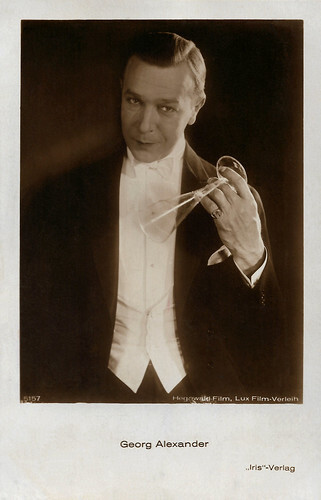
Austrian postcard by Iris Verlag, no. 5157. Photo: Hegewald Film / Lux Film-Verleih.
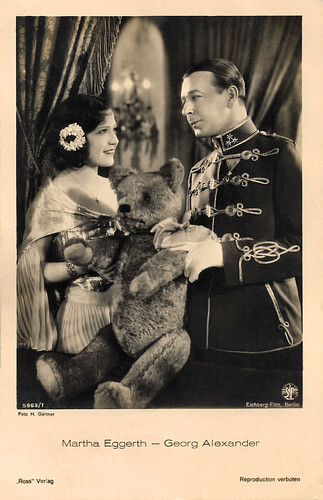
German postcard by Ross Verlag, no. 5969/1, 1930-1931. Photo: H. Gärner / Eichberg-Film / SF. Marta Eggerth and Georg Alexander in Die Bräutigamswitwe/The widow of the groom (Richard Eichberg, 1931).
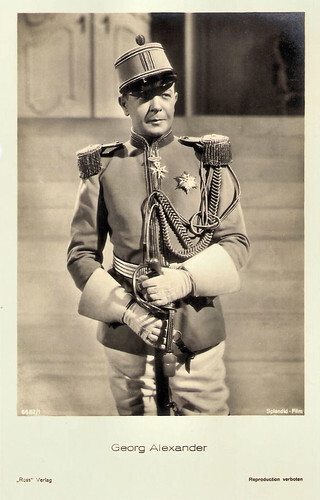
German postcard by Ross Verlag, no. 6482/1, 1931-1932. Photo: Splendid-Film. Georg Alexander in Durchlaucht amüsiert sich (Conrad Wiene, 1932).
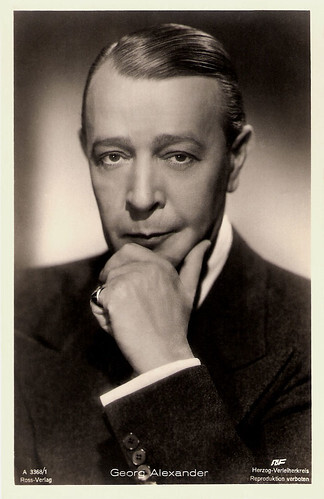
German postcard by Ross-Verlag, no. A 3368/1, 1941-1944. Photo: FDF / Herzog Verleiher-kreiz.
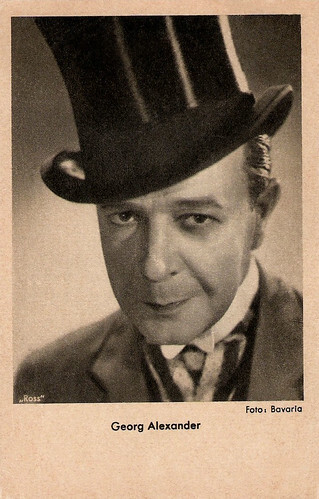
German postcard by Das Programm von Heute, Zeitschrift für Film und Theater G.m.b.H., Berlin. Licensed by Ross Verlag, Berlin. Photo: Bavaria.
Aud Egede Nissen
Georg (alternate name George) Alexander was born Werner Louis Georg Lueddeckens in Hannover, Germany in 1888. He made his theatrical debut in Halberstadt and then acted at various theatres in Hamburg, Hanover and from 1914 Berlin.
On stage and later in the film, his speciality was playing genteel bon vivants, fops and philistines. He made his film debut in 1915 in Der Schwiegervater seines Leutnants/The Father-in-law of His Lieutenant, followed by Sonne und Schatten/Sun and Shadow (Paul von Woringen, 1915).
In 1917 he married the Norwegian actress Aud Egede Nissen . Their son Georg Richter later also became a well-known actor in Norway.
With Aud Egede Nissen , he founded their own production company, the Egede-Nissen-Film Comp. mbH in Berlin in 1917. Their first film project was Die Geburt der Venus/The Birth of Venus (Georg Alexander, 1917).
Till 1919, Georg Alexander directed and produced circa 30 silent films.
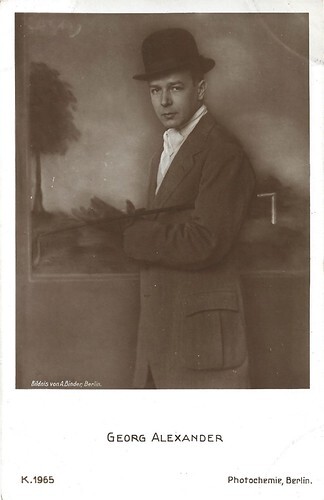
German postcard by Photochemie, no. K. 1965. Photo: Alex Binder, Berlin.
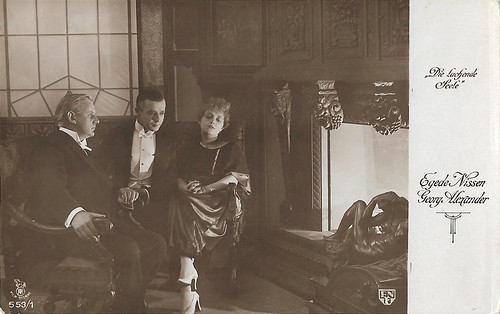
German postcard by Rotophot in the Film-Sterne series, no. 553/1. Photo: ENF (Egede-Nissen-Film). Aud Egede Nissen and Georg Alexander in the German silent film Die lachende Seele/The Laughing Soul (Georg Alexander, 1919).
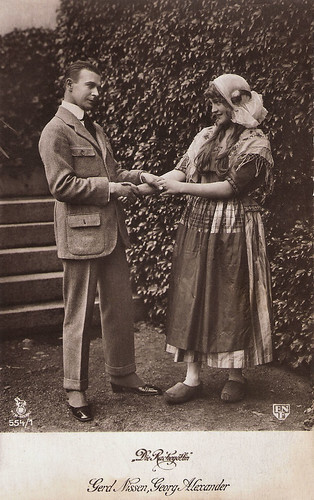
German postcard by Rotophot in the Film Sterne series, no. 554/1. Photo: ENF (Egede-Nissen-Film). Gerd Egede-Nissen and Georg Alexander in the German silent film Die Rachegöttin (Georg Alexander, 1918).
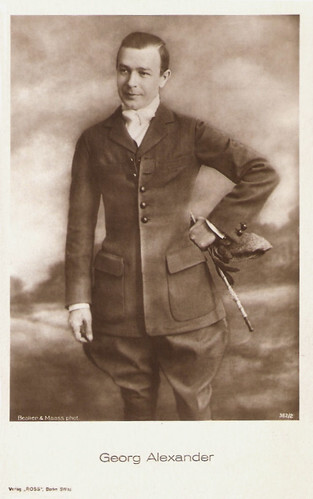
German postcard by Ross Verlag, Berlin, no. 362/2, 1919-1924. Photo: Becker & Maass.
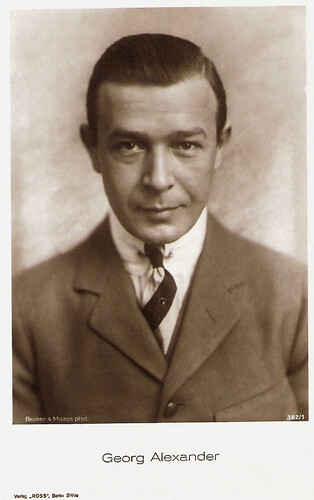
German postcard by Ross Verlag, Berlin, no. 382/1, 1919-1924. Photo: Becker & Maass.
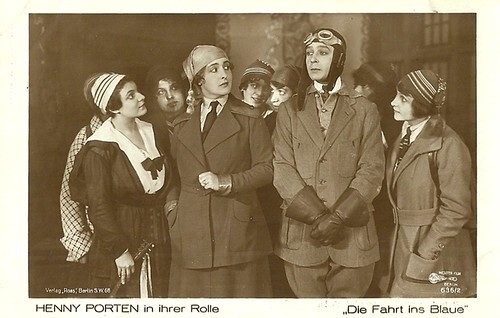
German postcard by Ross Verlag, no, 636/2. Photo: Messter Film. Henny Porten and Georg Alexander in the German silent comedy Die Fahrt ins Blaue (Rudolf Biebrach, 1919). The film was scripted by Hanns Kräly and cinematographed by Willy Gaebel.
Detective films
In 1919, Georg Alexander founded his own company Alexander-Film-GmbH with which he made sports films showing outstanding sporting performances.
He himself was also active as a racing driver and jockey. He even set up a new record with a horse jump over the height of 1.85 meters.
in 1919 he also started to concentrate on acting again. Alexander often played in detective films like the adventure serial Der Mann ohne Namen/The Man Without a Name (Georg Jacoby, 1921). He played the comic role of detective Bobby Dodd alongside Harry Liedtke 's master thief Peter Voss.
He also starred in such entertainment films and salon comedies as Lady Hamilton (Richard Oswald, 1921), Eifersucht/Jealousy (Karl Grune, 1925) starring Lya de Putti and Die Frau ohne Namen/The Woman Without a Name (Georg Jacoby, 1927).
Then he appeared in Venus im Frack/Venus in Tails (Robert Land, 1927), and Schwarzwaldmädel/Girl from the Black Woods (Victor Janson, 1929) with Liane Haid .
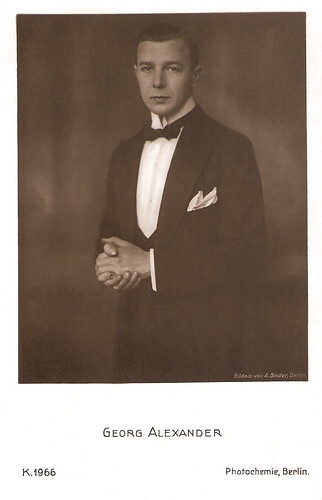
German postcard by Photochemie, Berlin, no. K.1966. Photo: A. Binder, Berlin.
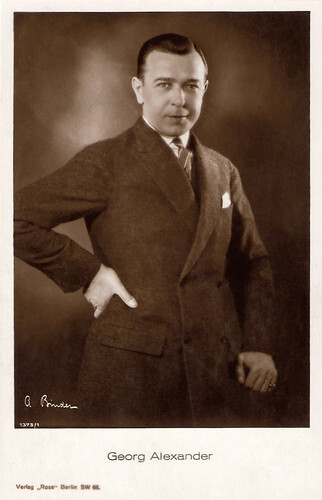
German postcard by Ross Verlag, no. 1373/1, 1927-1928. Photo: A. Binder, Berlin.
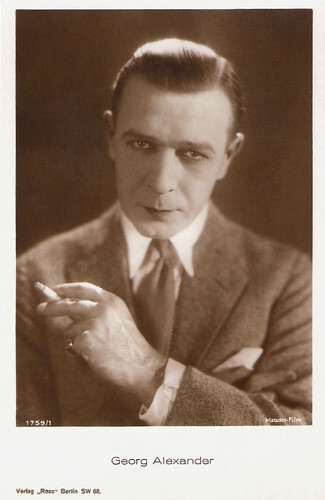
German postcard by Ross Verlag, Berlin, no. 1759/1, 1927-1928. Photo: Matador-Film.
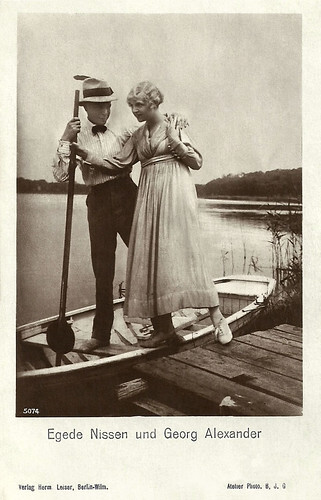
German postcard by Verlag Hermann Leiser, Berlin, no. 5074. Photo: Atelier B.J.G.
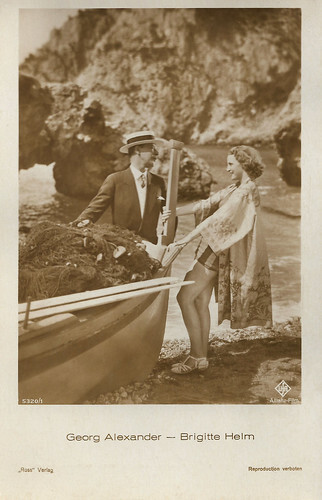
German postcard by Ross Verlag, Berlin, no. 5320/1, 1930-1931. Photo: Allianz-Film / Ufa. Georg Alexander and Brigitte Helm in Die singende Stadt/The Singing City (Carmine Gallone, 1930).
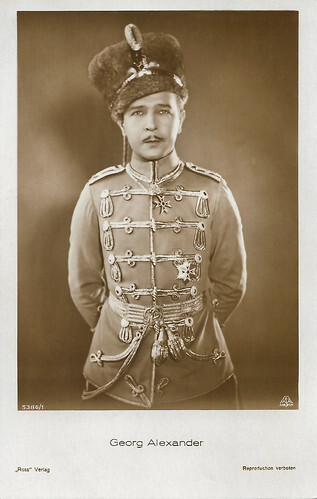
German postcard by Ross Verlag, no. 5368/1, 1930-1931. Photo: AAFA Film. Georg Alexander in Leutnant warst Du einst bei deinen Husaren/Love Comes But Once (Manfred Noa, 1930).
Distinguished bon vivant
In the 1930s Georg Alexander often appeared as a distinguished Bon Vivant or a snobbish nobleman in such comedies as Wie sag ich's meinem Mann/How Shall I Tell My Husband? (Reinhold Schünzel, 1932) with Liane Haid , and Die englische Heirat/The English Marriage (Reinhold Schünzel, 1934), in which he starred with Adele Sandrock .
He also played Archduke Peter Ferdinand in Liebeswalzer/The Love Waltz (Wilhelm Thiele, 1932) opposite Lilian Harvey and Willy Fritsch and Mamsell Nitouche/Miss Nitouche(Carl Lamac, 1932) with Anny Ondra .
Alexander also acted in such dramas as Der alte und der junge König/The Making of a King (Hans Steinhoff, 1935), Heimat/Magda (Carl Froelich, 1938) starring Zarah Leander and Der Kleinstadtpoet/The Poet of a Small Town (Josef von Baky, 1940).
During the war, he appeared in Frau Luna/Mistress Moon (Theo Lingen, 1942) with Lizzi Waldmüller . His last film was the very funny musical Die Frau meiner Träume/The Woman of My Dreams (Georg Jacoby, 1944) starring Marika Rökk . In total, Georg Alexander worked on more than 160 films.
Immediately after the end of the war, he became the artistic director of the Potsdam Schauspielhaus, which had been largely destroyed. Georg Alexander died in Berlin in 1945. In 1928 he was married in his third marriage to the film agent Ilse Brach. His gravesite at the Wilmersdorf cemetery in Berlin-Wilmersdorf was closed in 1960.
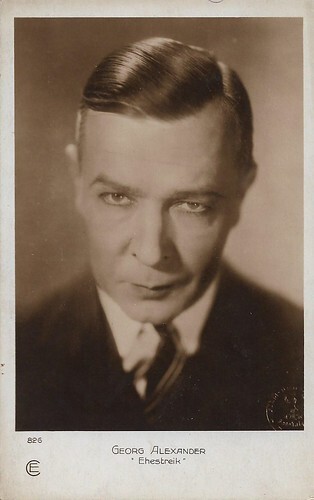
French postcard by Cinémagazine-Edition, no. 826. Georg Alexander in the German late silent film Ehestreik/Marriage Strike (Carl Boese, 1930).
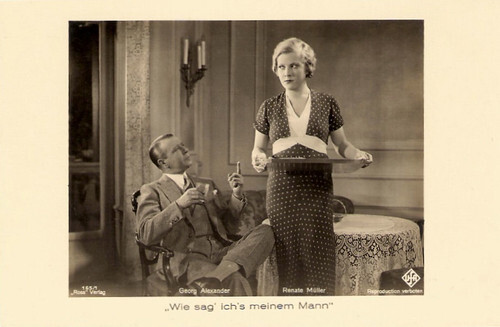
German postcard by Ross Verlag, no. 165/1. Photo: Ufa. Georg Alexander and Renate Müller in Wie sag ich's meinem Mann/How Shall I Tell My Husband? (Reinhold Schünzel, 1932).
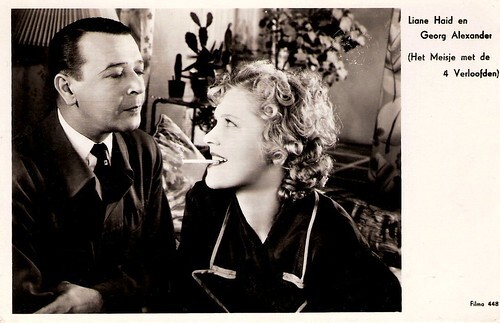
Dutch postcard by Filma, no. 448. Georg Alexander and Liane Haid in Eine Frau wie Du/A Woman Like You (Carl Boese, 1933).
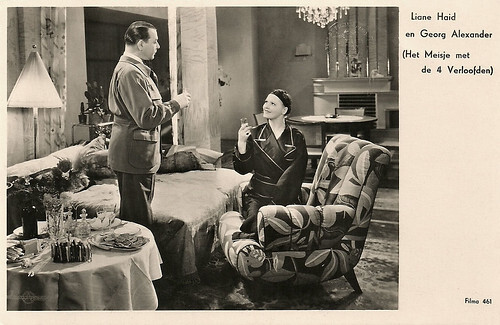
Dutch postcard by Filma, no. 461. Photo: publicity still of Liane Haid and Georg Alexander in the comedy Het meisje met de 4 verloofden/Eine Frau wie Du/A Woman Like You (Carl Boese, 1933).
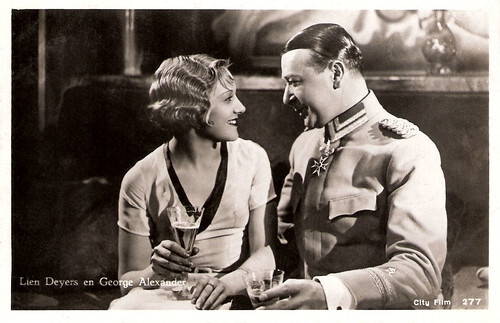
Dutch postcard by City Film, no. 277. Lien Deyers and Georg Alexander in Ist mein Mann nicht fabelhaft?/Isn't My Husband Wonderful? (Georg Jacoby, 1933). Collection: Geoffrey Donaldson Institute.
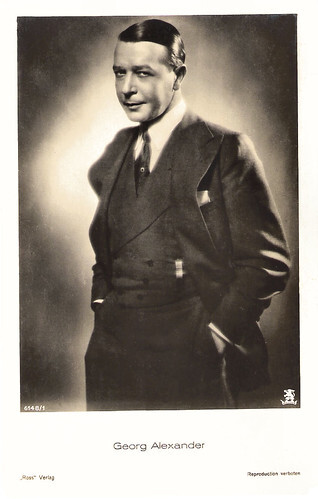
German postcard by Ross Verlag, no. 6148/1, 1931-1932.
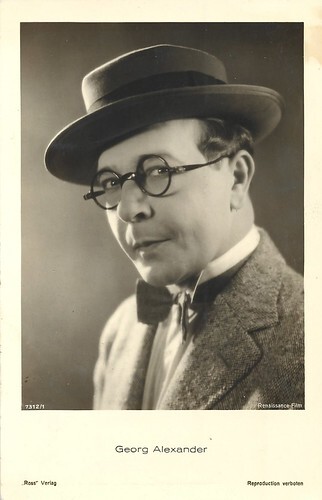
German postcard by Ross Verlag, no. 7312/1, 1932-1933. Photo: Renaissance Film. George Alexander in the German comedy crime film Flucht nach Nizza/The Escape to Nizza (James Bauer, 1933).
Sources: Thomas Staedeli (Cyranos), Filmportal, Wikipedia (German), and .

Austrian postcard by Iris Verlag, no. 5157. Photo: Hegewald Film / Lux Film-Verleih.

German postcard by Ross Verlag, no. 5969/1, 1930-1931. Photo: H. Gärner / Eichberg-Film / SF. Marta Eggerth and Georg Alexander in Die Bräutigamswitwe/The widow of the groom (Richard Eichberg, 1931).

German postcard by Ross Verlag, no. 6482/1, 1931-1932. Photo: Splendid-Film. Georg Alexander in Durchlaucht amüsiert sich (Conrad Wiene, 1932).

German postcard by Ross-Verlag, no. A 3368/1, 1941-1944. Photo: FDF / Herzog Verleiher-kreiz.

German postcard by Das Programm von Heute, Zeitschrift für Film und Theater G.m.b.H., Berlin. Licensed by Ross Verlag, Berlin. Photo: Bavaria.
Aud Egede Nissen
Georg (alternate name George) Alexander was born Werner Louis Georg Lueddeckens in Hannover, Germany in 1888. He made his theatrical debut in Halberstadt and then acted at various theatres in Hamburg, Hanover and from 1914 Berlin.
On stage and later in the film, his speciality was playing genteel bon vivants, fops and philistines. He made his film debut in 1915 in Der Schwiegervater seines Leutnants/The Father-in-law of His Lieutenant, followed by Sonne und Schatten/Sun and Shadow (Paul von Woringen, 1915).
In 1917 he married the Norwegian actress Aud Egede Nissen . Their son Georg Richter later also became a well-known actor in Norway.
With Aud Egede Nissen , he founded their own production company, the Egede-Nissen-Film Comp. mbH in Berlin in 1917. Their first film project was Die Geburt der Venus/The Birth of Venus (Georg Alexander, 1917).
Till 1919, Georg Alexander directed and produced circa 30 silent films.

German postcard by Photochemie, no. K. 1965. Photo: Alex Binder, Berlin.

German postcard by Rotophot in the Film-Sterne series, no. 553/1. Photo: ENF (Egede-Nissen-Film). Aud Egede Nissen and Georg Alexander in the German silent film Die lachende Seele/The Laughing Soul (Georg Alexander, 1919).

German postcard by Rotophot in the Film Sterne series, no. 554/1. Photo: ENF (Egede-Nissen-Film). Gerd Egede-Nissen and Georg Alexander in the German silent film Die Rachegöttin (Georg Alexander, 1918).

German postcard by Ross Verlag, Berlin, no. 362/2, 1919-1924. Photo: Becker & Maass.

German postcard by Ross Verlag, Berlin, no. 382/1, 1919-1924. Photo: Becker & Maass.

German postcard by Ross Verlag, no, 636/2. Photo: Messter Film. Henny Porten and Georg Alexander in the German silent comedy Die Fahrt ins Blaue (Rudolf Biebrach, 1919). The film was scripted by Hanns Kräly and cinematographed by Willy Gaebel.
Detective films
In 1919, Georg Alexander founded his own company Alexander-Film-GmbH with which he made sports films showing outstanding sporting performances.
He himself was also active as a racing driver and jockey. He even set up a new record with a horse jump over the height of 1.85 meters.
in 1919 he also started to concentrate on acting again. Alexander often played in detective films like the adventure serial Der Mann ohne Namen/The Man Without a Name (Georg Jacoby, 1921). He played the comic role of detective Bobby Dodd alongside Harry Liedtke 's master thief Peter Voss.
He also starred in such entertainment films and salon comedies as Lady Hamilton (Richard Oswald, 1921), Eifersucht/Jealousy (Karl Grune, 1925) starring Lya de Putti and Die Frau ohne Namen/The Woman Without a Name (Georg Jacoby, 1927).
Then he appeared in Venus im Frack/Venus in Tails (Robert Land, 1927), and Schwarzwaldmädel/Girl from the Black Woods (Victor Janson, 1929) with Liane Haid .

German postcard by Photochemie, Berlin, no. K.1966. Photo: A. Binder, Berlin.

German postcard by Ross Verlag, no. 1373/1, 1927-1928. Photo: A. Binder, Berlin.

German postcard by Ross Verlag, Berlin, no. 1759/1, 1927-1928. Photo: Matador-Film.

German postcard by Verlag Hermann Leiser, Berlin, no. 5074. Photo: Atelier B.J.G.

German postcard by Ross Verlag, Berlin, no. 5320/1, 1930-1931. Photo: Allianz-Film / Ufa. Georg Alexander and Brigitte Helm in Die singende Stadt/The Singing City (Carmine Gallone, 1930).

German postcard by Ross Verlag, no. 5368/1, 1930-1931. Photo: AAFA Film. Georg Alexander in Leutnant warst Du einst bei deinen Husaren/Love Comes But Once (Manfred Noa, 1930).
Distinguished bon vivant
In the 1930s Georg Alexander often appeared as a distinguished Bon Vivant or a snobbish nobleman in such comedies as Wie sag ich's meinem Mann/How Shall I Tell My Husband? (Reinhold Schünzel, 1932) with Liane Haid , and Die englische Heirat/The English Marriage (Reinhold Schünzel, 1934), in which he starred with Adele Sandrock .
He also played Archduke Peter Ferdinand in Liebeswalzer/The Love Waltz (Wilhelm Thiele, 1932) opposite Lilian Harvey and Willy Fritsch and Mamsell Nitouche/Miss Nitouche(Carl Lamac, 1932) with Anny Ondra .
Alexander also acted in such dramas as Der alte und der junge König/The Making of a King (Hans Steinhoff, 1935), Heimat/Magda (Carl Froelich, 1938) starring Zarah Leander and Der Kleinstadtpoet/The Poet of a Small Town (Josef von Baky, 1940).
During the war, he appeared in Frau Luna/Mistress Moon (Theo Lingen, 1942) with Lizzi Waldmüller . His last film was the very funny musical Die Frau meiner Träume/The Woman of My Dreams (Georg Jacoby, 1944) starring Marika Rökk . In total, Georg Alexander worked on more than 160 films.
Immediately after the end of the war, he became the artistic director of the Potsdam Schauspielhaus, which had been largely destroyed. Georg Alexander died in Berlin in 1945. In 1928 he was married in his third marriage to the film agent Ilse Brach. His gravesite at the Wilmersdorf cemetery in Berlin-Wilmersdorf was closed in 1960.

French postcard by Cinémagazine-Edition, no. 826. Georg Alexander in the German late silent film Ehestreik/Marriage Strike (Carl Boese, 1930).

German postcard by Ross Verlag, no. 165/1. Photo: Ufa. Georg Alexander and Renate Müller in Wie sag ich's meinem Mann/How Shall I Tell My Husband? (Reinhold Schünzel, 1932).

Dutch postcard by Filma, no. 448. Georg Alexander and Liane Haid in Eine Frau wie Du/A Woman Like You (Carl Boese, 1933).

Dutch postcard by Filma, no. 461. Photo: publicity still of Liane Haid and Georg Alexander in the comedy Het meisje met de 4 verloofden/Eine Frau wie Du/A Woman Like You (Carl Boese, 1933).

Dutch postcard by City Film, no. 277. Lien Deyers and Georg Alexander in Ist mein Mann nicht fabelhaft?/Isn't My Husband Wonderful? (Georg Jacoby, 1933). Collection: Geoffrey Donaldson Institute.

German postcard by Ross Verlag, no. 6148/1, 1931-1932.

German postcard by Ross Verlag, no. 7312/1, 1932-1933. Photo: Renaissance Film. George Alexander in the German comedy crime film Flucht nach Nizza/The Escape to Nizza (James Bauer, 1933).
Sources: Thomas Staedeli (Cyranos), Filmportal, Wikipedia (German), and .
Published on September 19, 2023 22:00
September 18, 2023
Tina Di Lorenzo
Tina Di Lorenzo (1872-1930) was one of the 'grand dames' of the Italian stage during the early twentieth century, nicknamed 'Angelicata' and 'La encantadora'. In 1915 she also acted in two or three films. In 1901 she married reputed stage actor Armando Falconi, who would have a second career in Italian sound cinema.
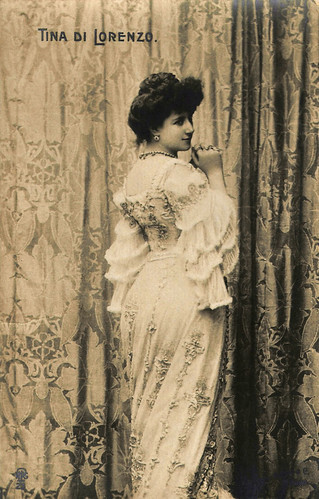
Italian postcard by NPG, no. 23. Photo: Varischi Artico & C., Milano.
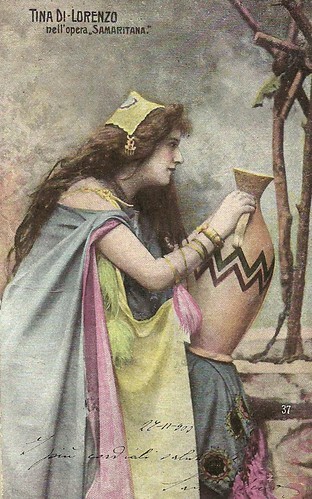
Italian postcard by U.Z.M., no. 37. Tina Di Lorenzo in the play 'La Samaritana', written by Edmond Rostand as a work spoken in verse, first performed in May 1895. It was a huge success for Di Lorenzo.
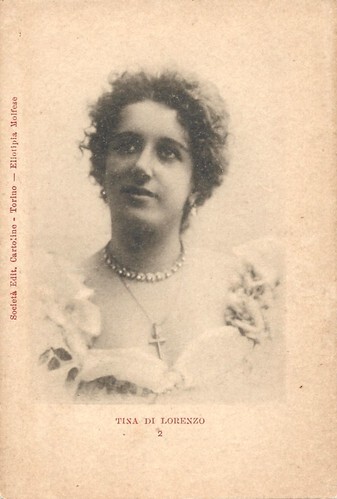
Italian postcard by Società Edit. Cartoline, Eliotipia Molfese, Torino, no. 2. Photo: Brogi.
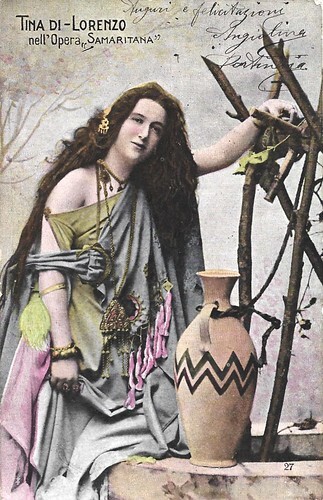
Italian postcard by U.Z.M., no. 27. Tina Di Lorenzo in the play 'La Samaritana', written by Edmond Rostand.
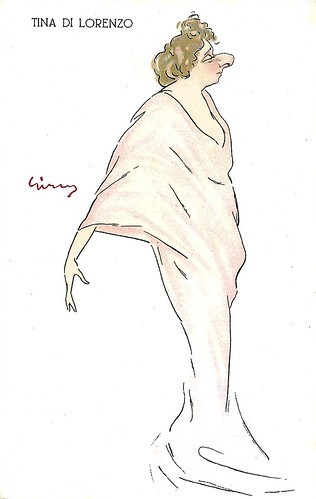
Italian postcard by CCM. Caricature by Girus (Giuseppe Russo, 1888-1960).
The anti-Duse
Tina Di Lorenzo was born in Turin in 1872 from the union between a Sicilian nobleman, Marquis Corrado Di Lorenzo di Castelluccio, and the actress Amelia Colonnello. Her father was a descendant of the Marquis of Castelluccio di Noto, a noble Sicilian family, while her mother was also from a noble family and lady-in-waiting to Queen Elena of Savoy.
At the age of 13, she trained in the dramatic arts in Naples and embarked on an acting career under the stage name Tina Di Lorenzo. Success came to her in 1889, at the Teatro Rossini in Naples, during a performance of 'Ruit hora' by Francesco Proto, Duke of Maddaloni, after which the press praised her great acting skills. Two years later, she was already the first actress in the Pasta company, with which she did a successful tour in Argentina.
On her return, she triumphed in Italy in such plays as 'Divorziamo' by Victorien Sardou, 'La trilogia di Dorina' by Rovetta, 'Le vergine' by Praga, 'Fedora' by Sardou, etc. She searched rather for bourgeois realism than for D'Annunzian exaltation. Indeed, Di Lorenzo was seen as the anti-Duse at that time. While some thought she was only really good in bourgeois comedy, she proved to be a good dramatic actress too in plays such as Bracco's 'Maternità' and Rostand's 'La Samaritana', showing she could be more than the wholesome, modest and joyful Italian woman.
In 1897, Tina Di Lorenzo joined Flavio Andò's company for a series of highly acclaimed performances throughout Italy. They also did an extensive tour through Eastern Europe, with plays such as 'Magda', 'Adrienne Lecouvreur' and 'La dame aux camélias'. She possessed a rare beauty, a melodious voice and the manners of a great lady despite her young age: she earned the nickname 'Angelicata' from her worshippers.
She was consecrated as a rising star of dramatic art and soon became one of the most sought-after actresses and sought-after by the chiefs. She toured extensively abroad, especially in Latin America. Thanks to her talent and beauty, she was nicknamed 'Encantadora' in Argentina. A friend of the "Red Count" Emanuele Bricherasio, in 1899 she became the first testimonial of the newly founded FIAT, posing on the Valentino avenues for an advertising photo, driving the "3 ½ HP" model.
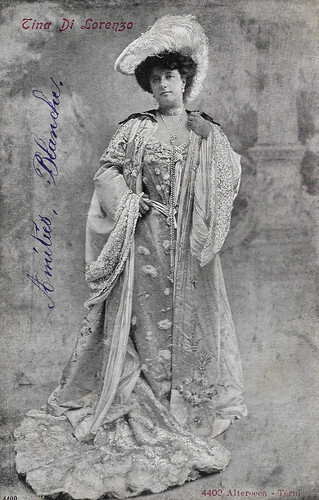
French-Italian postcard by Alterocca, Terni, no. 4400. Sent by mail in 1905.
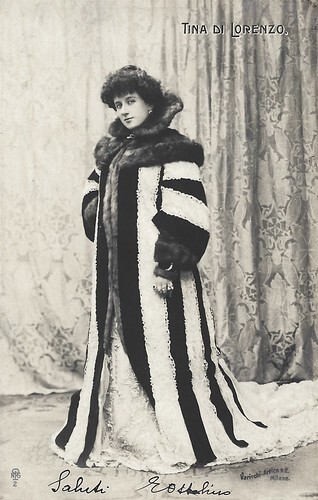
Italian postcard by NPG, no. 2.Photo: Varischi Artico & C., Milano.
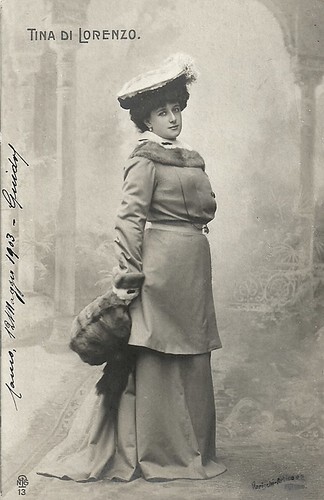
Italian postcard by NPG, no. 13. Photo: Varischi Artico & C., Milano. Sent by mail on 12 May 1903.
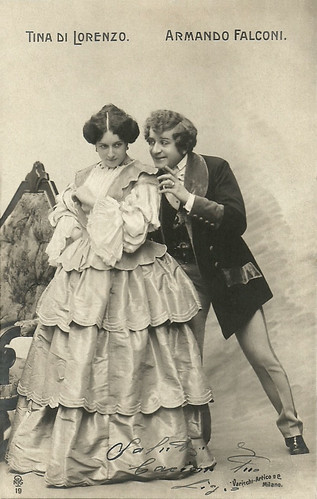
Italian postcard by NPG, no. 19. Photo: Varischi Artico & C., Milano. Armando Falconi and Tina Di Lorenzo.
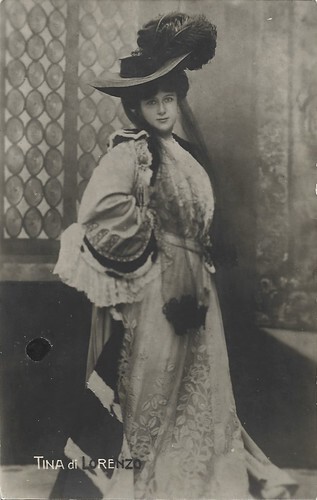
French postcard by P.P. & F. g. T.
A fortunately bloodless duel fought with pistols
In 1901 Tina Di Lorenzo married her cousin Armando Falconi , also an actor. Their love story began during a tour in Hungary, during which he defended her from the attacks of a journalist who painted Di Lorenzo in unflattering tones. Following a fortunately bloodless duel fought with pistols, Falconi prevailed and earned the love of his cousin, from whom their son Dino was born, a future writer-director.
Tina Di Lorenzo was part of numerous companies, from the Stabile del Teatro Manzoni in Milan (from 1912 to 1914) where she was prima donna, to the company of Francesco Pasta and Enrico Reinach to that of Flavio Andò, reaping an extraordinary and uninterrupted series of successes.
Tina Di Lorenzo participated in only three films. All three were made in 1915 at the Ambrosio company of Turin. Twice she acted together with her husband, Armando Falconi , in La scintilla (Eleuterio Rodolfi, 1915) and La bella mamma (Eleuterio Rodolfi, 1915). She acted opposite Annibale Ninchi in La gorgona (Mario Caserini, 1915). Only IMDb mentions the latter film, but she is not listed in Vittorio Martinelli's repertory 'Il cinema muto italiano ' as being part of the cast.
In her film debut La scintilla, based on a play by Alfredo Testoni, she is the naive wife of a man ( Oreste Bilancia ) who has a mistress, while the wife herself is courted by a young painter ( Armando Falconi ). When she finds out about her husband's affair she is so devastated that she almost makes a fatal misstep with the painter, but her young daughter saves the marriage and family. The press praised the performances by Di Lorenzo and Falconi but also realised this film was perhaps not made for the broad audience of cinema, lacking also the witty dialogues from the stage version. Di Lorenzo was by now a mature actress and not the young adult from the plot anymore. Yet, she remained convincing and touching, and all the pros were much more important than the cons. On the other hand, in her second film, La bella mama, in which she rivals as a mother with her daughter, played by Fernanda Negri Pouget , the press was less positive. It may have caused her to stop film acting, and focus on the stage.
Di Lorenzo retired to private life in the years between 1918 and 1920, returning to the stage only once, in 1926, at the Teatro Drammatico Nazionale in Rome, for an edition of Goldoni's 'La locandiera'. She died prematurely in Milan in 1930. That same year, a street in the city of Livorno was named after her. The Municipal Administration of Noto honoured its illustrious daughter Tina Di Lorenzo by naming the city's municipal theatre after her in 2011. Angelo Fortuna dedicated an intense biography to her: 'Tina Di Lorenzo. Il fascino e l'arte della encantadora'.
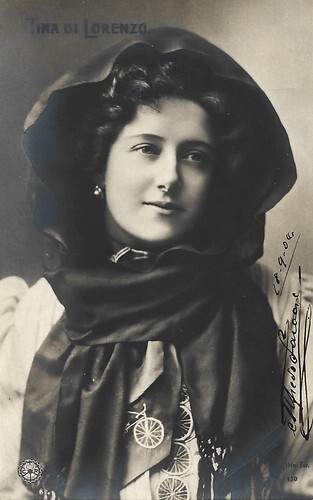
Italian postcard by TCR, no. 130. Photo: Bettini.
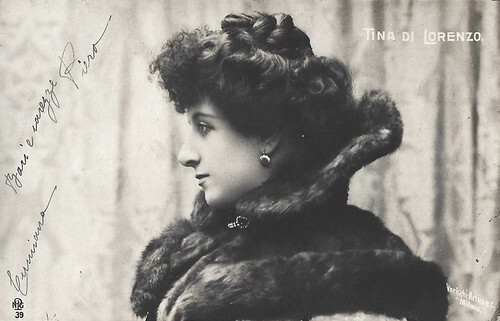
Italian postcard by NPG, no. 39. Photo: Varischi Artico & C., Milano.
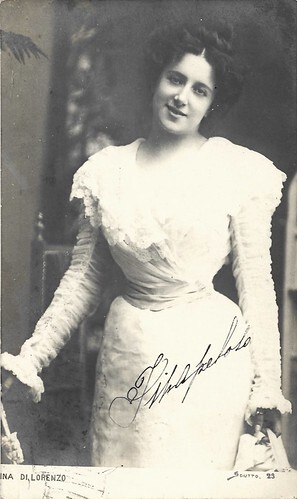
Italian postcard, no. 23. Photo: Sciutto.
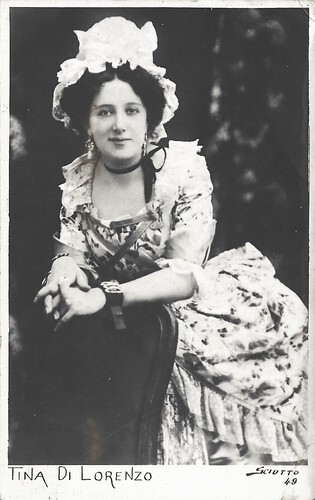
Italian postcard, no. 49. Photo: Sciutto.
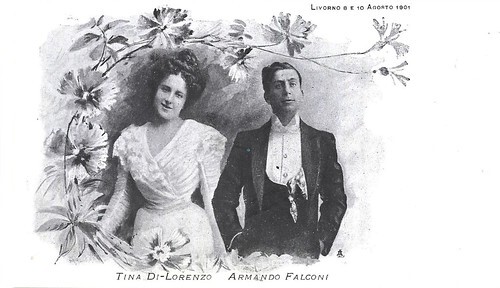
Italian postcard by prob. Alterocca, Terni. Commemoration of the marriage of the actors Tina Di Lorenzo and Armando Falconi , in Livorno on 8 and 10 August 1901.
Sources: Roberta Ascarelli (Dizionario Biografico degli Italiani), Vittorio Martinelli (Il cinema muto italiano, 1915 - Vol. I and II), Wikipedia and .

Italian postcard by NPG, no. 23. Photo: Varischi Artico & C., Milano.

Italian postcard by U.Z.M., no. 37. Tina Di Lorenzo in the play 'La Samaritana', written by Edmond Rostand as a work spoken in verse, first performed in May 1895. It was a huge success for Di Lorenzo.

Italian postcard by Società Edit. Cartoline, Eliotipia Molfese, Torino, no. 2. Photo: Brogi.

Italian postcard by U.Z.M., no. 27. Tina Di Lorenzo in the play 'La Samaritana', written by Edmond Rostand.

Italian postcard by CCM. Caricature by Girus (Giuseppe Russo, 1888-1960).
The anti-Duse
Tina Di Lorenzo was born in Turin in 1872 from the union between a Sicilian nobleman, Marquis Corrado Di Lorenzo di Castelluccio, and the actress Amelia Colonnello. Her father was a descendant of the Marquis of Castelluccio di Noto, a noble Sicilian family, while her mother was also from a noble family and lady-in-waiting to Queen Elena of Savoy.
At the age of 13, she trained in the dramatic arts in Naples and embarked on an acting career under the stage name Tina Di Lorenzo. Success came to her in 1889, at the Teatro Rossini in Naples, during a performance of 'Ruit hora' by Francesco Proto, Duke of Maddaloni, after which the press praised her great acting skills. Two years later, she was already the first actress in the Pasta company, with which she did a successful tour in Argentina.
On her return, she triumphed in Italy in such plays as 'Divorziamo' by Victorien Sardou, 'La trilogia di Dorina' by Rovetta, 'Le vergine' by Praga, 'Fedora' by Sardou, etc. She searched rather for bourgeois realism than for D'Annunzian exaltation. Indeed, Di Lorenzo was seen as the anti-Duse at that time. While some thought she was only really good in bourgeois comedy, she proved to be a good dramatic actress too in plays such as Bracco's 'Maternità' and Rostand's 'La Samaritana', showing she could be more than the wholesome, modest and joyful Italian woman.
In 1897, Tina Di Lorenzo joined Flavio Andò's company for a series of highly acclaimed performances throughout Italy. They also did an extensive tour through Eastern Europe, with plays such as 'Magda', 'Adrienne Lecouvreur' and 'La dame aux camélias'. She possessed a rare beauty, a melodious voice and the manners of a great lady despite her young age: she earned the nickname 'Angelicata' from her worshippers.
She was consecrated as a rising star of dramatic art and soon became one of the most sought-after actresses and sought-after by the chiefs. She toured extensively abroad, especially in Latin America. Thanks to her talent and beauty, she was nicknamed 'Encantadora' in Argentina. A friend of the "Red Count" Emanuele Bricherasio, in 1899 she became the first testimonial of the newly founded FIAT, posing on the Valentino avenues for an advertising photo, driving the "3 ½ HP" model.

French-Italian postcard by Alterocca, Terni, no. 4400. Sent by mail in 1905.

Italian postcard by NPG, no. 2.Photo: Varischi Artico & C., Milano.

Italian postcard by NPG, no. 13. Photo: Varischi Artico & C., Milano. Sent by mail on 12 May 1903.

Italian postcard by NPG, no. 19. Photo: Varischi Artico & C., Milano. Armando Falconi and Tina Di Lorenzo.

French postcard by P.P. & F. g. T.
A fortunately bloodless duel fought with pistols
In 1901 Tina Di Lorenzo married her cousin Armando Falconi , also an actor. Their love story began during a tour in Hungary, during which he defended her from the attacks of a journalist who painted Di Lorenzo in unflattering tones. Following a fortunately bloodless duel fought with pistols, Falconi prevailed and earned the love of his cousin, from whom their son Dino was born, a future writer-director.
Tina Di Lorenzo was part of numerous companies, from the Stabile del Teatro Manzoni in Milan (from 1912 to 1914) where she was prima donna, to the company of Francesco Pasta and Enrico Reinach to that of Flavio Andò, reaping an extraordinary and uninterrupted series of successes.
Tina Di Lorenzo participated in only three films. All three were made in 1915 at the Ambrosio company of Turin. Twice she acted together with her husband, Armando Falconi , in La scintilla (Eleuterio Rodolfi, 1915) and La bella mamma (Eleuterio Rodolfi, 1915). She acted opposite Annibale Ninchi in La gorgona (Mario Caserini, 1915). Only IMDb mentions the latter film, but she is not listed in Vittorio Martinelli's repertory 'Il cinema muto italiano ' as being part of the cast.
In her film debut La scintilla, based on a play by Alfredo Testoni, she is the naive wife of a man ( Oreste Bilancia ) who has a mistress, while the wife herself is courted by a young painter ( Armando Falconi ). When she finds out about her husband's affair she is so devastated that she almost makes a fatal misstep with the painter, but her young daughter saves the marriage and family. The press praised the performances by Di Lorenzo and Falconi but also realised this film was perhaps not made for the broad audience of cinema, lacking also the witty dialogues from the stage version. Di Lorenzo was by now a mature actress and not the young adult from the plot anymore. Yet, she remained convincing and touching, and all the pros were much more important than the cons. On the other hand, in her second film, La bella mama, in which she rivals as a mother with her daughter, played by Fernanda Negri Pouget , the press was less positive. It may have caused her to stop film acting, and focus on the stage.
Di Lorenzo retired to private life in the years between 1918 and 1920, returning to the stage only once, in 1926, at the Teatro Drammatico Nazionale in Rome, for an edition of Goldoni's 'La locandiera'. She died prematurely in Milan in 1930. That same year, a street in the city of Livorno was named after her. The Municipal Administration of Noto honoured its illustrious daughter Tina Di Lorenzo by naming the city's municipal theatre after her in 2011. Angelo Fortuna dedicated an intense biography to her: 'Tina Di Lorenzo. Il fascino e l'arte della encantadora'.

Italian postcard by TCR, no. 130. Photo: Bettini.

Italian postcard by NPG, no. 39. Photo: Varischi Artico & C., Milano.

Italian postcard, no. 23. Photo: Sciutto.

Italian postcard, no. 49. Photo: Sciutto.

Italian postcard by prob. Alterocca, Terni. Commemoration of the marriage of the actors Tina Di Lorenzo and Armando Falconi , in Livorno on 8 and 10 August 1901.
Sources: Roberta Ascarelli (Dizionario Biografico degli Italiani), Vittorio Martinelli (Il cinema muto italiano, 1915 - Vol. I and II), Wikipedia and .
Published on September 18, 2023 22:00
Paul van Yperen's Blog
- Paul van Yperen's profile
- 13 followers
Paul van Yperen isn't a Goodreads Author
(yet),
but they
do have a blog,
so here are some recent posts imported from
their feed.



